inbox and environment news: Issue 605
November 12 - 18, 2023: Issue 605
Collaroy Beach Coastal Works: Have Your Say - Closes December 3
- completing the submission form here
- emailing council@northernbeaches.nsw.gov.au
- writing to council at Northern Beaches Council, PO Box 82 Manly NSW 1655.
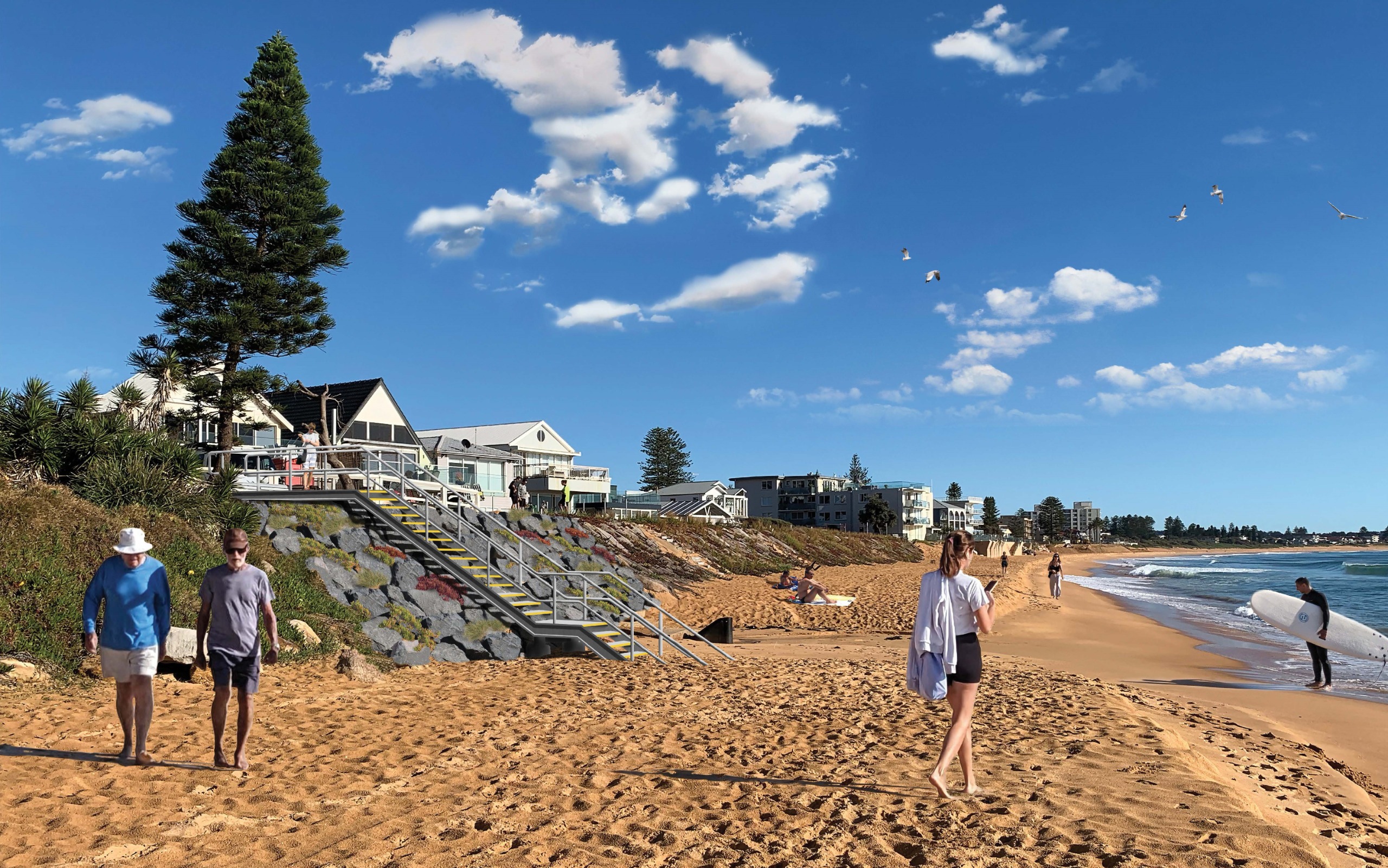
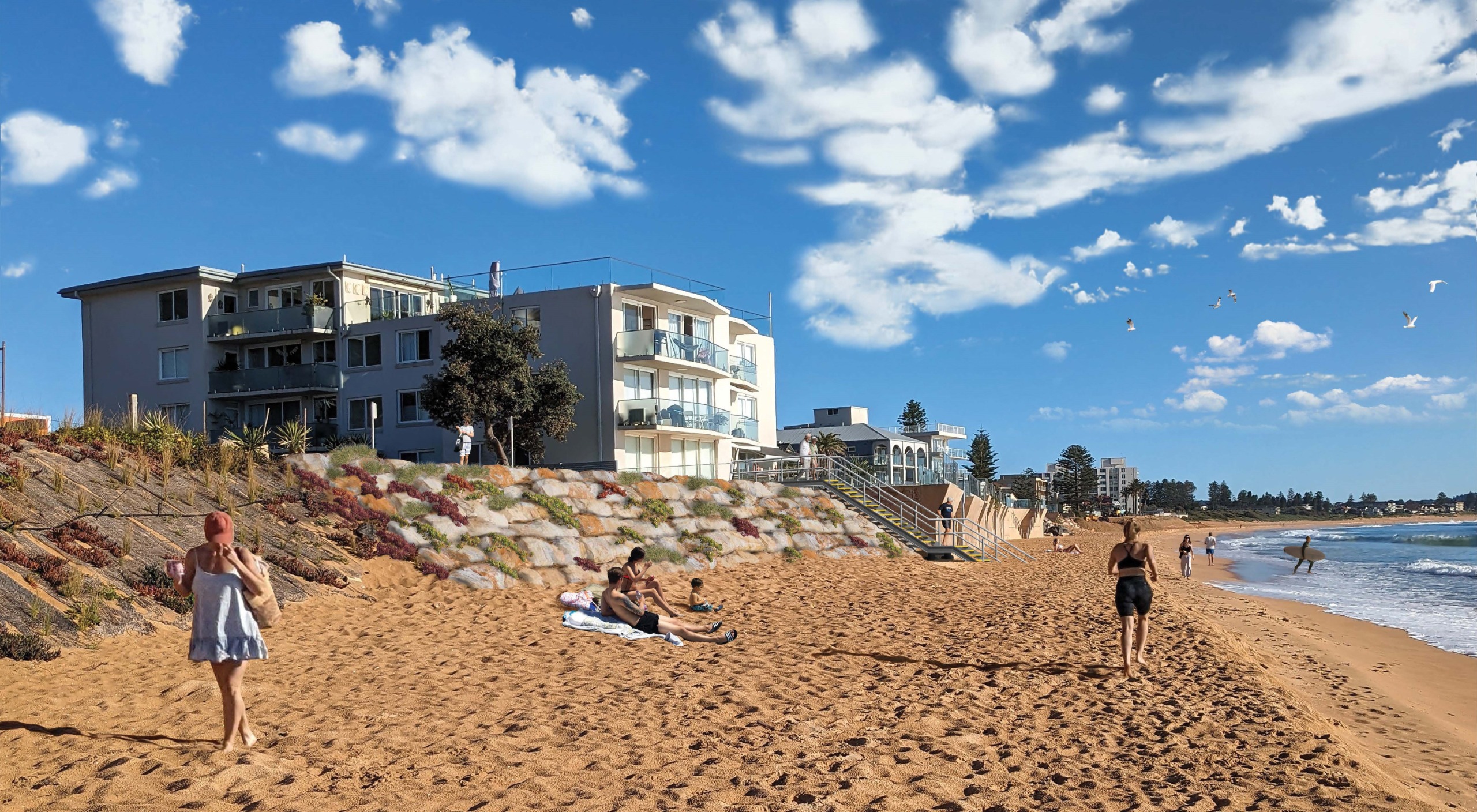
November Colours: Angophora Costata, Jacaranda, Spotted Gums; Trees In Your Streets - Pittwater
Angophora - from two Greek words, meaning 'vessel' or 'goblet', and 'to bear or carry', referring to the shape of the fruits; costata - ribbed; the capsules bear prominent ribs.
The genus Angophora is closely allied to Corymbia and Eucalyptus (family Myrtaceae) but differs in that it usually has opposite leaves and possesses overlapping, pointed calyx lobes instead of the operculum or lid on the flower buds found in those genera.
Angophora costata, or Smooth-barked Apple, is a large, wide, spreading tree growing to a height of between 15 and 25 m. The trunk is often gnarled and crooked with a pink to pale grey, sometimes rusty-stained bark. The timber is rather brittle. In nature the butts of fallen limbs form callused bumps on the trunk and add to the gnarled appearance. The old bark is shed in spring in large flakes with the new salmon-pink bark turning to pale grey before the next shedding. The leaves are dark green, lance-shaped, 6-16 cm long and 2-3 cm wide. They are borne opposite each other on the stem.
The flowers are white and very showy, being produced in large bunches on terminal corymbs or short panicles. The individual flowers are about 2 cm wide with five tooth-like sepals, five larger semi-circular petals, and a large number of long stamens. The seed capsules are goblet shaped, 2 cm long and as wide, often with fairly prominent ribs. The usual recorded flowering time is December or January, but here in Pittwater they are out by early November, while at the Australian National Botanic Gardens in Canberra the species flowers for about one month between early January and early February.
Photos; taken in Pittwater, Friday November 10, 2023:
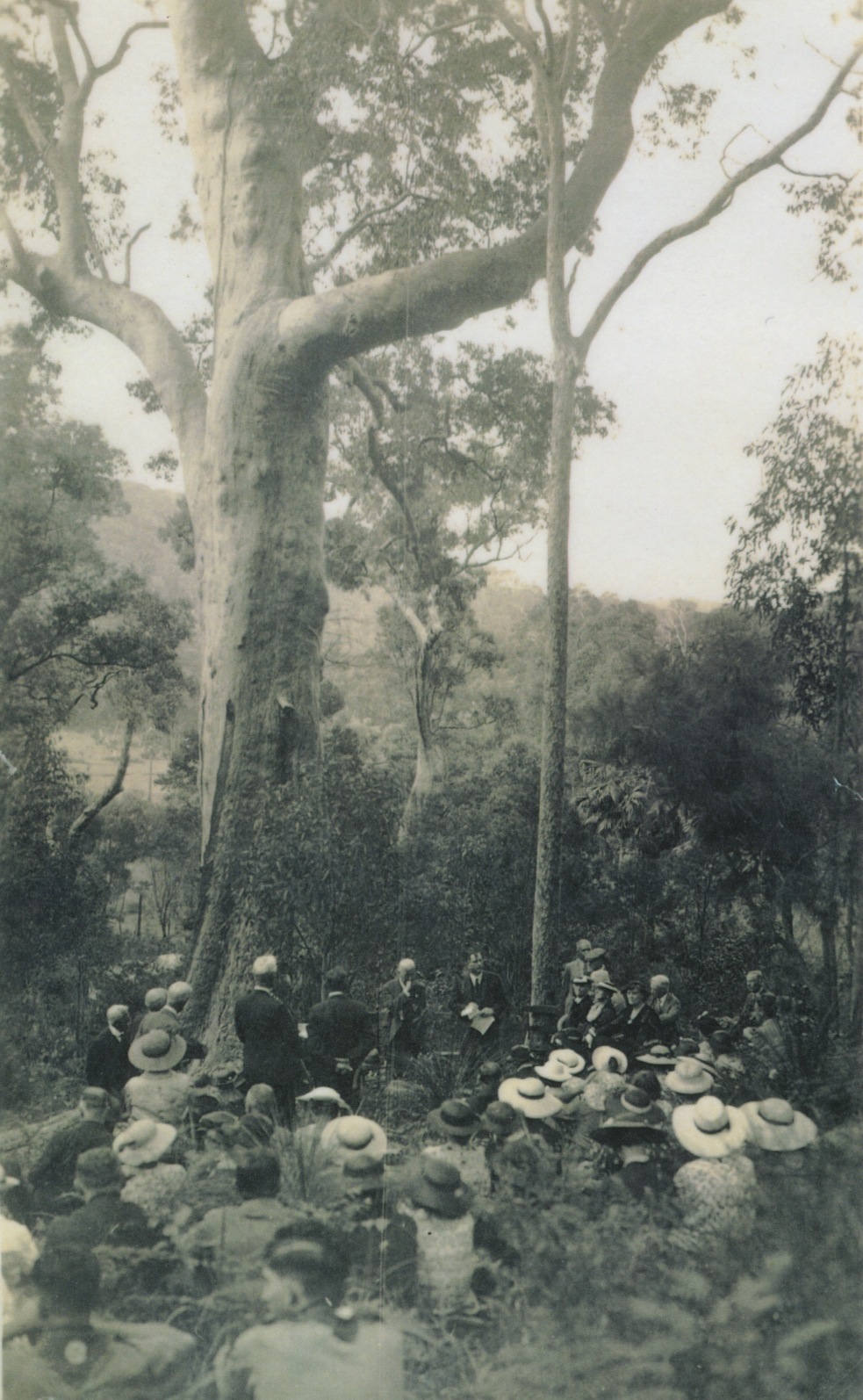
This photo shows the official opening of the Angophora Reserve on 19 March 1938 by Sir Phillip Street (KCMG). Much of the groundwork to enable the purchase of the land by the Wildlife Preservation Society in January 1937 was done by Thistle Harris. The reserve cost the Society 364 pounds 19 shillings and 7 pence (which converts to around 730 dollars!). The volunteer bush care group meet on the 3rd Sunday of each month usually at the Palmgrove Road entrance. – Geoff Searl, President of the Avalon Beach Historical Society - photo courtesy ABHS More In 'Grand Old Tree Of Angophora Reserve Falls Back To The Earth'
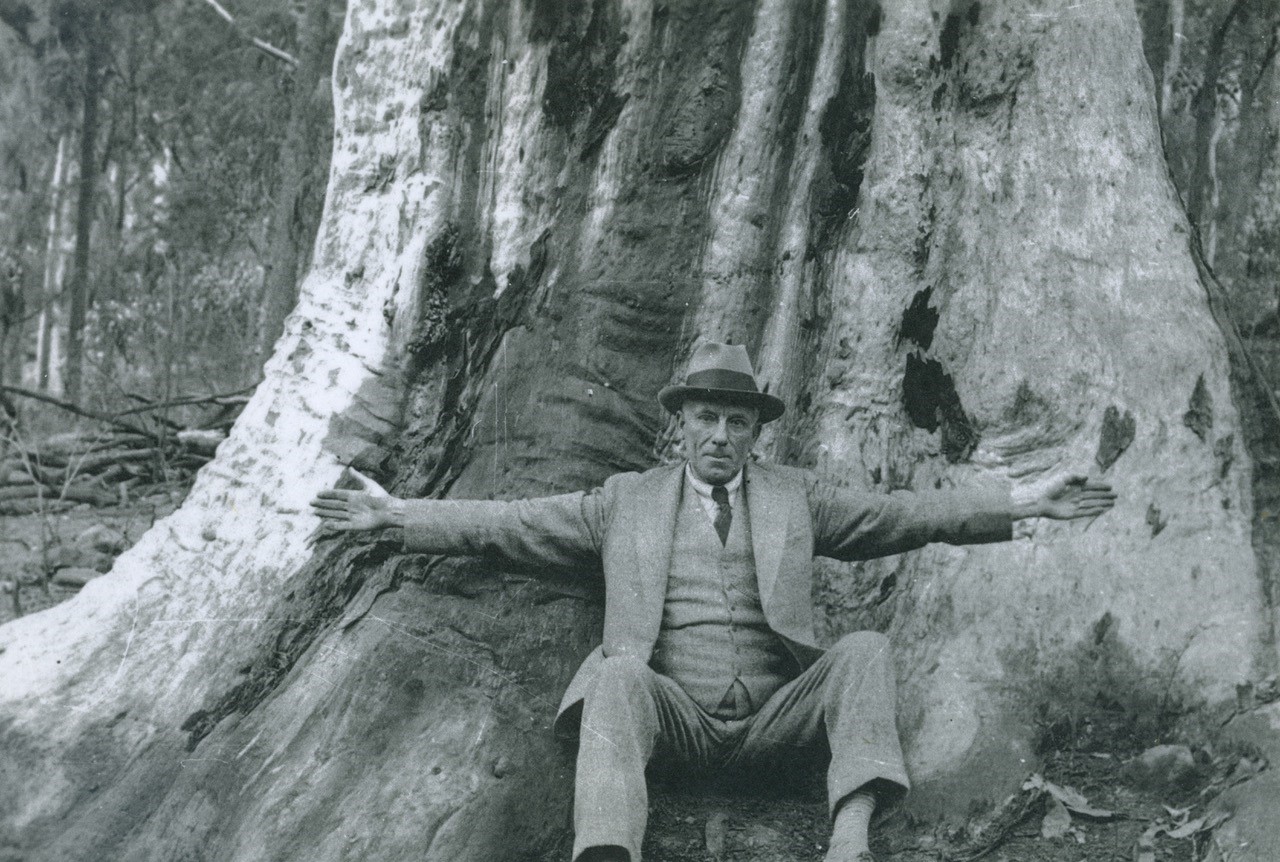
Arthur Jabez Small and the Old Girl, pre-1954 - photo courtesy ABHS - Geoff Searl OAM
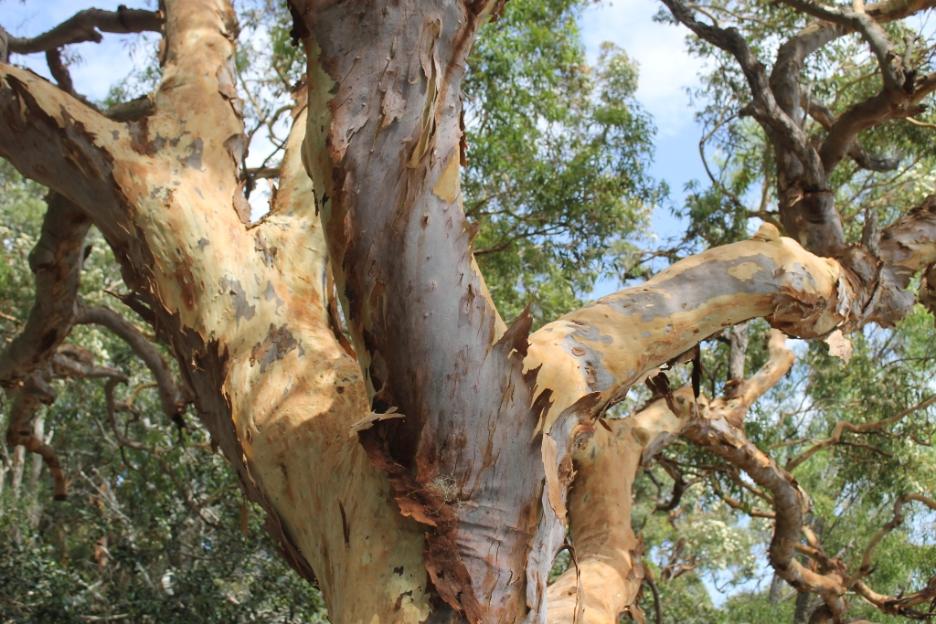
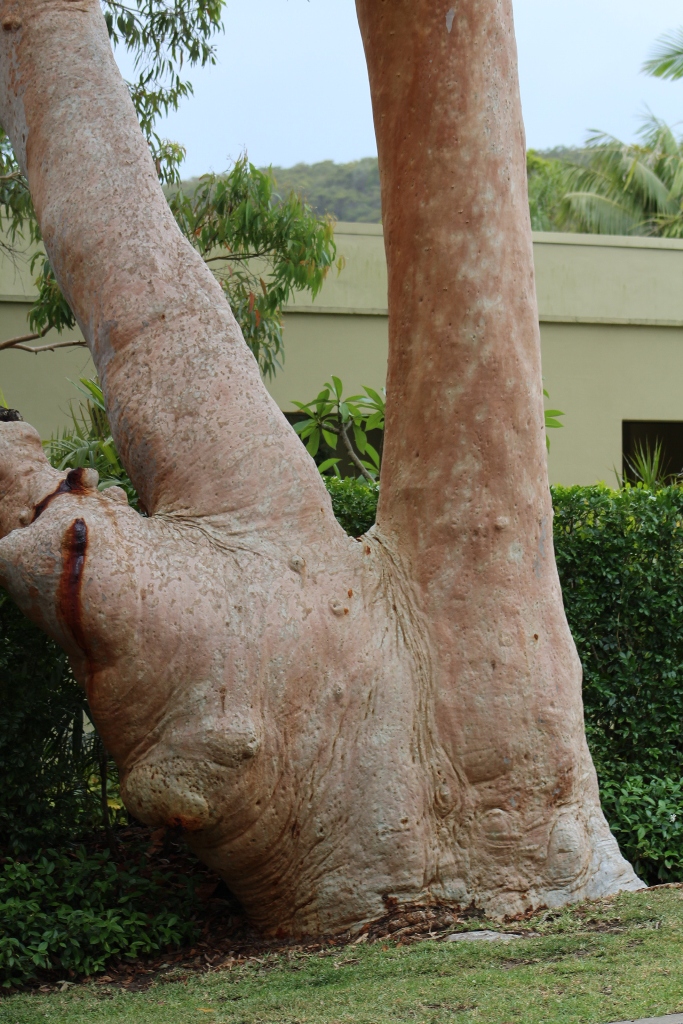
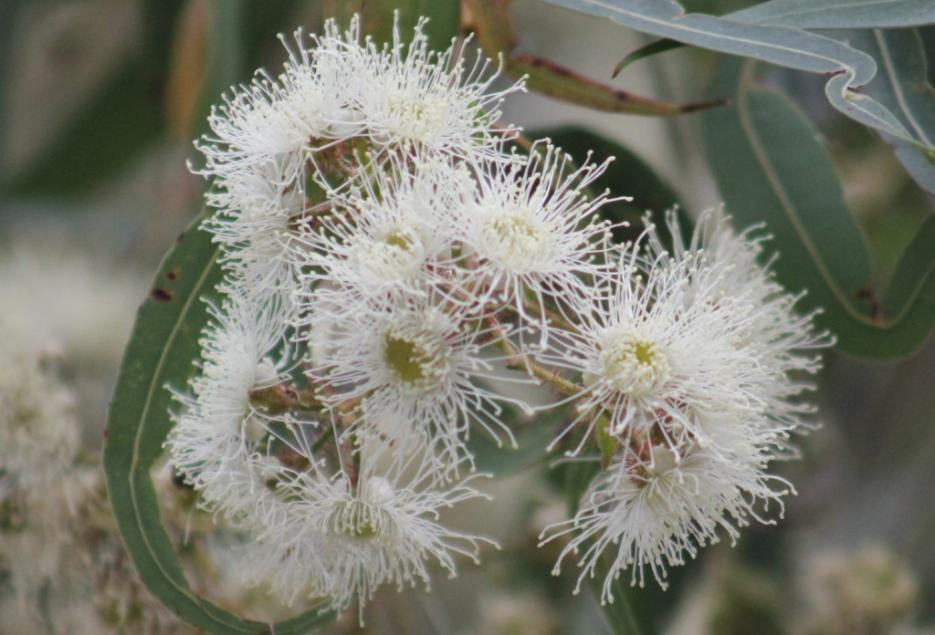
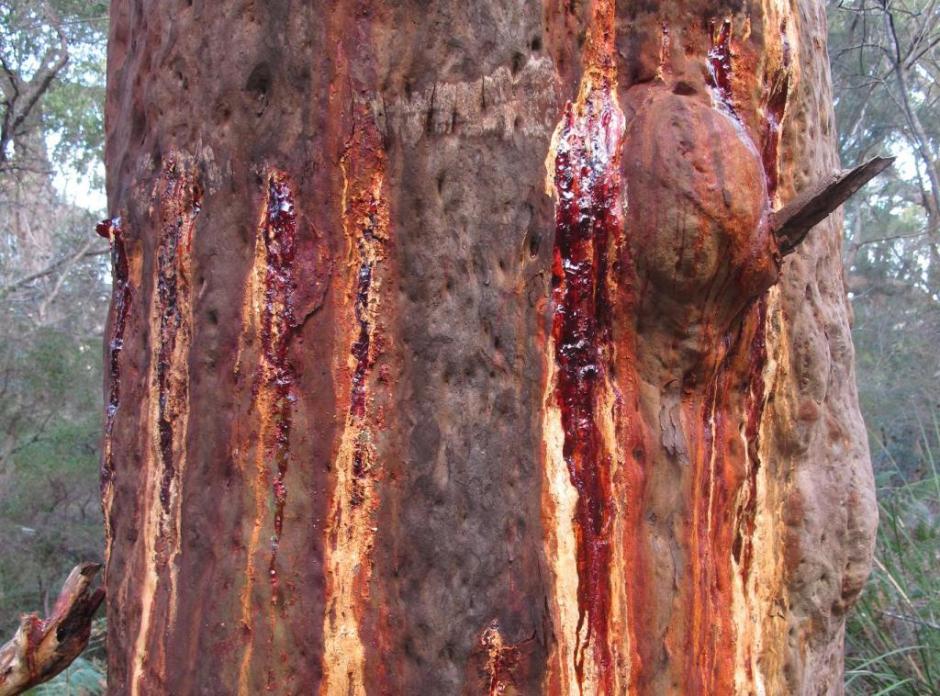
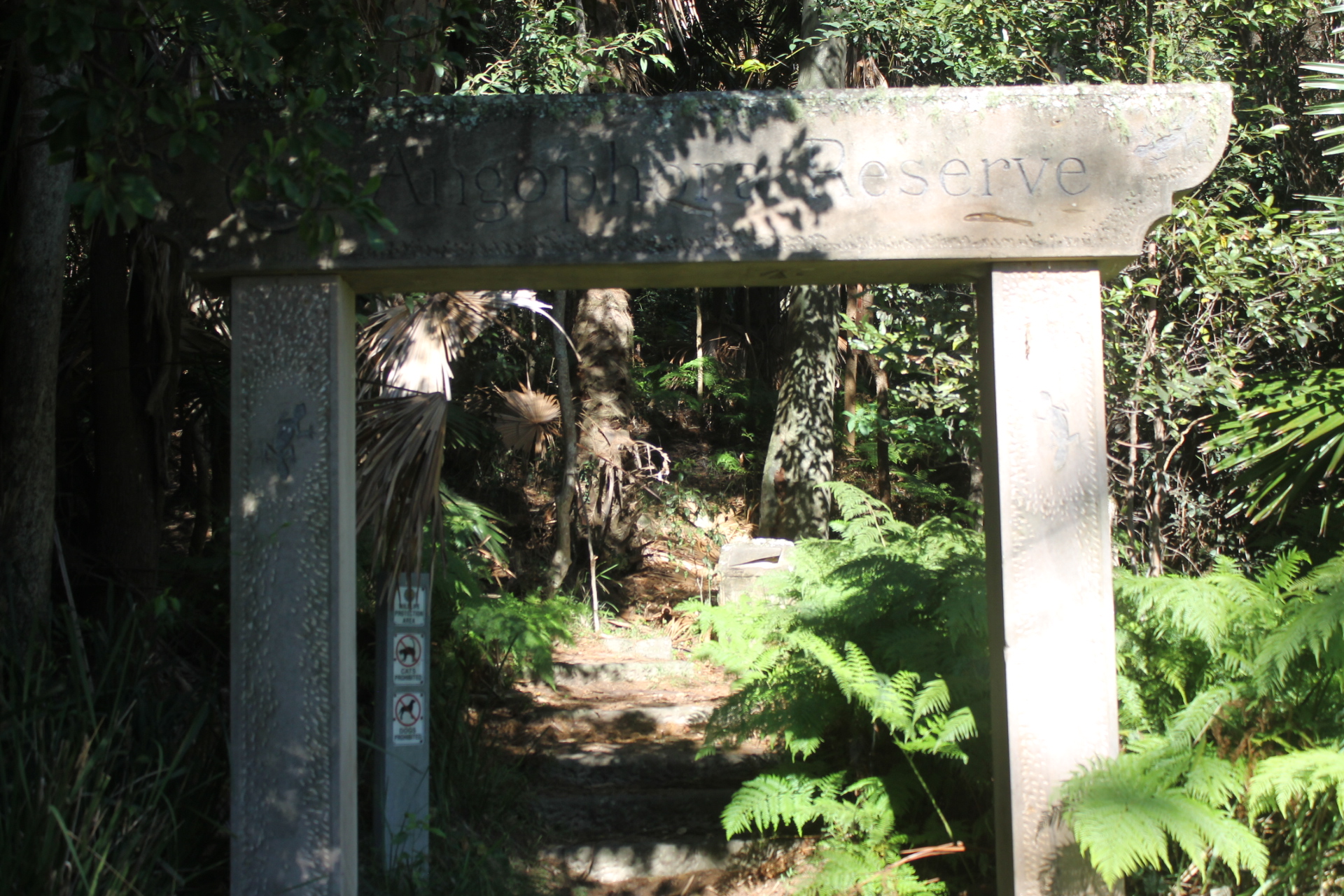
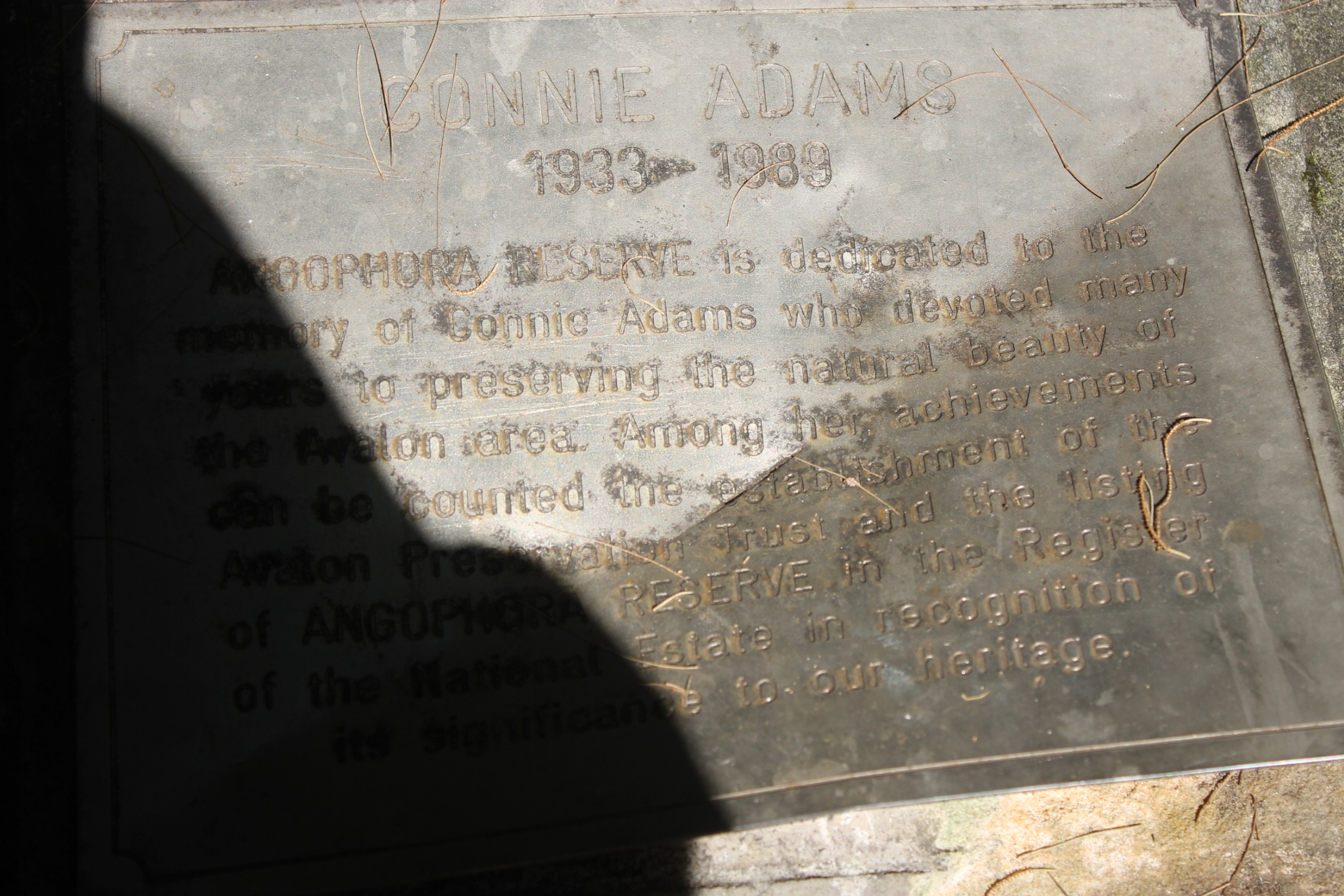
Also Flowering Now - Jacaranda
How did they get here?
The story is that Allan Cunningham a roving British botanist, with a penchant for rare and exotic plants, was so transfixed by the stunning jacarandas when he first saw them in bloom in Rio de Janeiro sometime in 1818, that he brought a specimen back to London, for the Royal Botanic Gardens at Kew. The harsh Northern Hemisphere winters meant that jacarandas could only survive within hothouses. A far milder climate, closer to its Brazilian home, was what this delicate tree really craved. So, when Cunningham was briefly appointed the colonial botanist of NSW, it’s believed he was the first person to successfully plant a jacaranda in Sydney.
Cunningham, along with many European plant-experts familiar with the jacaranda, had believed the plant to be especially difficult to grow. Cuttings would rarely flourish and more attempts to propagate the tree failed than succeeded. Gardeners would go to extraordinary lengths to get jacarandas to thrive – one of the most trusted methods, devised in 1886 by noted landscape designer Michael Guilfoyle, horticulturalist and owner of Guilfoyle’s Exotic Nursery at Double Bay, required elaborate rigs of bell jars, specially constructed ‘cold pits’ and baths of precisely warmed water. For these reasons, the handful that did manage to mature were considered the most precious and rare of trees. The Sydney Morning Herald noted in 1868 that the jacaranda planted in the Royal Botanic Gardens (which you can still visit today) “is well worth a journey of 50 miles or more to see. Its beautiful, rich lavender blossoms and its light, feathery foliage render it the gem of the season.”
However, like many species of Bignonia, while the jacaranda is incredibly difficult to grow from a cutting it propagates with ease when its freshly released seeds find just the right conditions – such as those found across Sydney in the Spring. Being a Southern Hemisphere city on nearly the same latitude as Rio, the first jacarandas to grow in Sydney felt right at home, and the descendants of that handful of original trees now flourish throughout Sydney in their hundreds. By the 1930s, the trees were so plentiful, people happily accepted that these beautiful blooms must have always been here, dusting the ground with petals, filling the spring air with scent.
In 1952, Sister Irene Haxton began giving out a jacaranda seedling to every new baby born at her hospital at Jacaranda Maternity Hospital in Woolooware. Now, every October and November, the streets of St George and Sutherland Shire are awash with purple blooms.
Photos taken November 7 and 10, 2023 in Pittwater!
Spotted Gums Changing Colours
Corymbia maculata, commonly known as Spotted Gum, is a species of medium-sized to tall tree that is endemic to eastern Australia. It has smooth, mottled bark, lance-shaped to curved adult leaves, flower buds usually in groups of three, white flowers and urn-shaped or barrel-shaped fruit.
Flowering occurs from March to September and the flowers are white. The fruit is a woody oval, barrel-shaped or slightly urn-shaped capsule 9–14 mm (0.35–0.55 in) long and 8–13 mm (0.31–0.51 in) wide with the valves enclosed in the fruit.
These trees replace their bark seasonally, but not all at once. Instead, bits of the bark are shed and new bark grows at different rates. That leaves the famous spots on their trunks (maculatus is Latin for spotted).Early in the growing season some of these spots can be a bright green before fading to tans and greys over the coming months. Many patterns can be stunningly beautiful. This bark shedding is called “decorticating” and is a normal thing.
The Pittwater and Wagstaffe Spotted Gum Forest in the Sydney Basin Bioregion is listed as an Endangered Ecological Community in NSW.
Occurs entirely within the Pittwater Local Government Area, on the Barrenjoey Peninsula and Western Pittwater Foreshores. Remnants are typically small and on private property, however there are a few remnants in Council reserves and one remnant within Ku-ring-gai Chase NP.
Threats
- Habitat loss and degradation due to urban development including encroachment.
- Encroachment from urban areas including illegal and legal tree and understorey removal, planting of exotic species and weed invasion.
- Inappropriate fire regime being a combination of lack of fire and too frequent fires due to arson and hazard reduction burns.
- Stormwater and soil erosion.
- Disturbance from recreational users, including unauthorised visitor access; rubbish dumping, illegal trails, illegal mountain bike tracks, and walkers.
- Introducing and spreading of disease including phytophthora and myrtle rust.
- Weed invasion, including multiple asparagus species, mickey mouse weed, bitou, privet, crofton weed, lantana, mixed woody weeds and garden escapes.
- Lack of knowledge about extent, composition and condition beyond the areas mapped.
Activities to assist this species and community
- Remove rubbish.
- Control stormwater and soil erosion.
- Introduce measures to control unrestricted access and/or inappropriate use.
- Manage weed infestations.
- Protect areas of habitat from clearing and further fragmentation.
- Restore degraded habitat using bush regeneration techniques.
Photos taken November 7, 2023 in Pittwater!
Careel Creek Birds: Pacific Black Duck, Royal Spoonbill
Pacific black duck: A protector Songline that runs through Pittwater
The Pacific black duck (Anas superciliosa) is a dabbling duck found in much of Australia.
The Black Duck Songline, as current Aboriginal knowledge holders confirm, travels up the South Coast from over the Victorian border to the Hawkesbury River, north of Sydney, passing through not only Pittwater but also many important cultural locations of the Yuin and Dharawal peoples of the region.
A songline is not just a map across Country. It is a celebration of the stories which make up the songline, and these stories are encompassed in the form of song. The melody stays consistent as a songline passes through different language groups and dialects along the route.
A songline is never extinguished, although the Country through which it passes may be dying because it is not being sung. This has given rise to the Aboriginal expression to “sing up Country”: refreshing the songs and the Country to which the songs belong.
The Pacific Black Duck (Anas superciliosa), is known as Umbarra to the Yuin and Wumbarra to the Dharawal. The Yuin story of Umbarra comes from Wallaga Lake near Narooma on the NSW far south coast. Umbarra is an animal hero, rather than a Creator, and is the totem and protector of the Yuin peoples from the Dreaming.
A Yuin man, Merriman, had Umbarra as his totem. When his people were in danger, Umbarra warned them so they could take refuge on what is now called Merriman’s Island in Wallaga Lake.
Umbarra became the Yuin protector, and, through kinship linkages, the bird is equally important to the Dharawal.
The Pacific black duck is mainly vegetarian, feeding on seeds of aquatic plants. This diet is supplemented with small crustaceans, molluscs and aquatic insects. Food is obtained by 'dabbling', where the bird plunges its head and neck underwater and upends, raising its rear end vertically out of the water. Occasionally, food is sought on land in damp grassy areas.
The nest is usually placed in a hole in a tree, but sometimes an old nest of a corvid is used and occasionally the nest will be placed on the ground. The clutch of 8–10 pale cream eggs is incubated only by the female. The eggs hatch after 26–32 days. The precocial downy ducklings leave the nest site when dry and are cared for by the female. They can fly when around 58 days of age.
mum with bubs
Photos; Pacific Black Duck mum and bubs + others - taken at Careel Creek, Pittwater, Friday November 10 2023. Pics: AJG/PON
Royal Spoonbill
The Royal Spoonbill (Platalea regia) also known as the black-billed spoonbill, occurs in intertidal flats and shallows of fresh and saltwater wetlands in Australia. The renowned ornithologist John Gould first described the royal spoonbill in 1838, naming it Platalea regia and noting its similarity to the Eurasian spoonbill (P. leucorodia). A 2010 study of mitochondrial DNA of the spoonbills by Chesser and colleagues found that the royal and black-faced spoonbills were each other's closest relatives.
The royal spoonbill is a large, white bird with a black, spoon-shaped bill. It is approximately 80 cm (31 in) tall, 74–81 cm (29–32 in) and a weight of 1.4–2.07 kg (3.1–4.6 lb). It is a wading bird and has long legs for walking through water. It eats fish, shellfish, crabs and amphibians, catching its prey by making a side-to-side movement with its bill.
Spoonbills form monogamous pairs during the breeding season, which extends from October to March. When they are breeding, long white plumes grow from the back of their heads and coloured patches appear on the face. The nest is an open platform of sticks in a tree in which the female lays two or three eggs. The chicks hatch after 21 days. The birds are highly sensitive to disturbance in the breeding season. In Australia, whole colonies have been known to desert their eggs after a minor upset.
Photos taken at Careel Creek, Friday November 10, 2023. Pics: AJG/PON
Shearwaters On Our Beaches: Is Monster Eddy Current Off The Coast Of Sydney May Be To Blame?
- Birdlife Australia says "wreck" events are "confronting", but not unusual
- It is suspected that stormy weather or an ocean warming event may have caused the deaths
- Some birds are being euthanised and others are being moved to safe places to recuperate
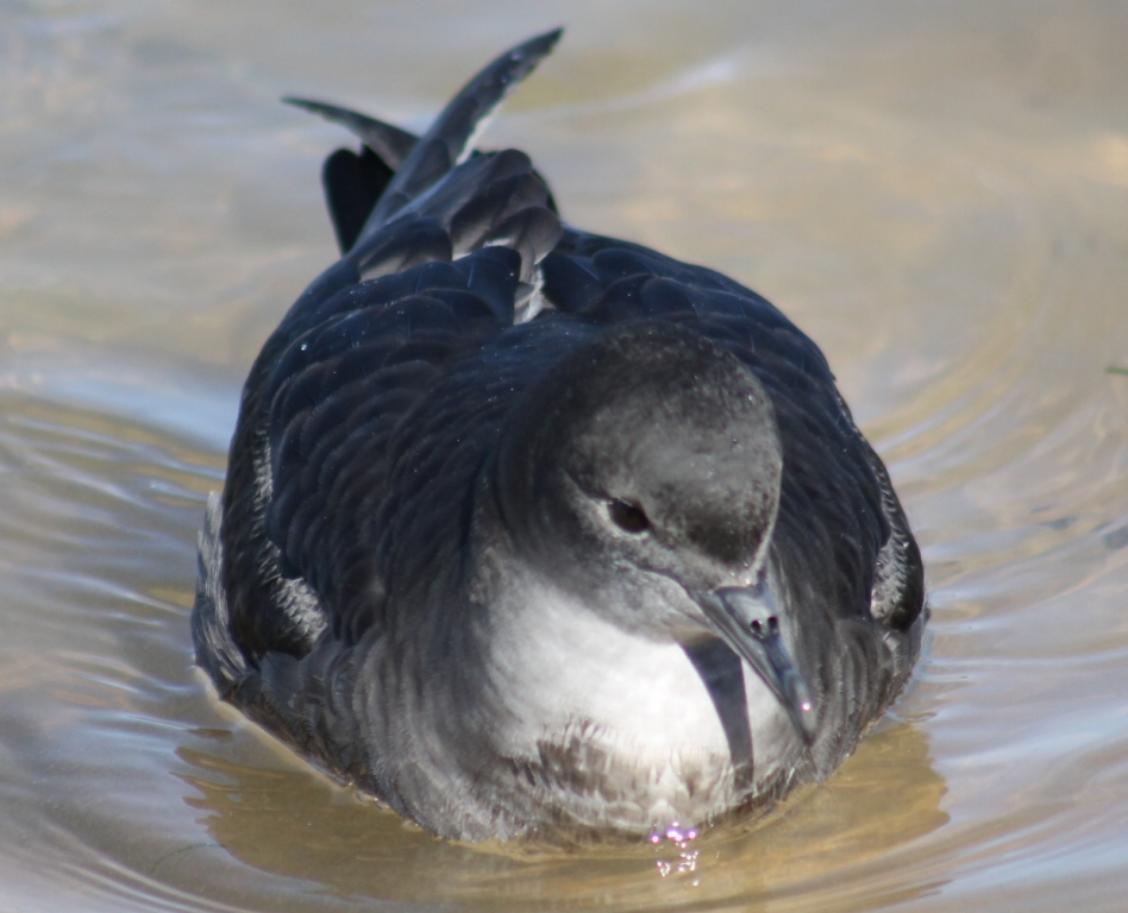
Beach-Washed Birds Now On Birdata
EPA Extends Stop Work Order In Tallaganda State Forest: Forestry Corporation Of NSW (FCNSW) Set To Kill Greater Glider Den Trees
_in_a_Eucalypt.jpg?timestamp=1699636297844)
Next Steps To Beat Plastic Pollution In NSW: Have Your Say
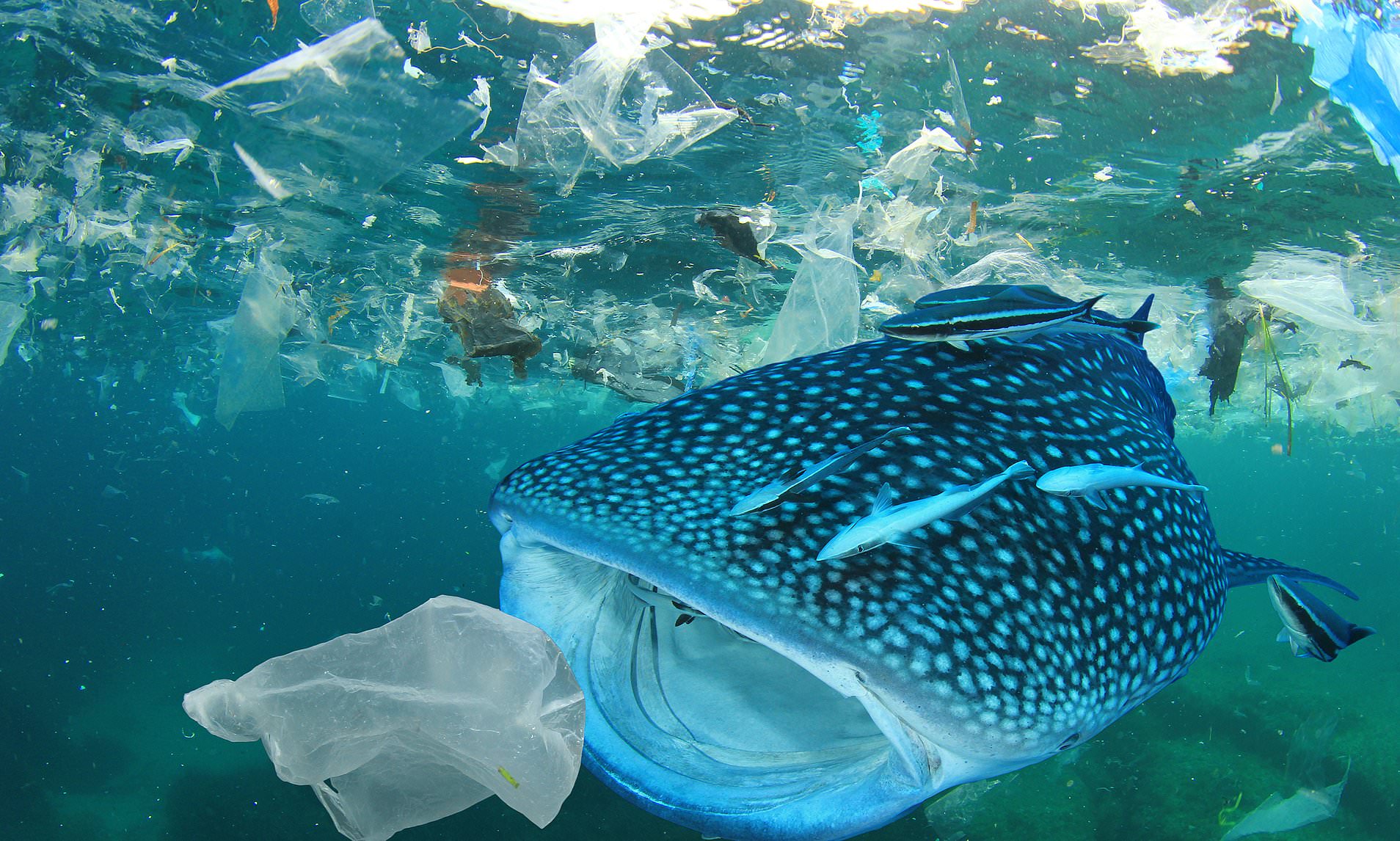
- Are frequently littered or release microplastics into the environment;
- Contain harmful chemical additives; or
- Are regulated or proposed to be in other states and territories.
- Items containing plastic such as lollipop sticks, cigarette butts, bread tags and heavyweight plastic shopping bags are some of the problematic products that could be redesigned or phased out.
EPA Publishes Results Of Investigation Into Metals In Cadia Water Tanks
Why are dead and dying seabirds washing up on our beaches in their hundreds?

In October and November, horrified beachgoers often find dead and dying muttonbirds washing up in an event called a seabird “wreck”.
Again this year, there are reports of Australia’s beautiful east coast beaches turned grim with hundreds of dying seabirds.
Here’s what we do and don’t know about seabird wrecks, and what you can do if you come across one.
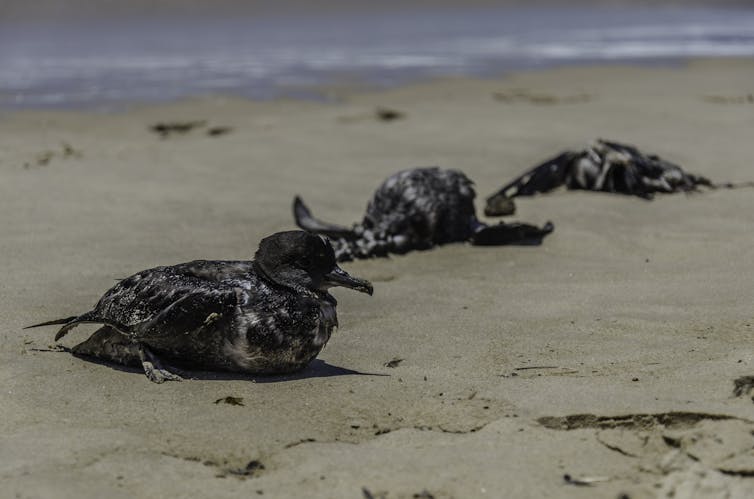
Wrecks Are Becoming More Common
Millions of short-tailed shearwaters (Ardenna tenuirostis), commonly known as muttonbirds, return to southern Australia from the Arctic each spring – a round trip of up to 35,000km.
Not all birds survive their long migration. The fit and healthy largely return in late September and October. The less fit lag behind. To some extent, deaths are natural.
Muttonbirds keep a strict timetable and, while failed migrants can wash up any time during spring, mass mortalities can occur from mid-October to November. Muttonbird wrecks have happened on rare occasions since time immemorial, but are becoming more common.
The many ideas about what is causing wrecks range from storms and overfishing to plastic, blue-green algae and irradiated water from Fukushima.
University of Tasmania researchers have studied the muttonbirds for decades. While we can’t pinpoint the exact cause for every wreck, we can explain what we know and eliminate the unlikely culprits.
What We Know
When muttonbird wrecks occur, the casualties are starving. These birds weigh only half their healthy body weight. The factors leading to this starvation start before they reach Australia.
Muttonbirds chase an eternal summer. After returning to Australia from the North Pacific, they lay eggs in late November on Australia’s southern islands and raise a single chick. When the weather cools in April the adults depart on a great migration north where the sea ice is melting on the Bering Sea ahead of an Arctic summer.
Ecosystem changes in the sub-Arctic, where the birds fatten up over the northern summer, can lead to death on Australian beaches.
Many marine animals share the North Pacific Ocean with muttonbirds. Among them are several salmon species, which compete with muttonbirds and other marine wildlife for the same zooplankton prey – the abundant small animals floating in the surface waters of the ocean.
The pink salmon (Oncorhynchus gorbuscha), in particular, is central to the muttonbirds story. You may have seen them in documentaries, being eaten by bears on the annual “salmon run”. You may also eat them yourself, as tinned salmon.
Pink salmon live hard and fast. Their life cycle from hatching to spawning lasts two years. However, wild numbers couldn’t satisfy consumer demand and by the mid-20th century the species was in trouble.
To take pressure off wild fish stock and meet soaring demand, salmon hatcheries now release billions of fry, many more than would exist through nature, into the North Pacific Ocean. Pink salmon numbers, both hatchery and wild fish, have more than doubled in recent decades.
Increased salmon numbers have caused crashes in zooplankton in odd-numbered years, when most pink salmon reach spawning size and are 25 times more abundant than in even-numbered years. The effect is so strong that even healthy breeding muttonbirds arriving in Tasmania are lighter most odd-numbered years.
Other factors are also affecting zooplankton. The Arctic seas are among the fastest warming on Earth. Marine heatwaves have been causing shifts in where and when zooplankton occur, and how large they grow.
When seabirds on a strict schedule arrive to feed, they can miss the zooplankton buffet. This has led to devastating wrecks for Arctic and sub-Arctic seabird species, including muttonbirds.
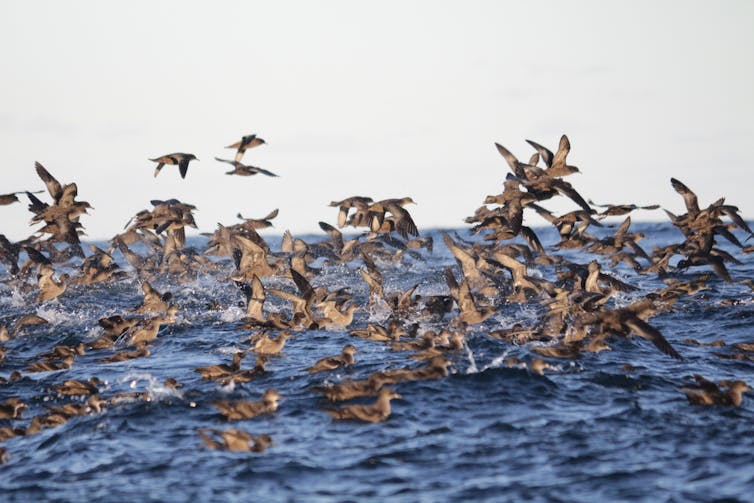
In 2013, millions of muttonbirds starved along Australia’s coast from K'gari/Fraser Island to Tasmania. Though we don’t know the exact cause, this was likely influenced by a double whammy: competition for food with salmon and a severe marine heatwave called “the blob”.
But what about the other causes? Examination of wrecked birds rules out plastic, blue-green algae and irradiated water from Fukushima as causes of death.
Birds are already in poor condition when they arrive. Storms or strong winds might push an already poorly muttonbird over the edge, but are generally not the cause of its poor condition. People often find muttonbirds after storms because onshore winds blow them from the sea onto beaches.
What Should I Do If I Find A Muttonbird?

If a muttonbird is too weak to fly, sadly it’s unlikely to recover.
If you want to give them a chance, though the odds are low, contact a specialist seabird rescue group. Seabirds have very specific care needs. Taking one home or feeding it, while well intended, may cause more harm than good.
If you find more than a few along the beach, you can report the wreck by emailing the author or contacting the University of Tasmania. Note the time, date, location and number of birds per kilometre.
If you find a muttonbird (or any bird) with a metal ring on its leg, please report the number to the Australian Bird and Bat Banding Scheme.
What If I Find Other Dead Seabirds Or Waterbirds?
There’s another reason to watch out for unusual bird deaths this summer. A deadly bird disease has a high probability of reaching Australia’s shores. High pathogenicity avian influenza (HPAI) has killed millions of birds worldwide, including seabirds.
The disease could enter Australia if carried by birds, including muttonbirds, migrating from the Northern Hemisphere (where HPIA is infecting wild bird populations) to Australia.
If you find an unusual number of sick or dying seabirds, shorebirds or waterbirds, report the incident to Wildlife Health Australia.![]()
Lauren Roman, ARC DECRA Fellow, Institute for Marine and Antarctic Studies, University of Tasmania
This article is republished from The Conversation under a Creative Commons license. Read the original article.
A monster eddy current is spinning into existence off the coast of Sydney. Will it bring a new marine heatwave?
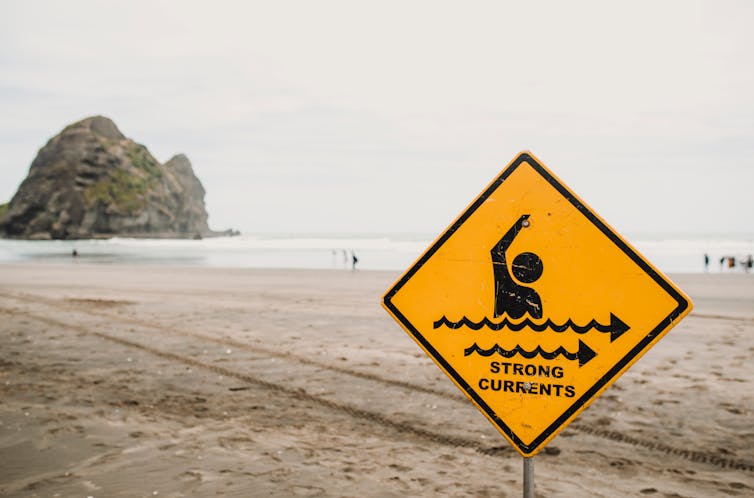
Right now, there’s something big spinning off the coast from Sydney – a giant rotating vortex of sea water, powerful enough to dominate the ocean currents off south-eastern Australia.
Oceanographers describe these spinning water bodies as “eddies” – but they’re not the small eddy currents you see in creeks or rivers. Ocean eddies are enormous. They’re usually hundreds of kilometres across (100–300km), up to 2km deep and can be visible from space.
It turns out these eddies drive change underwater by spawning marine heatwaves. Our new research demonstrates the link between a warm ocean eddy and a record-breaking marine heatwave which struck off Sydney from December 2021 to February 2022.
Now it’s happening again. An even bigger eddy is forming about 50km off Sydney. We have just returned from a 24-day research voyage on CSIRO’s research vessel RV Investigator to explore this monster eddy.
Our estimates suggest this 400km wide beast holds 30% more heat than normal for this part of the ocean. Its currents are spinning at 8km per hour. And the temperatures deep underwater are up to 3°C above normal. If it moves close to shore, it could trigger another coastal marine heatwave.
How Can An Eddy Current Make A Heatwave?
Eddies are the ocean equivalent of storms in the atmosphere. Like weather patterns, they can be warm or cold. But ocean eddies can shape the ocean’s patterns of life.
Warm eddies are like ocean deserts with little life, while cold eddies are typically much more productive. That’s because they draw up nutrients like nitrogen and phosphorous from the deep sea, which become food for plankton.
Just as storms can in the atmosphere, ocean eddies can drive extreme “ocean weather”. That’s because warm eddies can bring in masses of warm water and keep it there for months. Sea life is often very finely attuned to temperature, so a sudden heatwave like this can heavily impact ecosystems.
It’s important to better understand how eddy currents grow, move and decay better. That’s because they can store large amounts of heat and can temporarily increase coastal sea levels.
What we do know is that warm eddies along Australia’s east coast can be fed by the East Australian Current when it becomes unstable. The current wobbles back and forth until eventually the wobbles form a coherent circle – an eddy – or adding to an existing one. It’s like a garden hose thrashing around on the grass when the flow is too great. These unstable currents can be small, on the kilometre scale, or huge.
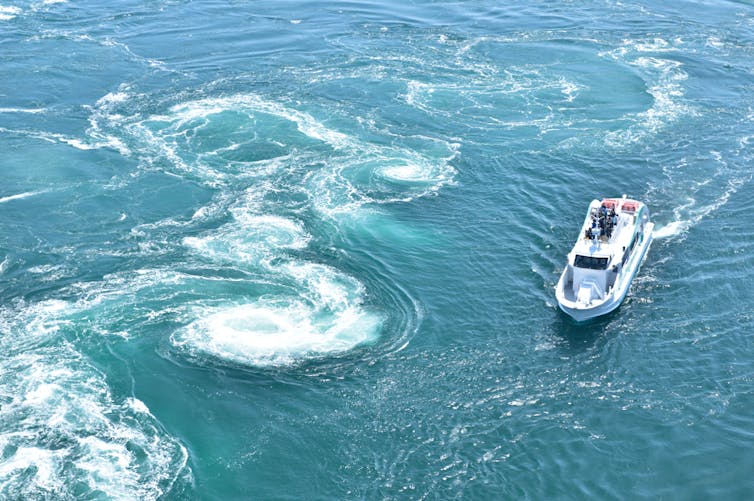
Our research pinpointed the root cause of the 2021 marine heatwave off Sydney. A large warm eddy formed. But it couldn’t spiral away into deeper waters, because there were cold eddies to the north and south preventing it. That’s very similar to what can happen in the atmosphere, where a high pressure system can be held in place by other weather systems.
Now, it looks as if history is repeating.
Over the past month, an enormous eddy – fully 400km wide and 3km deep – has been spinning up just off southeastern Australia. It’s being fed by the warm East Australian Current, which brings warm water from the tropics down to more temperate waters. This eddy is bigger and warmer than most eddies in the region, especially at this time of year. It has been growing over the past month, and is pushing up against cold waters to the south. Where the two systems meet there are very strong temperature differences – up to 5°C over just 4km.
You can get some insight into how eddy currents behave from satellites.
Our trip on the research vessel RV Investigator made it possible for us to grasp how this powerful current was behaving – in three dimensions.
We also released drifters, GPS-tracked buoys which float around the eddy centre in a massive circle. Some have been carried more than 2,000km in the last month, passing where they originally started. Others have escaped the eddy and headed east into the Pacific.
These sensors and instruments have given us vital information. Now we know the water in the eddy is flowing at a fast walking pace, around 8km per hour. And we know that while the currents within the eddy are rotating quickly, the eddy itself has remained fairly stationary off the NSW coast, growing with warm waters from further north.
We also deployed five diving Argo floats. Satellite data shows us surface temperatures in the eddy have hit 23°C, two degrees above average for a month. But Argo floats show us the temperatures are even more extreme 500m below the surface, more than 3°C above average.
What happens to eddies? Like atmospheric systems, these are effectively heat engines. They transport heat to new areas as they whirl in the ocean. While they hold heat a long time, eventually it’s lost to the atmosphere and through mixing at the edges of the current. Eventually, they disappear.
But as we head into summer, the mega eddy is unlikely to go anywhere. If it moves towards the coast, where marine life is concentrated, we will see water temperatures spike – and possibly, underwater disaster for many species.
We would like to thank the RV Investigator’s Master, Captain Andrew Roebuck, Deck Officers and crew and the CSIRO technical staff.![]()
Moninya Roughan, Professor in Oceanography, UNSW Sydney; Amandine Schaeffer, Senior lecturer, UNSW Sydney; Junde Li, Postdoctoral research associate, and Shane Keating, Associate Professor, UNSW Sydney
This article is republished from The Conversation under a Creative Commons license. Read the original article.
Upcoming Workshop With Permaculture Northern Beaches + 2023 AGM + 2023 Raffle
 Gardening for a Long Hot Summer
Gardening for a Long Hot Summer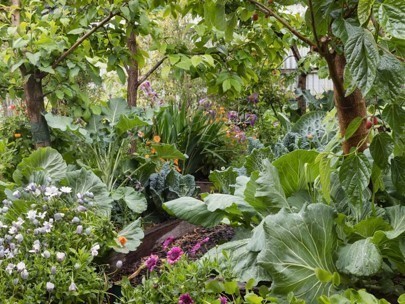
Pet Cat Containment A Vital Step To Protect NSW’s Wildlife: Calls For Companion Animals Act Amendments
- Amend the NSW Companion Animals Act 1998 to enable local governments to enforce anti roaming laws for pet cats at a local level.
- Allocate a minimum of $9 million to fund compliance, education, desexing, identification and registration programs.
- Encourage local governments to develop companion animal management plans.
- Develop a state-wide web resource for pet owners.
- Streamline pet identification and registration processes.
- Make desexing mandatory state-wide.
- Collectively, roaming pet cats kill 546 million animals per year in Australia - 323 million of these are native
- In the Greater Sydney area, there are approximately 1 million pet cats and roaming pet cats kill 112 million animals per year - 66 million of these are native
- 71% of all pet cats in Australia are able to roam, and 78% of these roaming cats hunt
- 85% of the animals killed by pet cats are not brought home
- On average, each roaming, hunting pet cat kills more than three animals every week - for a total of 186 animals per year. This number includes 110 native animals (40 reptiles, 38 birds and 32 mammals).
- Hunting pet cats kill 30-50 times more native animals per square kilometre in suburbs than feral cats kill per square kilometre in the bush! This is because pet ownership allows inflated density: While feral cats kill 4x more animals per year, there are between 54 and 100 roaming and hunting cats per square kilometre in suburbs compared to only one feral cat for every 3-4 square kilometres in the bush.
- Pet cats kill 6,000 to 11,000 native animals per square kilometre each year in urban areas
- When cats prowl and hunt in an area, wildlife have to spend more time hiding or escaping. This reduces the time spent feeding themselves or their young, or resting.
- An analysis by the Biodiversity Council, Invasive Species Council and Birdlife Australia on the impact of roaming pet cats nationwide is available here.
- Whether or not you have a pet cat, you can help us protect native wildlife and keep pet cats safe by pledging support for better management of roaming pet cats by governments across Australia. This includes ensuring all states and territories have laws that facilitate and promote mandatory desexing, microchipping and 24/7 pet cat containment.
- If you are a cat owner, there are many things you can do to help keep pets happy and wildlife safe, but the most important thing is to keep your cat securely contained at home or on a leash at all times just like a pet dog. This will keep them safe from injury and disease and protect native wildlife in your local neighbourhood. You can transition your cat to a contained lifestyle by following this helpful guide from RSPCA. Responsible owners can also ensure pet cats are desexed, microchipped and registered.
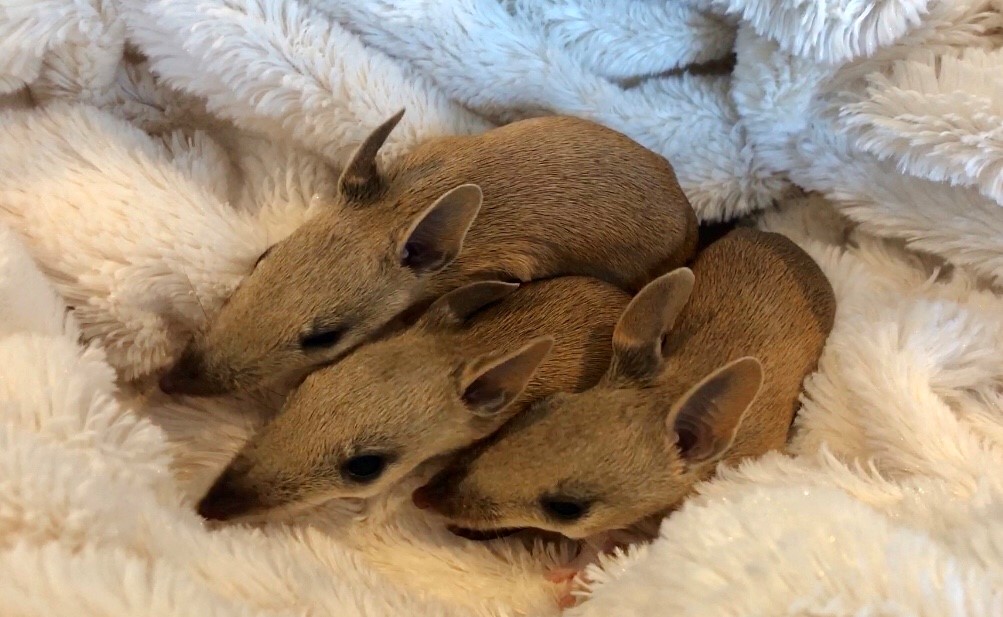
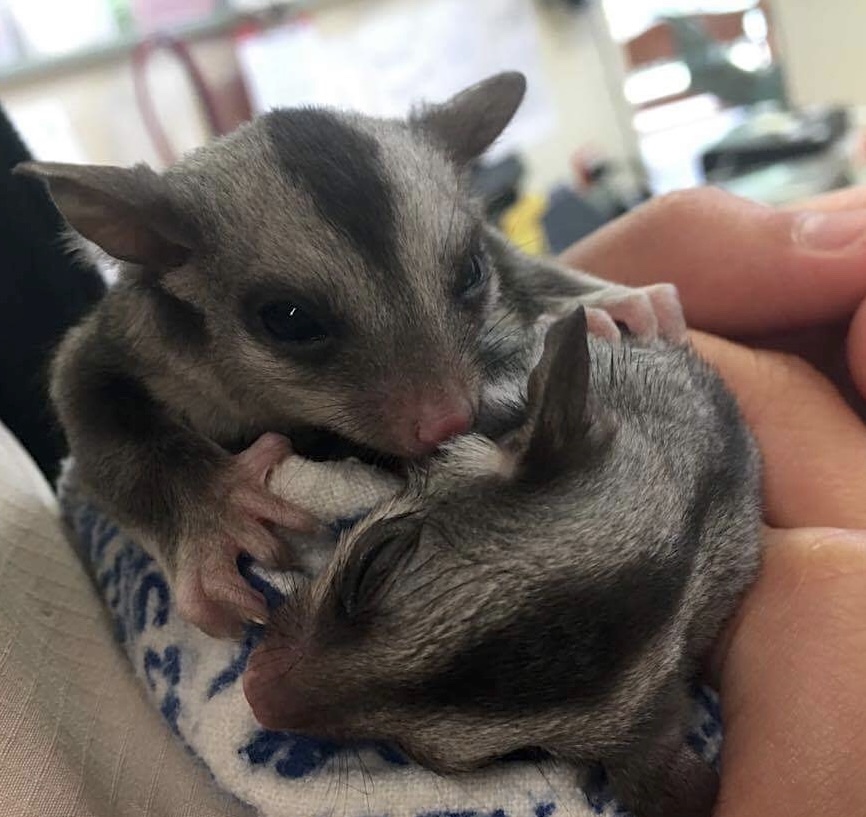
Wakehurst Parkway Update: REF For Proposed Works Available - Feedback Closes December 6
Sydney Local Native: Pittwater Edition Published
- average maximum height and width
- a description of the plant's form
- flower colour and flowering season
- an overview of the plant's best features
- its preferences for soil, water and light
- where it is naturally distributed.

Murray-Darling Bill Needs To Go Much Further To Deliver Real Water To Rivers And Justice For First Nations
$54.6 Million Investment To Clean Up Contaminated Sites Across The State
- Site investigations and remediation of contamination in buildings, soil and water at the former Bathurst Gasworks site which operated from 1888 until 1987.
- Dealing with lead contamination on Crown land sites at Captains Flat, where a multi-agency taskforce has been working on lead abatement plans after elevated lead levels were discovered from the former Lake George Mine which operated from 1882 until 1962.
- Remediation of the former Dural sandstone quarry which ceased in the early 2000s. More than 214 tonnes of waste have already been removed but further work is required to deal with landslip issues and contaminated soil.
- Remediating contamination and dealing with land stabilisation at Quarry Lane at Dural.
- Clean-up work on the former Empire Bay Marina site on the Central Coast. which has been declared significantly contaminated by the EPA.
- Dealing with legacy asbestos pollution on the Walka Water Works reserve at Oakhampton Heights near Maitland.
Please Look Out For Wildlife During Heatwave Events

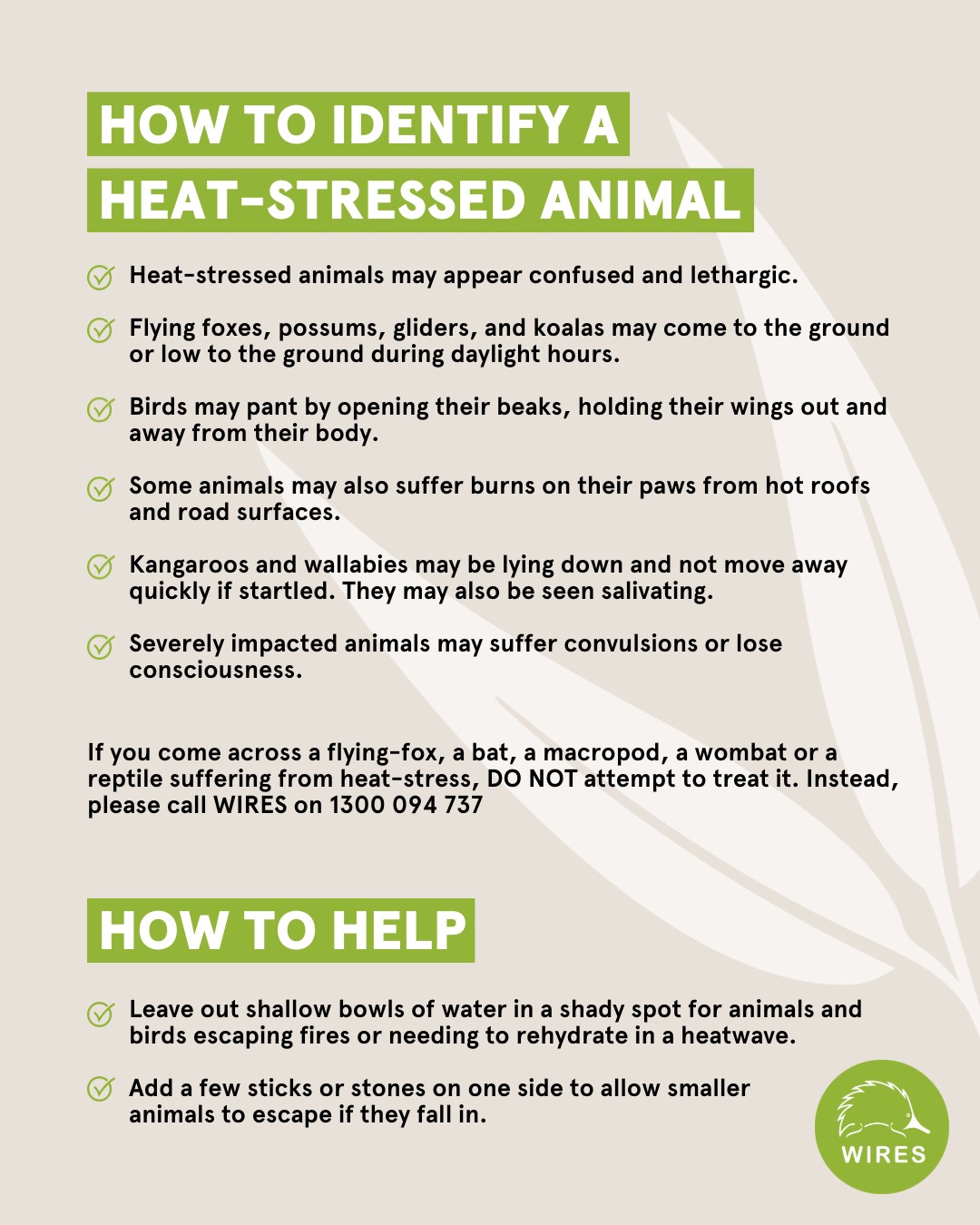
AER Releases Social Licence For Electricity Transmission Directions Paper
- What expectations should be held of transmission businesses in undertaking community engagement
- What outcomes need to be achieved from engagement
- When and how social licence issues can be factored into regulatory tests for the approval of and recovery of cost for new transmission development
- What evidence is needed to justify transmission network expansion and associated expenditure.
- clearly identify the information that is the subject of the confidentiality claim
- provide a non-confidential version of the submission in a form suitable for publication.
Bushwalk Fundraiser
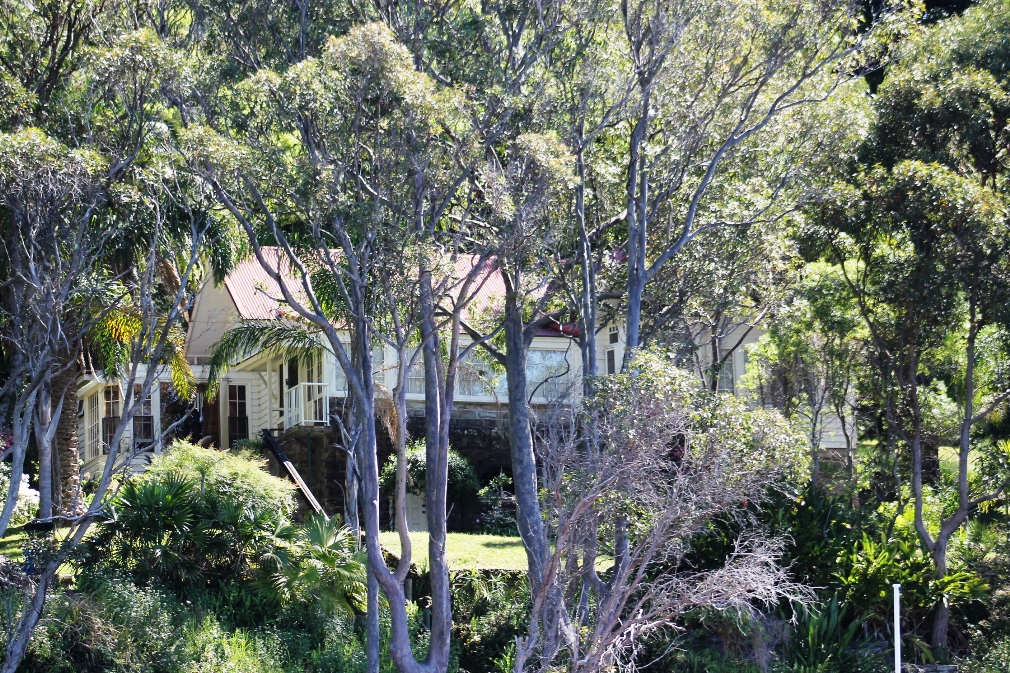
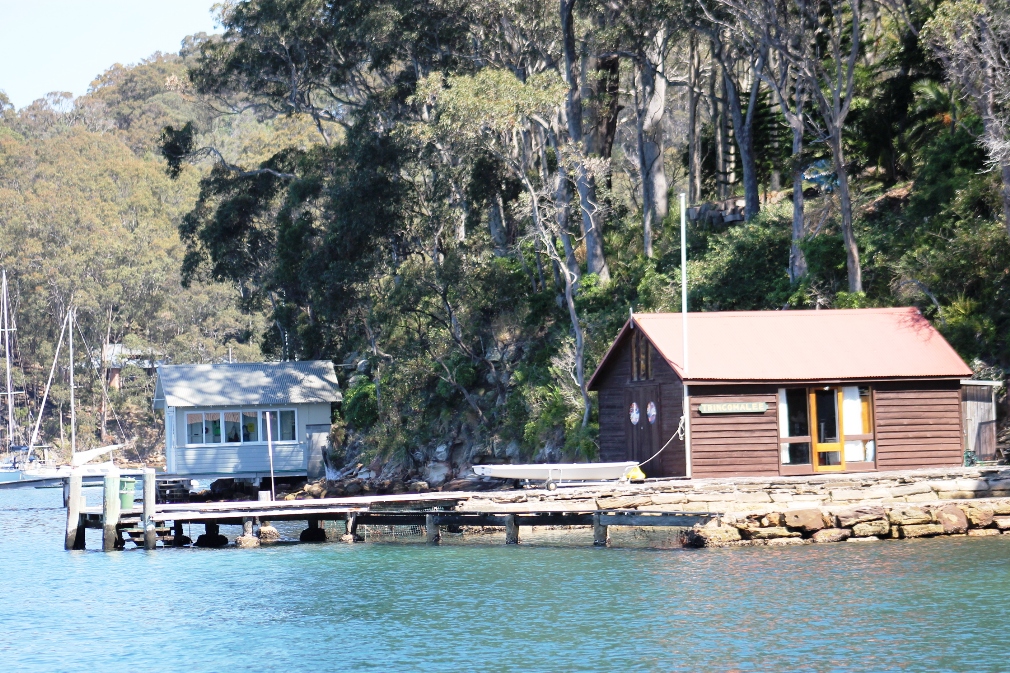
- Friday 8 December
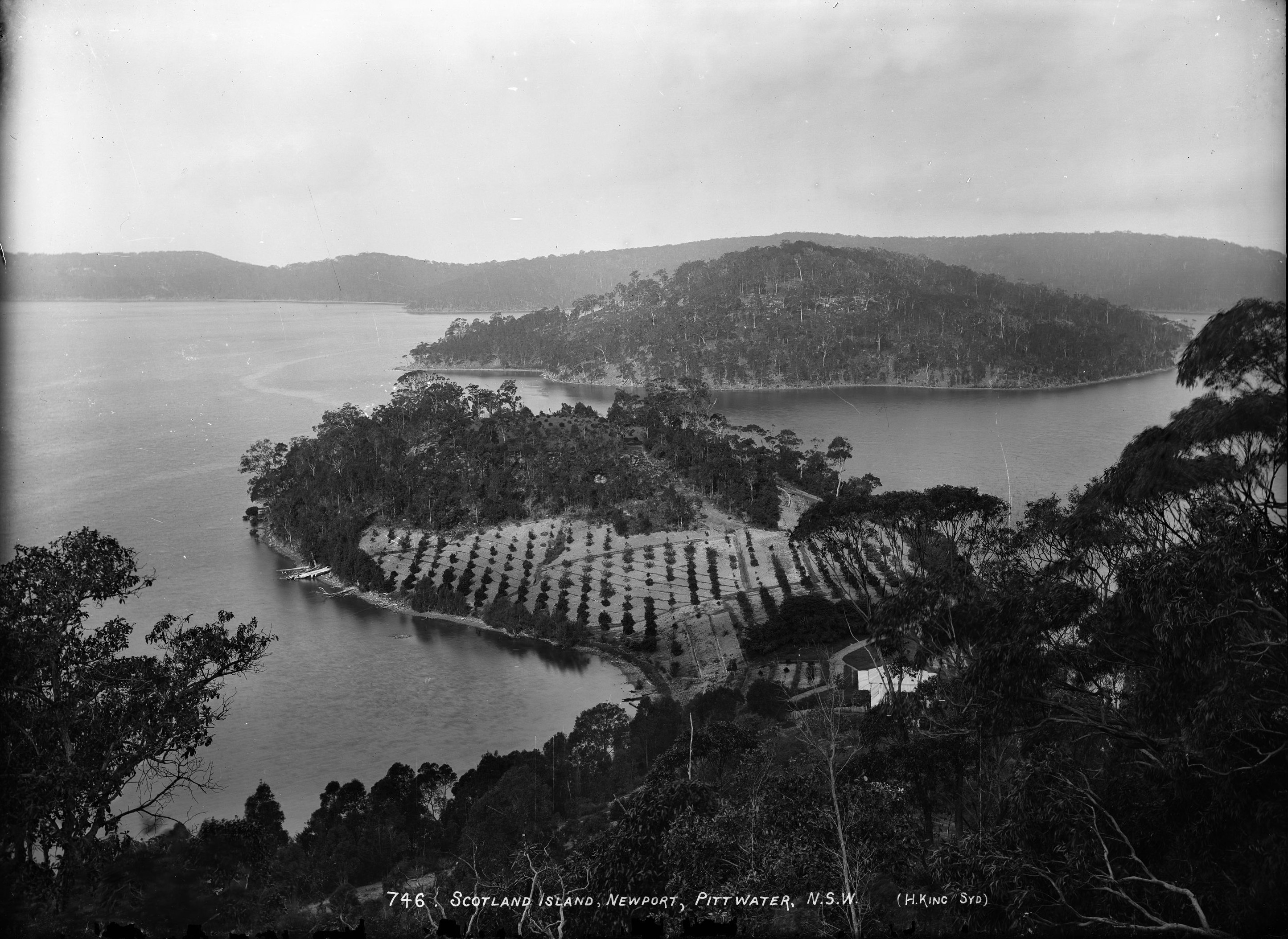
'Scotland Island, Newport, Pittwater, N.S.W.', photo by Henry King, Sydney, Australia, c. 1880-1886. and section from to show cottage on neck of peninsula at western end with no chimneys through roof. From Tyrell Collection, courtesy Powerhouse Museum
Palmgrove Park Avalon: New Bushcare Group
 Palmgrove Park Avalon is a remnant of the Spotted Gum forest that was once widespread on the lower slopes of the Pittwater peninsula. This bushland’s official name and forest type is Pittwater and Wagstaffe Endangered Ecological Community, endangered because so much has been cleared for suburban development. Canopy trees, smaller trees and shrubs, and ground layer plants make up this community. Though scattered remnant Spotted Gums remain on private land, there is little chance of seedlings surviving in gardens and lawns. More information HERE
Palmgrove Park Avalon is a remnant of the Spotted Gum forest that was once widespread on the lower slopes of the Pittwater peninsula. This bushland’s official name and forest type is Pittwater and Wagstaffe Endangered Ecological Community, endangered because so much has been cleared for suburban development. Canopy trees, smaller trees and shrubs, and ground layer plants make up this community. Though scattered remnant Spotted Gums remain on private land, there is little chance of seedlings surviving in gardens and lawns. More information HERE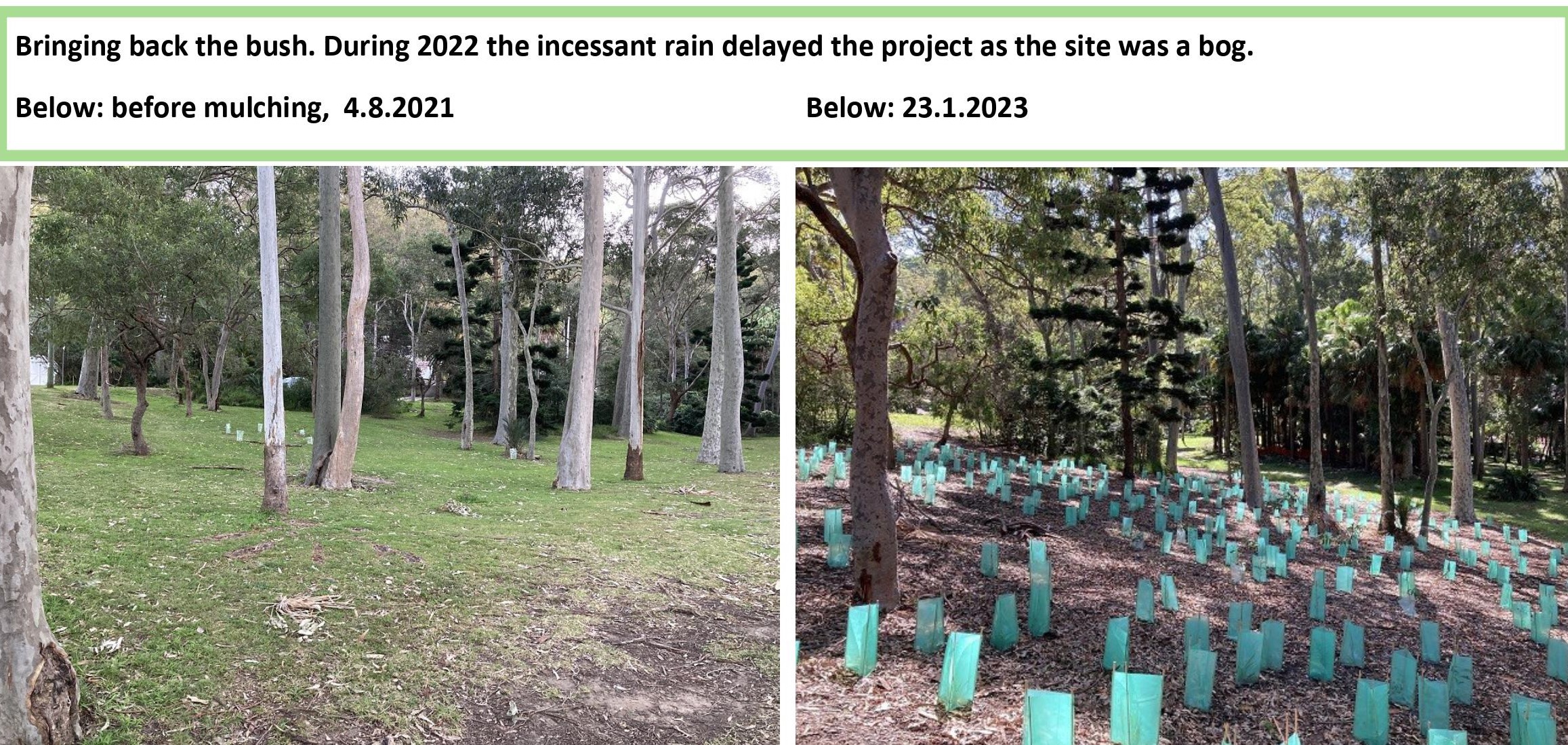
PNHA Guided Nature Walks 2023
Our walks are gentle strolls, enjoying and learning about the bush rather than aiming for destinations. Wear enclosed shoes. We welcome interested children over about 8 years old with carers. All Welcome.
So we know you’re coming please book by emailing: pnhainfo@gmail.com and include your phone number so we can contact you if weather is doubtful.
The whole PNHA 2023 Guided Nature Walks Program is available at: http://pnha.org.au/test-walks-and-talks/
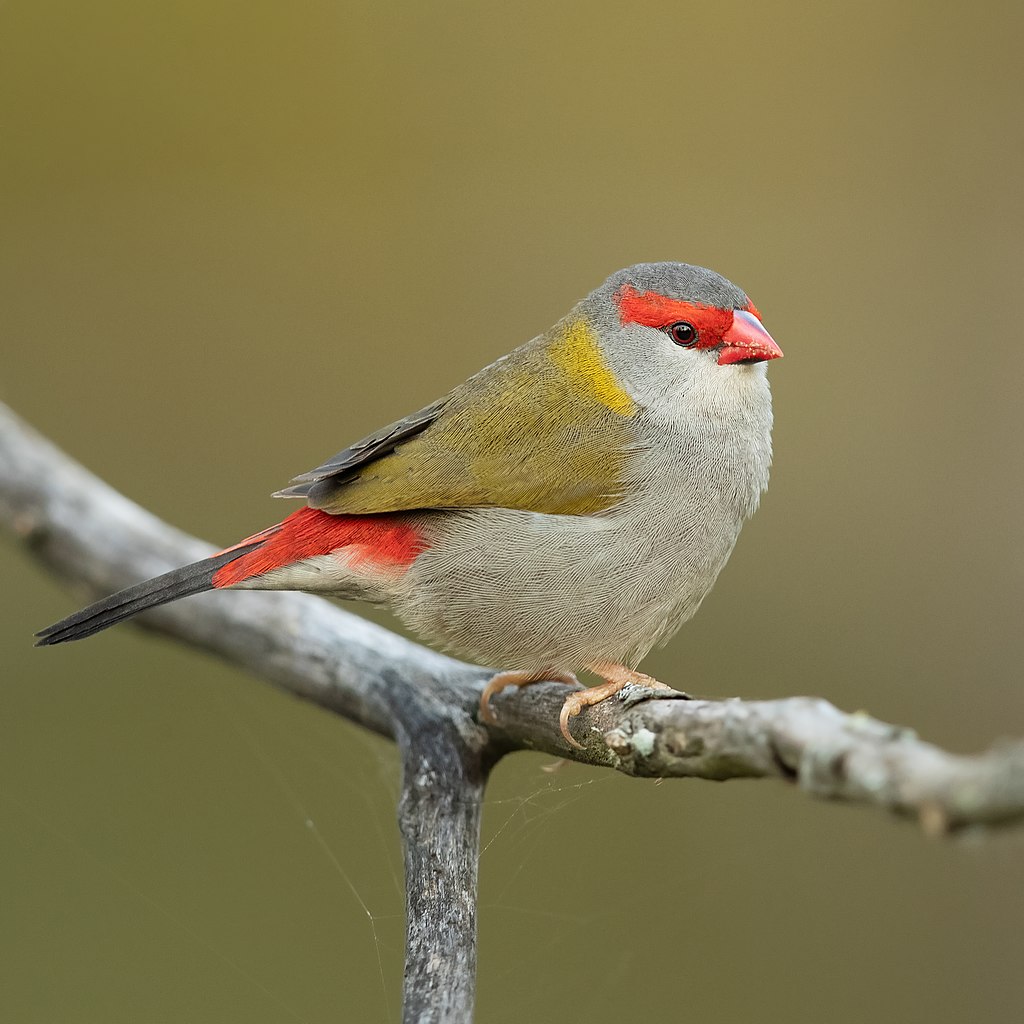
Red-browed finch (Neochmia temporalis). Photo: J J Harrison
Report Fox Sightings
%20(1).jpg?timestamp=1675893929686)
Marine Wildlife Rescue Group On The Central Coast
A new wildlife group was launched on the Central Coast on Saturday, December 10, 2022.
Marine Wildlife Rescue Central Coast (MWRCC) had its official launch at The Entrance Boat Shed at 10am.
The group comprises current and former members of ASTR, ORRCA, Sea Shepherd, Greenpeace, WIRES and Wildlife ARC, as well as vets, academics, and people from all walks of life.
Well known marine wildlife advocate and activist Cathy Gilmore is spearheading the organisation.
“We believe that it is time the Central Coast looked after its own marine wildlife, and not be under the control or directed by groups that aren’t based locally,” Gilmore said.
“We have the local knowledge and are set up to respond and help injured animals more quickly.
“This also means that donations and money fundraised will go directly into helping our local marine creatures, and not get tied up elsewhere in the state.”
The organisation plans to have rehabilitation facilities and rescue kits placed in strategic locations around the region.
MWRCC will also be in touch with Indigenous groups to learn the traditional importance of the local marine environment and its inhabitants.
“We want to work with these groups and share knowledge between us,” Gilmore said.
“This is an opportunity to help save and protect our local marine wildlife, so if you have passion and commitment, then you are more than welcome to join us.”
Marine Wildlife Rescue Central Coast has a Facebook page where you may contact members. Visit: https://www.facebook.com/profile.php?id=100076317431064
- Ph: 0478 439 965
- Email: marinewildlifecc@gmail.com
- Instagram: marinewildliferescuecc
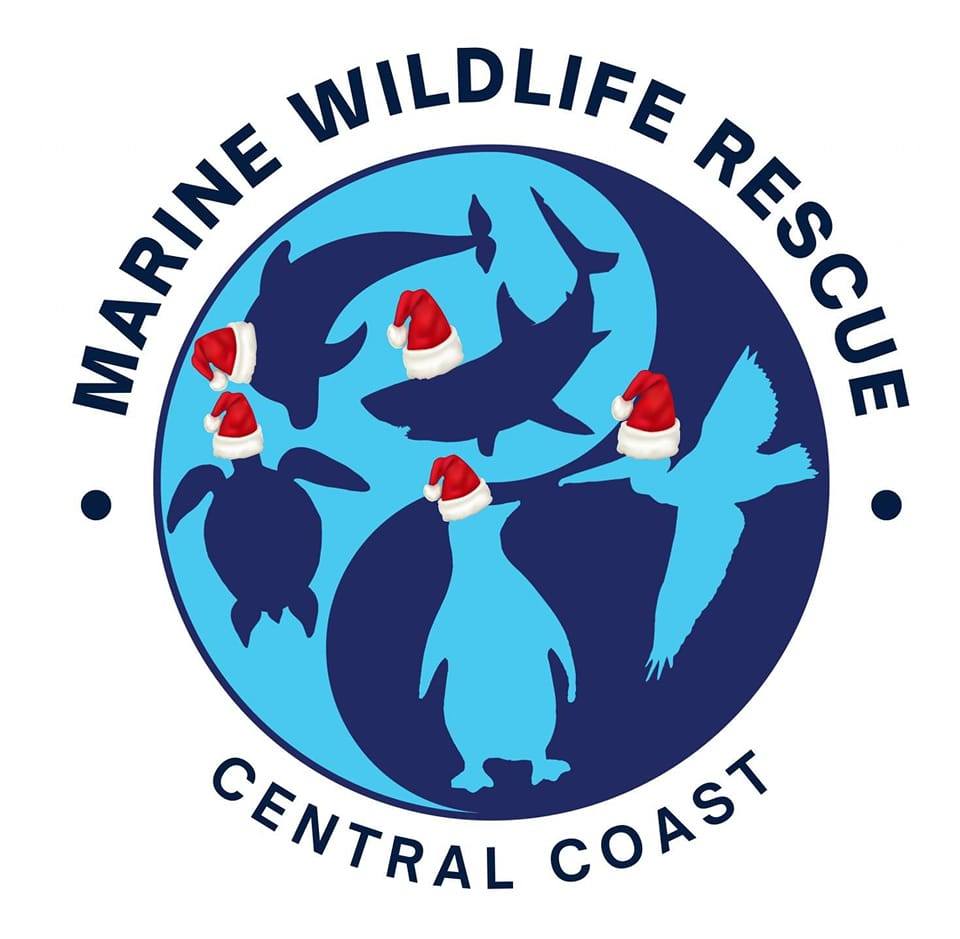
Watch Out - Shorebirds About
.JPG.opt1460x973o0,0s1460x973.jpg?timestamp=1663629195339)
Possums In Your Roof?: Do The Right Thing
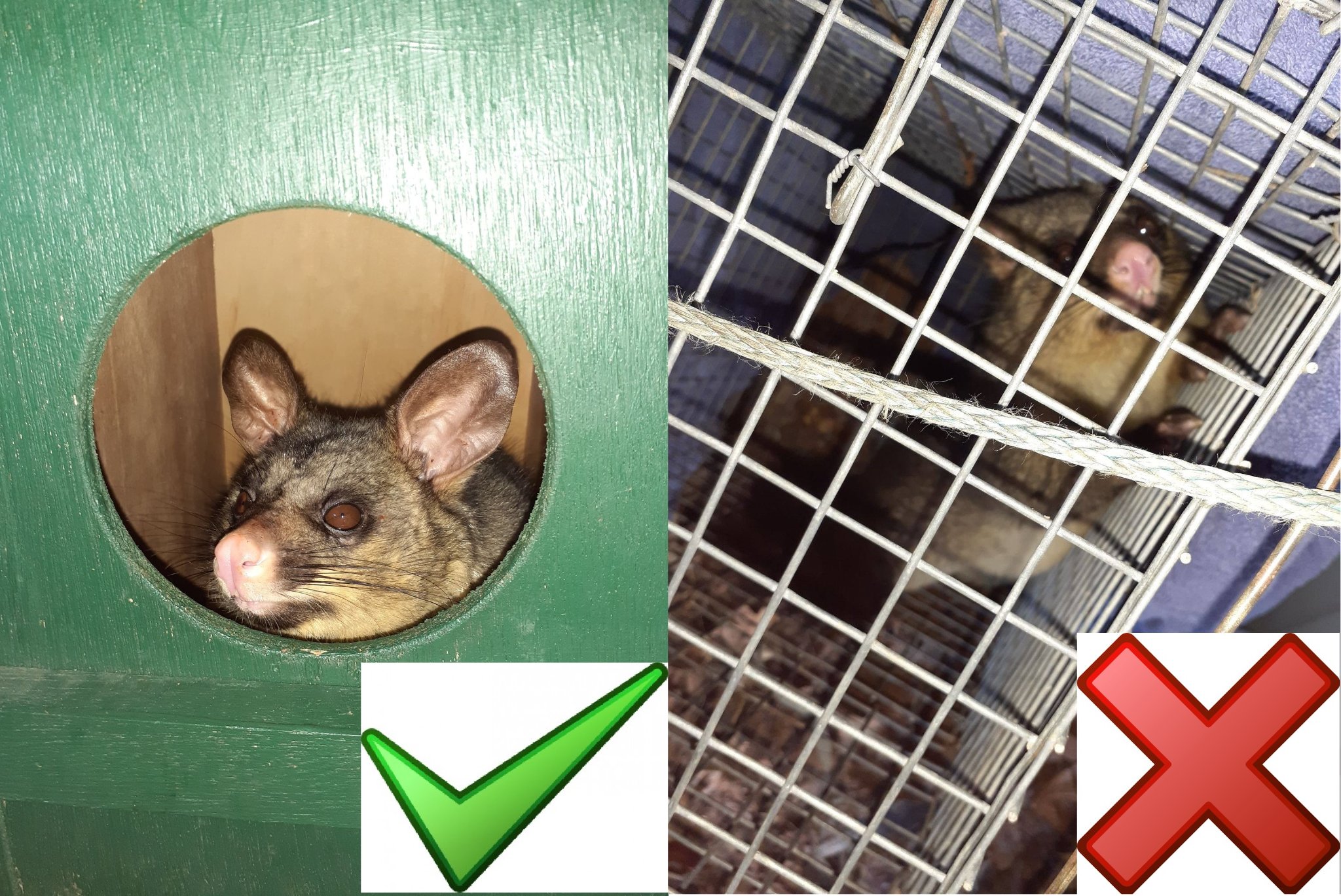
Aviaries + Possum Release Sites Needed

Bushcare In Pittwater
Where we work Which day What time
Avalon
Angophora Reserve 3rd Sunday 8:30 - 11:30am
Avalon Dunes 1st Sunday 8:30 - 11:30am
Avalon Golf Course 2nd Wednesday 3 - 5:30pm
Careel Creek 4th Saturday 8:30 - 11:30am
Toongari Reserve 3rd Saturday 9 - 12noon (8 - 11am in summer)
Bangalley Headland 2nd Sunday 9 to 12noon
Bayview
Winnererremy Bay 4th Sunday 9 to 12noon
Bilgola
North Bilgola Beach 3rd Monday 9 - 12noon
Algona Reserve 1st Saturday 9 - 12noon
Plateau Park 1st Friday 8:30 - 11:30am
Church Point
Browns Bay Reserve 1st Tuesday 9 - 12noon
McCarrs Creek Reserve Contact Bushcare Officer To be confirmed
Clareville
Old Wharf Reserve 3rd Saturday 8 - 11am
Elanora
Kundibah Reserve 4th Sunday 8:30 - 11:30am
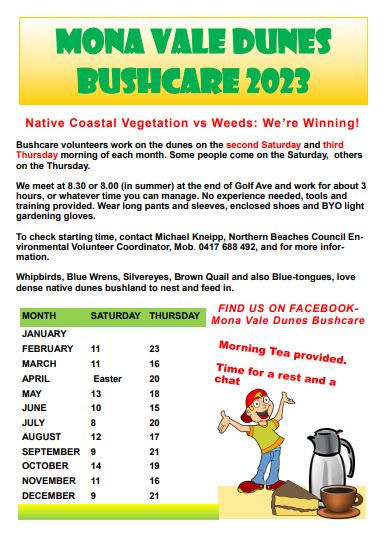 Mona Vale
Mona Vale Mona Vale Beach Basin 1st Saturday 8 - 11am
Mona Vale Dunes 2nd Saturday +3rd Thursday 8:30 - 11:30am
Newport
Bungan Beach 4th Sunday 9 - 12noon
Crescent Reserve 3rd Sunday 9 - 12noon
North Newport Beach 4th Saturday 8:30 - 11:30am
Porter Reserve 2nd Saturday 8 - 11am
North Narrabeen
Irrawong Reserve 2nd Saturday 2 - 5pm
Palm Beach
North Palm Beach Dunes 3rd Saturday 9 - 12noon
Scotland Island
Catherine Park 2nd Sunday 10 - 12:30pm
Elizabeth Park 1st Saturday 9 - 12noon
Pathilda Reserve 3rd Saturday 9 - 12noon
Warriewood
Warriewood Wetlands 1st Sunday 8:30 - 11:30am
Whale Beach
Norma Park 1st Friday 9 - 12noon
Western Foreshores
Coopers Point, Elvina Bay 2nd Sunday 10 - 1pm
Rocky Point, Elvina Bay 1st Monday 9 - 12noon
Friends Of Narrabeen Lagoon Catchment Activities

Gardens And Environment Groups And Organisations In Pittwater
26 years ago, Howard chose fossil fuels over the Pacific. What will Albanese choose?
Wesley Morgan, Griffith UniversityHot on the heels of trips to Washington and Beijing, Prime Minister Anthony Albanese is now in the Cook Islands for the Pacific Island Forum. There, he will aim to strengthen relations with Pacific countries and reaffirm Australia’s place as a security partner of choice.
But to do that, he’ll have to repair a historic split from when former prime minister John Howard met with Pacific leaders on the same island, Aitutaki, a quarter of a century ago to defend his choice to expand Australia’s fossil fuel industries.
Pacific leaders see climate change as by far their greatest security threat. Sea level rise, stronger cyclones, marine heatwaves and ocean acidification pose existential threats. They will ask Albanese to support a regional declaration for a phaseout of fossil fuels.
What will happen on the atoll? We could see history repeat – Pacific outrage, Australian intransigence. Or we could see a better outcome, if Albanese signals Australia is at last ready to move away from fossil fuels.
A Split In Aitutaki
When a scientific consensus on global warming emerged in the mid-1980s, Australia’s initial response was aligned with Pacific nations. In fact, they called for industrialised countries to immediately cut greenhouse gas emissions in a joint statement in 1990.
Pacific island nations suggested Australia’s national target – to cut emissions by 20% by 2005 – should be binding for all developed countries.
That brief window soon closed. Under sustained lobbying from the fossil fuel industry, the Australian government came to see global climate action as a threat to economic prosperity.
At the first Conference of Parties (COP1) to the UN climate convention in 1995, Australia’s negotiators argued for a weaker emissions target because our economy was more fossil fuel dependent than comparable nations. This positioning in the UN climate talks was further entrenched when Howard came to power in 1996.
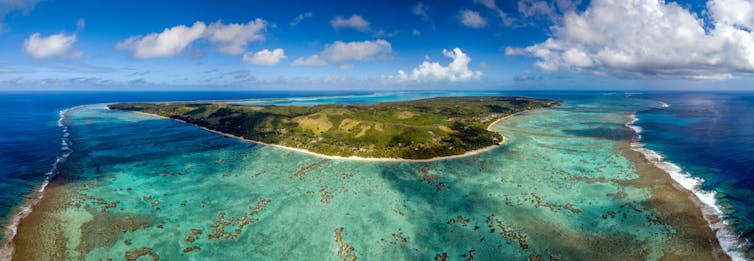
Differences with island nations came to a head at the 1997 South Pacific Forum, when island leaders tried to persuade Howard to support their calls for globally binding emissions cuts ahead of Kyoto Protocol negotiations later that year. Discussions in Aitutaki turned bitter and ran into overtime in the airport lounge.
Howard was not moved. At the Kyoto negotiations, Australia sought and won its own clause, allowing it to actually increase emissions, and expand its fossil fuel industries.
Afterwards, the Cook Islands prime minister Geoffrey Henry described Australia’s approach as a “self-serving” attempt to protect coal and energy intensive industries. Tuvalu prime minister Bikenibau Paeniu told regional media that “Australia dominates us so much in this region, for once we would have liked to have got some respect”.
For his part, Howard dismissed concerns that climate change and sea-level rise could threaten island states as “exaggerated” and “apocalyptic”.
Australia’s decision has rankled ever since.
Could We See Australia Repair The Rift?
For his part, Albanese has said he wants to repair the climate rift. At last year’s forum, he joined island leaders to declare a Pacific climate emergency. Australia is bidding to host the UN climate talks in 2026 in partnership with Pacific island countries, a move island leaders have formally welcomed. But it’s also clear Pacific countries want him to support a regional declaration to phase out fossil fuels.
Pacific governments have not been sitting still. This year, a group of Pacific governments called for a fossil-fuel-free Pacific. Island countries want to establish a new Pacific Energy Commissioner to oversee the region’s energy transition.
Pacific countries are also campaigning for a global Fossil Fuel Non-Proliferation Treaty which would oversee the end of fossil fuel expansion. These goals will be put to leaders again this week – including Albanese.
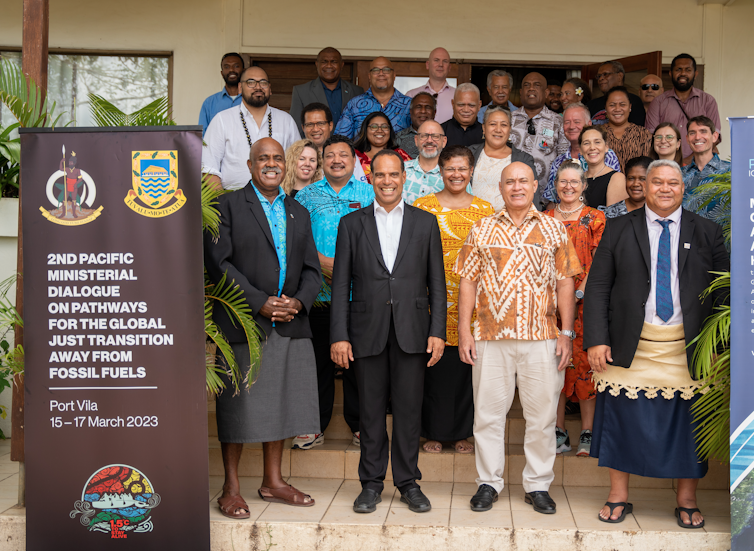
There are signs Albanese will arrive with new climate finance in hand, including A$50 million for the global Green Climate Fund and funds for a regional Pacific Resilience Facility. Support to tackle rising climate adaptation costs will be welcomed, but it won’t be enough for Pacific leaders. What they want to see is their regionally powerful neighbour actually stop adding fuel to the fire.
Vanuatu’s climate minister Ralph Regenvanu says Pacific nations need genuine allies who will make substantive commitments to move away from coal, oil and gas.
No Stopping The Global Energy Transition
It’s not just Pacific nations calling on Australia to commit to a fossil fuel phase-out. Germany’s international climate envoy Jennifer Morgan is headed to this week’s forum to call on Australia to support the European Union push for a phase-out at next month’s UN COP28 climate talks in Dubai.
Ambassador Morgan this week said:
we have to not only phase out fossil fuels, we need to stop building new infrastructure for fossil fuels, because they will become stranded assets. We need to be working on a just transition for workers and building up new industries.
She has a point. The International Energy Agency last week released its annual World Energy Outlook, which found global deployment of renewable energy technologies is rapidly overtaking fossil fuel projects, and demand for fossil fuels is likely to peak before 2030.
Australia’s economic interests are shifting as the world economy heads toward net zero emissions. Gas and coal aren’t the only valuable things underneath Australian dirt – we’ve got a wealth of critical minerals vital to the clean energy transition.
Governments have no choice but to plan for the inevitable decline of fossil fuels and smooth the transition to clean energy industries such as battery manufacturing and green hydrogen and ammonia.
The sooner Australia gets on with the transition away from fossil fuels, the sooner we will be embraced by the rest of the Pacific family. ![]()
Wesley Morgan, Research Fellow, Griffith Asia Institute, Griffith University
This article is republished from The Conversation under a Creative Commons license. Read the original article.
Luminous ‘mother-of-pearl’ clouds explain why climate models miss so much Arctic and Antarctic warming

Our planet has warmed by about 1.2°C since 1850. But this warming is not uniform. Warming at the poles, especially the Arctic, has been three to four times faster than the rest of the globe. It’s a phenomenon known as “polar amplification”.
Climate models simulate this effect, but when tested against the past 40 years of warming, these models fall short. The situation is even worse when it comes to modelling past climates with very high levels of greenhouse gases.
This is a problem because these are the same models used to project into the future and forecast how the climate will change. They are likely to underestimate what will happen later this century, including risks such as ice sheet melting or permafrost thawing.
In our new research published today in Nature Geoscience we used a high-resolution model of the atmosphere that includes the stratosphere. We found a special type of cloud appears over polar regions when greenhouse gas concentrations are very high. The role of this type of cloud has been overlooked so far. This is one of the reasons why our models are too cold at the poles.
Back To The Future
Looking into past climates can give us glimpses of possible futures for a range of extreme conditions. For us, this means we can use Earth’s history to find out how well our climate models perform. We can test our models by simulating episodes in the past when Earth was much warmer. The advantage of this is that we have temperature reconstructions for these episodes to evaluate the models, as opposed to the future, for which measurements are not available.
If we go back 50 million years or so, our planet was very hot. Carbon dioxide (CO₂) concentrations ranged between 900 and 1,900 parts per million (ppm), compared with 415 ppm today. Methane (CH₄) concentrations were likely also much higher.
Canada’s arctic archipelago was covered in lush rainforests inhabited by alligators, turtles, lizards and mammals.
For these plants and animals to survive, conditions must have been warm and ice-free year-round. Indeed, surface ocean temperatures exceeded 20°C near the north pole (at about 87°N) and 25°C in the Southern Ocean (at about 67°S).
This period called the early Eocene is a perfect test bed for our models, because it was globally very warm, and the poles were even warmer, meaning it was a climate with extreme polar amplification. In addition, the Eocene is recent enough for temperature reconstructions to be available.
But as it turns out, the models fail again. They are much too cold at high latitudes. What are our models missing?
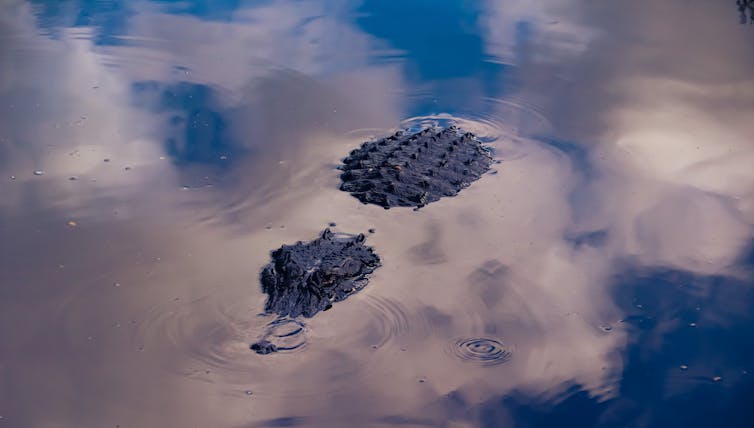
Polar Stratospheric Clouds
In 1992 American paleoclimatologist Lisa Sloan suggested polar stratospheric clouds might have caused extreme warming at high latitudes in the past.
These clouds are a rare and beautiful sight today. They are also called nacreous or mother-of-pearl clouds for their vivid and sometimes luminous colours.
They form at very high altitudes (in the stratosphere) and at very low temperatures (over the poles). In the present day climate, they appear mainly over Antarctica, but have also been observed during winter months over Scotland, Scandinavia and Alaska, at times when the stratosphere was particularly cold.
Just like greenhouse gases, they absorb infrared radiation emitted by the Earth’s surface and re-emit a portion of this energy back to the surface. This suggests polar stratospheric clouds could be one of the missing puzzle pieces.
They warm the surface. And their effect could be significant, especially in winter, when the sun does not rise. But they are difficult to simulate in a climate model, so most models ignore them. This omission could explain why climate models miss some of the polar warming, because they miss a process that warms the poles.
Three decades after Sloan’s paper, a few atmosphere models are finally complex enough to allow us to test her hypothesis. In our research we use one of them and find that under certain conditions, the additional warming due to these polar stratospheric clouds exceeds 7°C during the winter months. This significantly reduces the gap between climate models and temperature evidence from the early Eocene. Sloan was right.
Implications For Future Projections
Our research explains why climate models don’t work so well for past climates when greenhouse gas levels were much higher than they are today. But what about the future? Should we be concerned?
There is some good news. While polar stratospheric clouds do warm the poles, they won’t be as common in the future as they were in the distant past, even if both CO₂ and CH₄ reach very high levels.
This is due to another difference between the Eocene and today: the position of continents and mountains, which were different back then and which also influence the formation of polar stratospheric clouds. So even if we hit early Eocene levels of CH₄ and CO₂ in the future, we would expect less polar stratospheric cloud to be formed. This suggests the standard climate models are better at predicting the future than the past.
It’s therefore unlikely the Arctic and Antarctica will be covered by these beautiful clouds anytime soon. But our research shows evidence from past climates can reveal processes that only become important when greenhouse gas concentrations are high. Some of these processes are not included in our models because models are tested against present day observations and other processes simply seemed more important to include. Looking into the past is a way of broadening our horizon and learning for the future.![]()
Katrin Meissner, Professor and Director of the Climate Change Research Centre, UNSW, UNSW Sydney; Deepashree Dutta, Postdoctoral Research Associate, University of Cambridge, and Martin Jucker, Lecturer in Atmospheric Dynamics, UNSW Sydney
This article is republished from The Conversation under a Creative Commons license. Read the original article.
Extreme weather may help invasive species outcompete native animals – new study
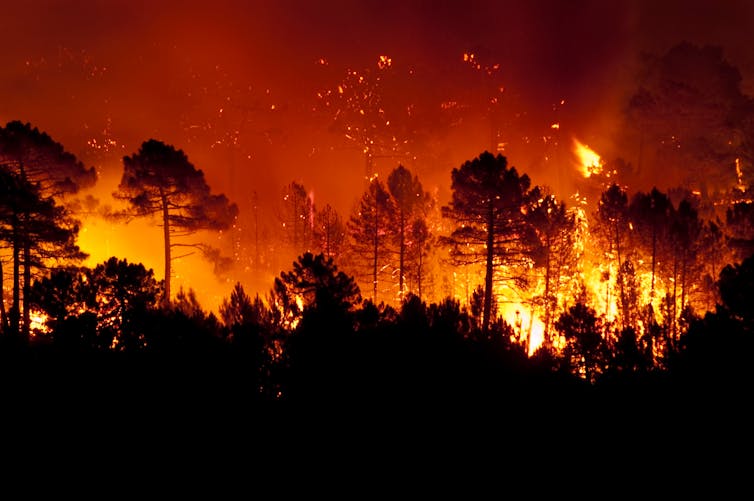
Non-native species appear to be better able to resist extreme weather, threatening native plants and animals and potentially creating more favourable conditions for invasive species under climate change. That’s the conclusion of a new study in the scientific journal Nature Ecology and Evolution.
Wildfires, droughts, heavy rainfall and storms are all increasing, and predicted to become more frequent throughout the next century due to human-driven climate change.
At the same time, humans are transporting more species into new areas, despite concerted global efforts to increase biosecurity across borders and to target the eradication of specific species. Some of these non-native species can go on to become invasive, damaging native ecosystems.
Capitalising On Opportunities
Invasive species introduced by humans often possess traits that help them survive or even thrive when ecosystems are disturbed (perhaps by wildfire, a storm or human buildings).
Invasive plants are generally fast-growing, for instance, allowing them to quickly fill gaps before native species can recover from disturbances. They are also often very good at dispersing their seeds, allowing them to quickly colonise disturbed areas.
This is why scientists have long suspected that extreme weather and the success of non-native species could be linked.
If extreme weather removes native plants and animals, that increases the availability of resources such as water and space. Non-native species can then capitalise on these new resources to establish themselves.
Even more concerning is the potential for extreme weather and non-native species to interact, exacerbating their effect on native biodiversity. For instance, in a recent field experiment in the US, scientists deliberately started a fire which killed about 10% of the longleaf pine trees in the area studied.
But in areas where an invasive grass – cogongrass, an Asian native – was allowed to establish itself alongside the pines, the fires had more fuel and were larger, hotter and burned for longer.
Where the scientists had added rain shelters to simulate drought conditions, the grass dried out further and the fires became much more lethal. A combination of drought and the invasive species meant longleaf pine mortality soared to 44%.
Similarly, on the small Macquarie Island in the south west Pacific, a combination of extreme rainfall and the presence of invasive European rabbits reduced the breeding success of nesting black-browed albatrosses. Heavy grazing by the invasive rabbits reduced plant cover, exposing the albatross chicks to the harsh weather conditions.
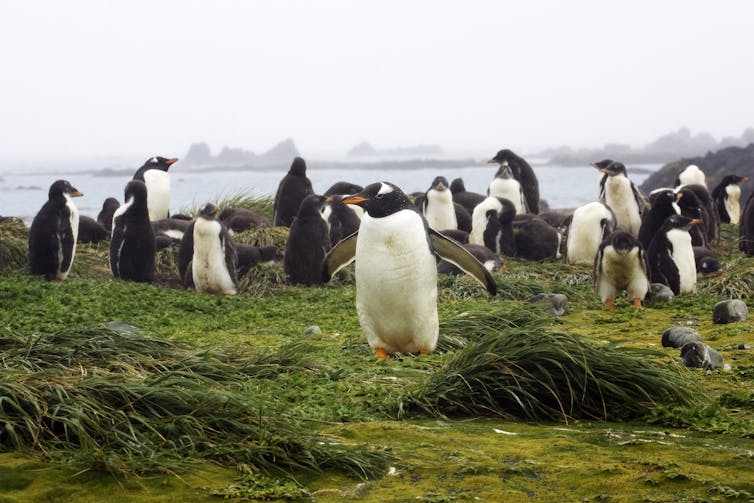
This relationship between extreme weather and invasive species – two human-driven drivers of global change – threatens native plants and animals and could cost countries billions of dollars in coming decades. Ecologists must identify priority areas and species that can be targeted in efforts to minimise costs and prevent the loss of native biodiversity.
Bad Weather, Good For Non-Natives
To better understand how native and non-native species respond to extreme weather events, the scientists behind the new study reanalysed information from 443 peer-reviewed studies on how species responded to wildfires, droughts and storms. In all, they gathered data on 187 non-native species and 1,852 native species from all major animal groups.
Their results suggest that native and non-native species may indeed respond differently to extreme weather. Across all studies, a total of 24.8% of non-native species benefited from extreme weather events compared to only 12.7% of native species.
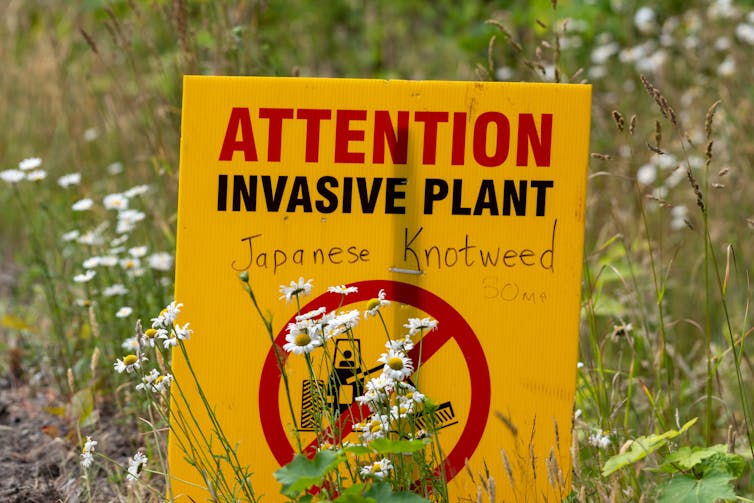
For example, while native species in both freshwater and land-based ecosystems were harmed by droughts, their non-native counterparts showed no significant response. Notably, marine ecosystems were comparatively more resistant to extreme weather events, with fewer differences between native and non-native species.
The authors did find marine heatwaves harmed native coral species, however, a relationship that has been documented in other scientific studies.
Identifying Global Hotspots
The authors took this information and combined it with known global hotspots of extreme weather, to identify areas where native species may be particularly vulnerable to the combination of extreme weather and invasive species.
They found high latitude areas such as northern US and Europe, for instance, are both vulnerable to extreme cold spells and possess non-native species that benefit from cold spells. Alternatively, areas of the western Amazon in Brazil and east Asia were identified as vulnerable to flooding and possessing flood-resistant non-native species.
In these regions, non-native species could benefit from increasing cold spells or flooding respectively, posing a greater threat to native plants and animals.
Studies like this are very useful. Regions that are identified as vulnerable can be targeted with early preventative measures to stop the spread of invasive species, or with measures to help native biodiversity cope with climate change.
This research could also allow targeted restoration to remove non-native species and produce invasion-resistant native communities that could better withstand future conditions. This is what happened on Macquarie Island, where invasive rabbits and rats were eventually eliminated and the whole ecosystem soon bounced back.
Such action could be critical as we adapt to a changing climate and a greater mixing of the world’s plants and animals.

Don’t have time to read about climate change as much as you’d like?
Get a weekly roundup in your inbox instead. Every Wednesday, The Conversation’s environment editor writes Imagine, a short email that goes a little deeper into just one climate issue. Join the 20,000+ readers who’ve subscribed so far.![]()
Harry Shepherd, Postdoctoral Research Associate, King's College London
This article is republished from The Conversation under a Creative Commons license. Read the original article.
How global warming shakes the Earth: Seismic data show ocean waves gaining strength as the planet warms
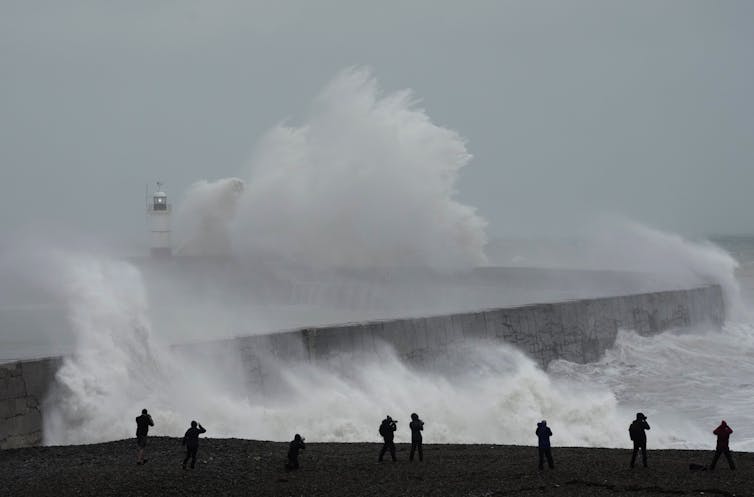
As oceans waves rise and fall, they apply forces to the sea floor below and generate seismic waves. These seismic waves are so powerful and widespread that they show up as a steady thrum on seismographs, the same instruments used to monitor and study earthquakes.
That wave signal has been getting more intense in recent decades, reflecting increasingly stormy seas and higher ocean swell.
In a new study in the journal Nature Communications, colleagues and I tracked that increase around the world over the past four decades. These global data, along with other ocean, satellite and regional seismic studies, show a decadeslong increase in wave energy that coincides with increasing storminess attributed to rising global temperatures.
What Seismology Has To Do With Ocean Waves
Global seismographic networks are best known for monitoring and studying earthquakes and for allowing scientists to create images of the planet’s deep interior.
These highly sensitive instruments continuously record an enormous variety of natural and human-caused seismic phenomena, including volcanic eruptions, nuclear and other explosions, meteor strikes, landslides and glacier-quakes. They also capture persistent seismic signals from wind, water and human activity. For example, seismographic networks observed the global quieting in human-caused seismic noise as lockdown measures were instituted around the world during the coronavirus pandemic.
However, the most globally pervasive of seismic background signals is the incessant thrum created by storm-driven ocean waves referred to as the global microseism.
Two Types Of Seismic Signals
Ocean waves generate microseismic signals in two different ways.
The most energetic of the two, known as the secondary microseism, throbs at a period between about eight and 14 seconds. As sets of waves travel across the oceans in various directions, they interfere with one another, creating pressure variation on the sea floor. However, interfering waves aren’t always present, so in this sense, it is an imperfect proxy for overall ocean wave activity.
A second way in which ocean waves generate global seismic signals is called the primary microseism process. These signals are caused by traveling ocean waves directly pushing and pulling on the seafloor. Since water motions within waves fall off rapidly with depth, this occurs in regions where water depths are less than about 1,000 feet (about 300 meters). The primary microseism signal is visible in seismic data as a steady hum with a period between 14 and 20 seconds.
What The Shaking Planet Tells Us
In our study, we estimated and analyzed historical primary microseism intensity back to the late 1980s at 52 seismograph sites around the world with long histories of continuous recording.
We found that 41 (79%) of these stations showed highly significant and progressive increases in energy over the decades.
The results indicate that globally averaged ocean wave energy since the late 20th century has increased at a median rate of 0.27% per year. However, since 2000, that globally averaged increase in the rate has risen by 0.35% per year.
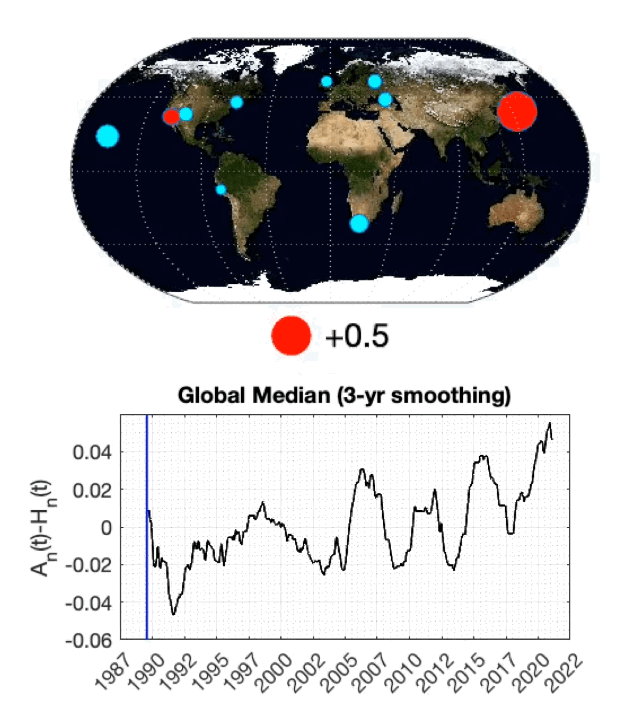
We found the greatest overall microseism energy in the very stormy Southern Ocean regions near the Antarctica peninsula. But these results show that North Atlantic waves have intensified the fastest in recent decades compared to historical levels. That is consistent with recent research suggesting North Atlantic storm intensity and coastal hazards are increasing. Storm Ciarán, which hit Europe with powerful waves and hurricane-force winds in November 2023, was one record-breaking example.
The decadeslong microseism record also shows the seasonal swing of strong winter storms between the Northern and Southern hemispheres. It captures the wave-dampening effects of growing and shrinking Antarctic sea ice, as well as the multi-year highs and lows associated with El Niño and La Niña cycles and their long-range effects on ocean waves and storms.
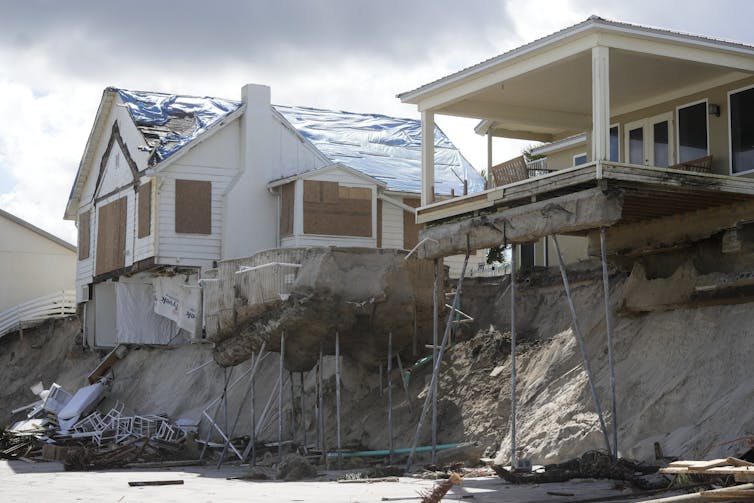
Together, these and other recent seismic studies complement the results from climate and ocean research showing that storms, and waves, are intensifying as the climate warms.
A Coastal Warning
The oceans have absorbed about 90% of the excess heat connected to rising greenhouse gas emissions from human activities in recent decades. That excess energy can translate into more damaging waves and more powerful storms.
Our results offer another warning for coastal communities, where increasing ocean wave heights can pound coastlines, damaging infrastructure and eroding the land. The impacts of increasing wave energy are further compounded by ongoing sea level rise fueled by climate change and by subsidence. And they emphasize the importance of mitigating climate change and building resilience into coastal infrastructure and environmental protection strategies.![]()
Richard Aster, Professor of Geophysics and Department Head, Colorado State University
This article is republished from The Conversation under a Creative Commons license. Read the original article.
Window To The Past: New Microfossils Suggest Earlier Rise In Complex Life
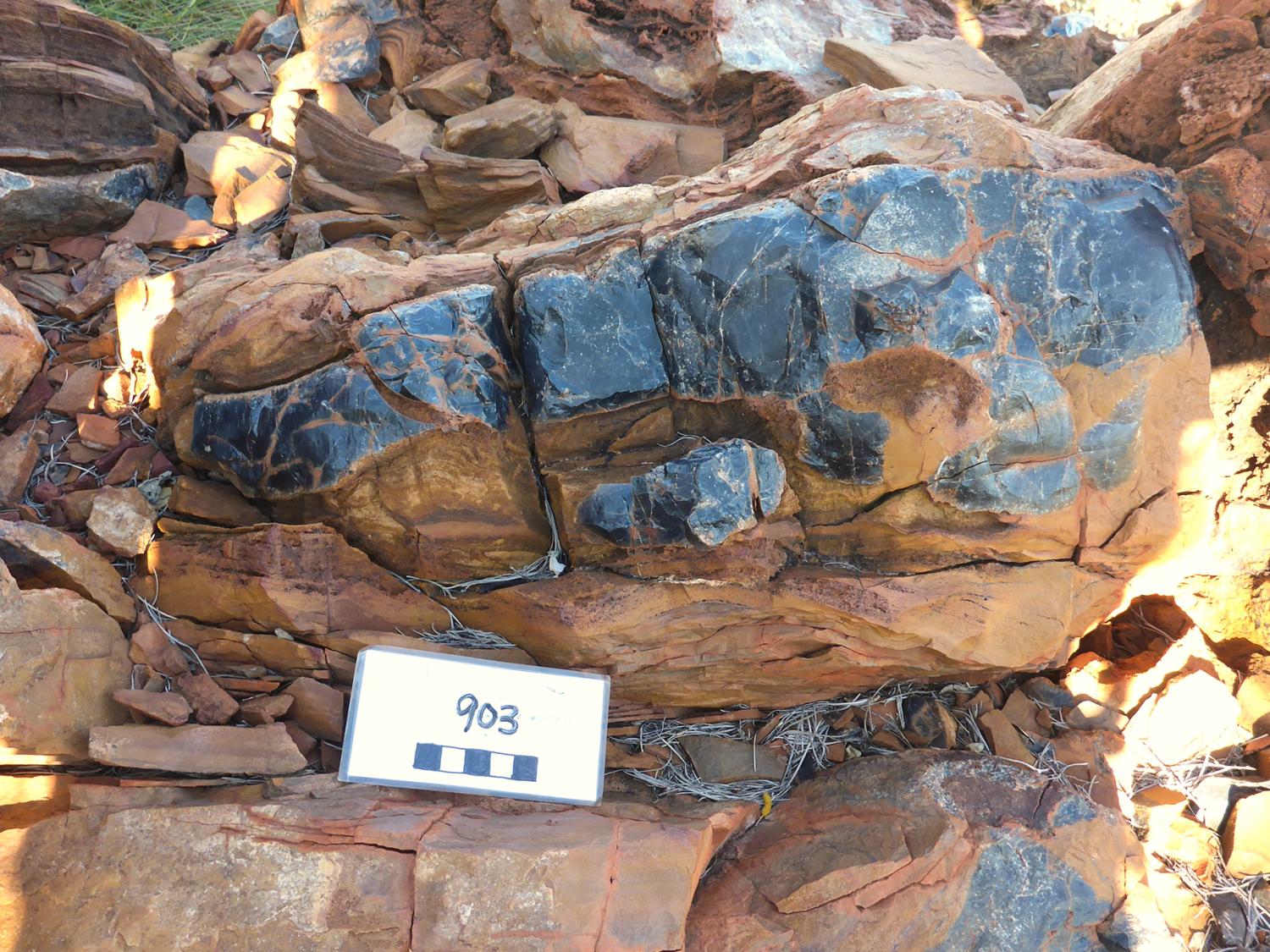
Making money green: Australia takes its first steps towards a net zero finance strategy
Alison Atherton, University of Technology Sydney and Gordon Noble, University of Technology SydneyThis article is part of a series by The Conversation, Getting to Zero, examining Australia’s energy transition.
Just north of Jamestown in South Australia, 70 kilometres east of the Spencer Gulf and next to a wind farm of nearly 100 turbines, stands the world’s first big battery.
Built in partnership with Tesla and financed and operated by Neoen, a French multinational renewable energy developer, the Hornsdale Power Reserve and other big battery projects could stimulate a homegrown battery industry, contributing many billions of dollars and thousands of jobs to the Australian economy. But for that industry to rise, it will need money.
Australia aspires not only to transition its economy to net zero emissions, but to become a green energy superpower. That means building a host of solar and wind farms, batteries, electric vehicle charging stations, upgrades to the grid and to all kinds of buildings, as well as investments in new technology.
These investments and big infrastructure projects don’t come cheap. Getting to net zero emissions by 2050 requires investment in renewable energy of A$754 billion in power generation alone, according to research by the UTS Institute for Sustainable Futures and funded by Future Super.
The Size Of The Green Finance Challenge
By 2030, the world will have to invest an estimated US$4.3 trillion a year – roughly the GDP of Japan, the world’s third-largest economy – in climate finance. These financial flows need to grow by 21% a year, on average. Without this enormous increase, the economic transition will not happen in time to avoid the worst impacts of climate change.
The scale of financing means that superannuation funds and other big institutional investors must be involved. They need to know where their money is going, and whether investments are genuine or a case of “greenwashing”. They need certainty that companies in which they invest have solid plans to reduce their climate risk, and the ability to ask the companies questions when they don’t.
But current financial regulation is not set up to support such best practice. To give just one example, default superannuation funds lack the benchmarks – measures of performance assessed by the Australian Prudential Regulation Authority – they need to invest in start-up businesses that are developing clean energy technologies.
Successive Australian governments have been slow to grasp this reality, and we are now playing catch-up with many other countries.
Australia Releases Its Strategy
The Australian government’s Sustainable Finance Strategy, released by Treasurer Jim Chalmers last Thursday, lays solid foundations for this recovery. Yet more needs to be done if Australia is to achieve the strategy’s stated ambition to be a global sustainability finance leader.
The strategy is arranged around three core pillars. The first focuses on creating access to information that is credible, accurate and of practical value. It seeks to ensure markets operate efficiently and money flows to where it is most needed.
From July 1 2024, large Australian companies and financial institutions will have to disclose information about the impacts of climate on their business, the risks climate change poses to their operations, and how they plan to decarbonise.
The disclosure requirements will be based on internationally accepted standards, to ensure Australian and overseas investors can compare data across companies and countries.
The government is also supporting the development of an Australian sustainable finance taxonomy – a set of criteria that enables investors to evaluate whether and to what extent an investment supports sustainability goals.
A taxonomy spells out which investments result in real decarbonisation, and reduces the likelihood of false claims about the sustainability of projects and investments. A government agency will manage the taxonomy, which will start as a voluntary code but may eventually become mandatory.
Large companies will also be required to disclose their net zero transition plan, if they have one. With companies representing 80% of the market capitalisation of ASX 200 companies pledging to achieve net zero emissions, the government wants to ensure their plans are credible. It wants the corporate regulator, the Australian Securities and Investment Commission (ASIC), to set out its expectations of the plans – a welcome step.
The second pillar focuses on building the capabilities of Australia’s financial system regulators to manage risk and to clamp down on greenwashing – the practice of making misleading or deceptive claims about the environmental benefits of activities or assets.
Fighting Greenwashing
ASIC Deputy Chair Karen Chester believes the economic cost and loss of investor confidence caused by greenwashing “cannot be overstated”. Her organisation has set out guidelines to help financial institutions identify it. This year ASIC launched its first three legal actions, including one against the local arm of US investment giant Vanguard, and another against Active Super, which allegedly falsely claimed it had eliminated investments, such as coal mining, that posed too great a risk to the environment and the community.
The third pillar concerns government leadership and engagement. Such a large and rapid increase in the scale of private sector finance requires growth in a range of financial assets, including shares, bonds and other kinds of debt.
The government is supporting the development of a green bond market by issuing Australia’s first green sovereign bond in June. These bonds are designed to establish standards for lending and borrowing for all green finance; they will also help the government to fund projects such as electric vehicle charging infrastructure.
Finally, the strategy recognises the importance of collaboration across the Asia-Pacific. If Australia achieves its goal of becoming a regional sustainable finance hub it would not only benefit our national interest but help Pacific Island nations to raise the finance to decarbonise.
What’s Missing From The Strategy?
The strategy does not focus on green finance skills and competencies. Yet these capabilities, ranging from a basic understanding of what business activities are unsustainable to specialist expertise in the use of scenario analysis to assess climate risk, are essential to the net zero transition.
LinkedIn’s recent Green Skills Report shows that, globally, the finance sector is lagging behind other sectors in building green skills. And Australia ranks only 30th in a list of countries on its share of talent for green finance.
Australia’s financial system must urgently transform itself to meet the climate challenge. If the financing of the transition were a bicycle race, Australia has now caught up to the global peloton. The next step is to take the lead.![]()
Alison Atherton, Program Lead, Business, Economy and Governance at the Institute for Sustainable Futures., University of Technology Sydney and Gordon Noble, Research Director, Institute for Sustainable Futures, University of Technology Sydney
This article is republished from The Conversation under a Creative Commons license. Read the original article.
Our minds handle risk strangely – and that’s partly why we delayed climate action so long

We now have a very narrow window to significantly and rapidly slash greenhouse gas emissions to avoid the most disastrous effects of climate change, with just an estimated six years left before we blow our carbon budget to stay below 1.5°C of warming.
We’ve known how gases like carbon dioxide trap heat for over 100 years and alarm bells have been ringing loudly for over 35 years, when climate scientist James Hansen testified that global warming had begun.
As extreme weather and temperatures arrive, many of us wonder whether it had to get this bad before we acted. Did we need to see to believe? What role has our own psychology played in our sluggishness?

How Do We Respond To Threats?
From a psychology point of view, motivating us to take action on climate is a wicked problem. Many factors combine to make it harder for us to act.
The necessary policies and behaviour changes have been viewed as too hard or costly. Until recently, the consequences of doing nothing have been seen as a distant problem. Given the complexity of climate modelling, it has been difficult for scientists and policymakers to lay out what the specific environmental consequences would be from any given action or when they would manifest.
As if that’s not enough, climate change presents a collective-action problem. It would do little good for Australia to reach net-zero emissions if other countries keep emitting without change.
When we write about climate change, we often frame it as an ever more urgent and significant threat to our way of life. We do this thinking that showing the seriousness of the threat will galvanise others into faster action.
Unfortunately, this isn’t always the case. When we’re confronted with big risks – and the need for a painful shift from the status quo – some of us respond unexpectedly. We might find ourselves motivated to seek out evidence to undercut the reality of the threat, and use this uncertainty to justify staying on the same path.
One unfortunate aspect of this is that people motivated to avoid or deny climate risk are actually better able to do so when they have more scientific training. This background equips them better to counter-argue and rationalise the dissonance, meaning they seek out information to align with their beliefs and justify their passivity. Misinformation and doubt are particularly damaging to climate action. They let us feel OK about inaction.
This tendency to rationalise away risk was also clearly visible among people who downplayed the impact or even denied the existence of COVID-19.
Is there an antidote?
We’ve found explaining the simple and well-understood way that emissions of specific gases trap the Sun’s heat and warm the planet can be effective, because people can’t rationalise these facts away. The greenhouse effect is a well-accepted phenomenon, even by those most sceptical of global warming. After all, it’s essential to life on Earth – without these gases trapping heat, the world would be too cold for life.
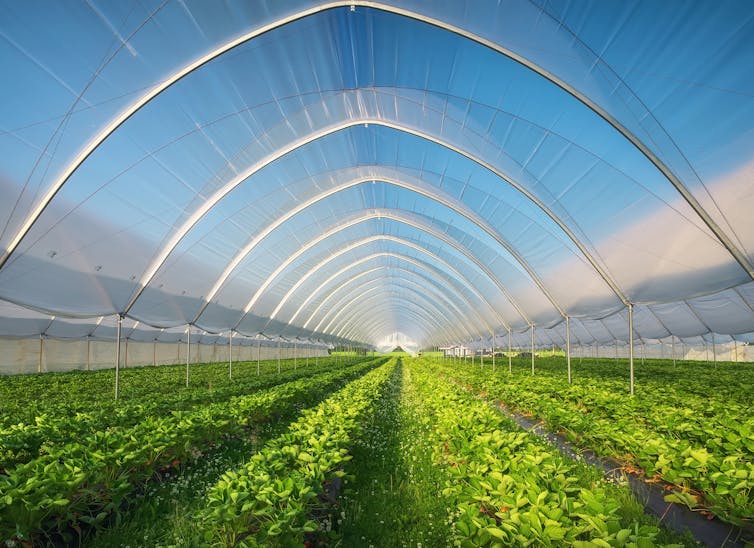
Why Are We Finally Acting?
As climate change has moved out of the computer models and become very much a part of our present, we are seeing stronger efforts to cut emissions.
More and more of us are experiencing tangible events such as forest fires, droughts, sudden floods, rapidly intensifying hurricanes or record-breaking heatwaves. This has removed one barrier to inaction. Until now, the consequences of doing nothing seemed far off and uncertain. Now they are seen as certain and already present.
Better still, technological advancement and economies of scale in production have meant clean energy and clean transport have fallen significantly in price.
At government and individual levels, there are now measures we can take that aren’t too costly and come with immediate gains such as cutting power bills or avoiding petrol price increases. Greater political consensus in many countries is also helping challenge the inertia of the status quo. That’s another barrier to action evaporating.
As climate damage gets worse, we’re likely to see ever-starker warnings. Does fear motivate us? When faced with threats, we are more likely to take action, particularly if we think we can make a difference.
Yes, we now have a very narrow window to avert the worst. But we also have an increased certainty about climate change and the damage it causes, as well as greater confidence in our ability to bring about change.
For years, our own psychology slowed down efforts to make the sweeping changes necessary to quit fossil fuels. Now, at least, some of these psychological barriers are getting smaller. ![]()
Jeff Rotman, Senior Lecturer in Marketing and Consumer Psychology & Co-Director of the Better Consumption Lab, Deakin University
This article is republished from The Conversation under a Creative Commons license. Read the original article.
Planet Earth III: how cookie cutter nature programming could fail to educate and inform audiences
Leora Hadas, University of NottinghamPerhaps nothing embodies the BBC’s values of inform, educate and entertain more than its nature documentaries. Planet Earth III is the latest in a proud tradition going back to the founding of the BBC Natural History Unit in 1957 and has everything devoted fans (myself included) expect.
There are sweeping shots, a soaring orchestral soundtrack, and exciting scenes of hunting, courtship and breeding. Tender family relations, desperate chases and amazing survival stories are all narrated in Sir David Attenborough’s signature style. Planet Earth III brings us all the beauty and wonder we know and love – which may be a problem when it tries to sound an urgent warning about the future of our world.
In terms of its story, Planet Earth III warns of environmental catastrophe more than any similar BBC show before it. The second episode includes a heartbreaking scene of seals caught screaming in a fishing net and ends with a question: can animals really adapt to survive our changing planet?
Part of this new willingness from the BBC to tackle environmental collapse head-on is due to the climate and ecological crisis that has become increasingly obvious and urgent. But another cause can be found in another crisis the BBC is facing.
What we might call the “planet format” has become so perfected and so popular, that the BBC’s competitors are eager to pick it up themselves. The format is a good fit for streaming platforms like Netflix, Amazon and Apple+. But with them all creating similar programmes, what effect does that have on their ability to inform, educate or entertain?
Comforting Catastrophe
Nature and wildlife stories are universally engaging and are great for showing off high budgets and virtuoso filmmaking. Copyright laws can protect a show’s characters or plot, but not a visual, musical or storytelling style.
This has led to many competitors fighting for a slice of this global market with shows that look, feel and sound virtually the same. Netflix has expanded their scope with Our Planet, Our Planet II and Our Universe (2022). Apple+ came out with Prehistoric Planet (2022). The format – from the timbre and rhythm of Attenborough’s narration to the style of shots – is even now used globally in productions like the Indian Wild Karnataka (2019).
It’s good to have more documentaries tackling the collapse of the natural world. But, I do wonder, what effect their looking and sounding the same might have on their ability to really educate audiences about the climate crisis and communicate the urgency of it. These stories all follow a single format, comforting in its familiarity but should anything that seeks to educate about climate catastrophe be comforting?
The planet formula is not just the stories it tells – it’s also how it tells them. Whether Planet Earth or Our Planet, Wild Karnataka or for the BBC’s Wild Isles (2023), the sweeping shots of pristine wilderness, the striking views and the orchestral music are the same. And the main emotion this formula works to inspire is not urgency, but awe.
An academic report commissioned by the BBC tells us that watching nature documentaries can soothe climate anxiety. This may seem paradoxical when the narration tells us about the loss of precious species and habitats. But consider what the format spends most of its time showing us: untouched landscapes unfolding endlessly from the air, beautiful animals in super high definition, and no humans in sight. Even Attenborough is only present through his calm and grandfatherly tone.
Neither Netflix nor anyone else has attempted to change these features: they are baked too deeply into the successful formula, and keeping to the formula is what keeps audiences coming. The narration in Planet Earth III might be telling us that time is running out to act, but the show invites us to sit back and absorb.
There is also the question of diversity. The climate crisis is a global problem with many faces, but the BBC’s planet format was born out of a particularly British tradition of nature programming. What do we lose when environmental stories are all told through the same lens and speak with the same voice?
Tackling Climate Change Head On
The increase in competition has led to one important change. Produced by the BBC’s frequent partner Silverback, Our Planet, which was released in 2019, was shot and edited in the same familiar and beloved style and featured the same type of animal stories. The first season did, however, offer one distinct competitive edge: a clear focus on environmental issues, which the BBC’s had been sorely lacking.
The BBC’s nature documentaries have come under considerable criticism over the years for not addressing the climate and ecological crisis. Historically, the BBC had chosen to stay neutral on the debate about human-caused global heating and this decision affected the Planet shows.
To undermine their rival, Netflix partnered with the World Wildlife Federation for Our Planet and widely promoted the show’s environmental message to audiences. The streaming platform presented itself as more progressive and cutting-edge than the staid and conservative BBC.
It was now survival of the fittest in the field of nature documentaries and this was not a bad thing for the BBC who now had to adapt and improve their nature content in the face of competition by explicitly tackling climate.
This one change, while great and urgently needed, has been quickly folded into the planet format and is a feature of all subsequent nature shows. This one change was not enough.
The popularity of nature documentaries means they can play an important role in making audiences aware of the state of our world. But for the Planet format to survive in the changing media ecosystem, the TV industry must keep an eye on whether and how it can continue to evolve.
We are seeing this happen as Planet Earth III shows the BBC rising to Netflix’s challenge by focusing on environmental issues. This is an encouraging sign but more innovative programming is needed.

Looking for something good? Cut through the noise with a carefully curated selection of the latest releases, live events and exhibitions, straight to your inbox every fortnight, on Fridays. Sign up here.![]()
Leora Hadas, Assistant Professor, Film and Television Studies, University of Nottingham
This article is republished from The Conversation under a Creative Commons license. Read the original article.
Heat, cold, pollution, noise and insects: too many apartment blocks aren’t up to the challenge

The COVID-19 pandemic highlighted the impacts of air quality on high-rise living. However, apartments face a range of atmospheric challenges. These include air and noise pollution, temperature and weather extremes, bushfire smoke and insects.
Our newly published research shows how apartment residents struggle with the impacts of unhealthy homes. It’s a result of decades of urban planning based on fossil fuel use and high-rise building standards poorly adapted to the Australian environment.
Our study involved residents of apartments in Liverpool CBD in New South Wales. They are exposed to particulate pollution from heavy truck movements tied to the Moorebank freight terminal, smoke from increasingly severe bushfires and a rising number of days of extreme heat each year.
Residents in our study preferred centrally located apartments to detached, car-dependent houses. However, our interviews revealed apartments were hot in summer, cold in winter and prone to mould, condensation, noise and air pollution. The lower people’s socioeconomic status, the more likely they are to be exposed to such problems.
At the same time, residents’ experiences pointed to low-cost, low-tech solutions. Sustainable, climate-adapted apartment designs would allow for better natural airflow, shading and screening.
Buildings That Are Bad For Health And Sleep
Ayasha’s experience in a two-bedroom apartment, built in 2017, highlighted the health costs of flawed design and a lack of insulation. She told us:
[…] at night-time it gets really cold because of the fog, like the interior glass gets wet and the room is always wet even when the heater is on […] Both of my daughter and me are having this cough thing because of the continuous heater […] For the last three weeks continuously she has this runny nose, like teary eyes and cough. She’s not recovering at all.
For Naomi, dampness in the 2016 two-bedroom apartment she and her husband bought caused concern about mould:
We’re conscious of the mould and we’re trying to keep the house aerated but it is very hard. In the bathroom, there’s a vent but it’s not strong and you don’t really want the window open for too long when it’s cold, so it does get a real build-up of moisture […] You’ll wake up and you can see a layer of wet all up the windows and on the ledge and it’s really hard to dry everything out.
Sarah’s 2018 apartment lacked flyscreens and ceiling fans to allow natural airflow through all the rooms. She said air conditioning became essential for coping with summer heat and avoiding unwanted insects.
We did open the doors a couple of times, the mosquitoes would get in and they would attack the baby. Like one time, she had 20 bites on her head one night […] and that was when we realised, no, we’re just gonna have to put the air con on.
Wanted: Better Regulations And Development Models
Residents’ experiences reflect low building standards in Australia.
Recent research on how to deliver sustainable apartment housing underscores the limitations of the National Construction Code, building materials and minimum regulations. This 2023 study called for better regulations targeting project design, compliance with standards, property valuation and transparent information about properties’ sustainability features.
As with all complex reforms, there are concerns the development industry will resist. Thus, some have suggested expanding the build-to-rent sector to achieve more sustainable apartment design.
Typically, diversified construction, finance and superannuation firms support this model of developing housing specifically to be rented. They have deeper pockets and a longer-term interest in the energy performance of buildings.
Yet studies show the build-to-rent sector is concentrated in higher-value locations. Costly subsidies and incentives would be needed to move it to areas where better, affordable housing is most needed.
Low-Cost, Low-Tech Solutions
Residents’ experiences reveal a range of low-cost, low-tech solutions that could easily be mandated for all apartment housing. These solutions include flyscreens, ceiling fans, external shading and adequate insulation.
Reminiscent of pre-air-conditioning building design, these solutions allow for flexibility in building facades, enabling both airflow and screening.
The same principles characterised early 20th-century, high-rise architecture. These buildings featured terraces, mesh balustrades, exhaust flues, cross-ventilation, sunrooms, external shading, louvres and screens “as a strategy of climate adaptability”.
The rise of air conditioning in the 20th century cemented apartments as enclosed environments. Models that depend on shutting the doors and windows and turning on the air conditioner are no longer viable in a climate crisis. Increasing living costs also mean many households can’t afford to use air conditioning.
COVID-19, too, has made enhancing natural airflow in buildings more important.

Time To Champion An Australian High-Rise Architecture
Australian governments, including the NSW government, have committed to delivering more affordable housing. But high-rise developments are often sited in polluted, noisy, freezing and sweltering environments. They get clustered around freeways and other busy roads to avoid political backlash from residents opposed to such developments.
At the same time, housing researchers are increasingly concerned about the energy emissions of high-rise buildings.
Planning that optimises building orientation – to best access sunlight and ventilation – and apartment design standards adapted to the Australian environment are urgently needed. Otherwise households will be locked into unsustainable, single-access apartments devoid of cross-ventilation, screens or shading.
This sort of housing is bad for residents’ health and wellbeing. It will also add to energy poverty for decades to come.![]()
Nicole Cook, Lecturer, School of Geography and Sustainable Communities, University of Wollongong and Sophie-May Kerr, Research Associate, City Futures Research Centre, UNSW Sydney
This article is republished from The Conversation under a Creative Commons license. Read the original article.
PFAS: how research is uncovering damaging effects of ‘forever chemicals’

Since their inception in the 1940s, the so-called forever chemicals have woven themselves into the fabric of our modern world. But recently, they’ve been appearing in alarming news headlines about their damaging effects on our health.
PFAS have, in fact, come under intense scrutiny due to new research showing their persistent nature in the environment and potential health impacts.
So what are they and are they an issue in the UK and Ireland?
Per- and Polyfluoroalkyl Substances (PFAS) are man-made chemicals, numbering approximately 4,700 variants. What makes them different is their formidable carbon-fluorine (C-F) bonds, renowned among scientists as the mightiest in chemistry.
This stability makes them an important ingredient in many products. PFAS, in various forms, have played pivotal roles in creating oil- and grease-resistant food packaging, non-stick cookware, water- and stain-resistant textiles, and fire-fighting foams, to name a few. Their versatility has propelled them into our daily lives.
The strength of their carbon-fluorine bonds is also what makes them resist breakdown by natural processes. Their longevity, often measured in centuries, has earned them the moniker of “legacy compounds”.
Forever Chemicals
Their presence has been detected in worrying concentrations in drinking water, soil, air and even in Arctic ice. Recent scientific investigations have unveiled a concerning connection between PFAS exposure and damage to health, both in humans and animals.
These effects include an increased risk of cancer, liver damage, compromised immune function, developmental disorders and hormonal disruption.
The adverse health effects can be traced to their persistence within the human body. Unlike many substances that are metabolised and eliminated over time, PFAS accumulate in bodily tissues and fluids without breaking down.
This accumulation creates a perpetual, self-sustaining cycle: PFAS contamination permeates rivers, soil and the food chain. These chemicals find their way into the bodies of humans and animals, where they continue to accumulate over time.

The mounting evidence of PFAS-related health risks has triggered global concern. Organisations such as the Stockholm Convention on Persistent Organic Pollutants have set their sights on imposing stricter regulations on PFAS use within the European Union.
There is still a lot we don’t know about the long-term health consequences of PFAS exposure, but the increasing global concern is indisputable.
In the UK and Ireland, PFAS contamination infiltrates everyday consumer products and industrial processes. In 2019, the UK Environment Agency’s screening consistently identified PFAS in surface water samples, with PFOA and PFOS found at 96% of the sites they surveyed.
The presence of heightened PFAS concentrations signifies that none of England’s rivers meet the “good chemical” status criteria established by the Water Framework Directive. The Chief Scientist’s Group report identified military and civilian airfields, landfills and wastewater treatment facilities as the likely sources of PFAS contamination.
A pressing issue in Europe and the UK is the absence of standardised regulations regarding these forever chemicals. Only two of the most prevalent PFAS variants, PFOA and PFOS, are currently monitored in the UK.
The Environment Agency’s 2021 report underscored gaps in the environmental monitoring of PFAS in British waters.
These gaps include a lack of toxicology information about how PFAS are released throughout the life cycle of consumer products and drinking water, for instance recycling and waste disposal practices. This makes it difficult to properly assess the risks forever chemicals may pose.
The Solution
It’s important to acknowledge that certain PFAS play a crucial role in drug formulations and medical uses.
But the lack of research, testing, and public awareness surrounding these compounds has allowed this issue to persist for too long, mostly due to the useful properties of forever chemicals.
The intricacies associated with PFAS mean we need a holistic approach involving research to discover new chemical compounds that do not harm the environment and human health.
While the solution is complex, it is undoubtedly achievable. We need stringent regulations, more research and a global effort to eliminate PFAS. The pay off is worth it – a safer and healthier future for both our planet and its inhabitants.![]()
Eadaoin Carthy, Assistant Professor of Mechanical and Manufacturing Engineering, Dublin City University and Abrar Abdelsalam, Research Assistant in Biomedical Engineering, Dublin City University
This article is republished from The Conversation under a Creative Commons license. Read the original article.
Acapulco was built to withstand earthquakes, but not Hurricane Otis’ destructive winds – how building codes failed this resort city

Acapulco wasn’t prepared when Hurricane Otis struck as a powerful Category 5 storm on Oct. 25, 2023. The short notice as the storm rapidly intensified over the Pacific Ocean wasn’t the only problem – the Mexican resort city’s buildings weren’t designed to handle anything close to Otis’ 165 mph winds.
While Acapulco’s oceanfront high-rises were built to withstand the region’s powerful earthquakes, they had a weakness.
Since powerful hurricanes are rare in Acapulco, Mexico’s building codes didn’t require that their exterior materials be able to hold up to extreme winds. In fact, those materials were often kept light to help meet earthquake building standards.
Otis’ powerful winds ripped off exterior cladding and shattered windows, exposing bedrooms and offices to the wind and rain. The storm took dozens of lives and caused billions of dollars in damage.


I have worked on engineering strategies to enhance disaster resilience for over three decades and recently wrote a book, “The Blessings of Disaster,” about the gambles humans take with disaster risk and how to increase resilience. Otis provided a powerful example of one such gamble that exists when building codes rely on probabilities that certain hazards will occur based on recorded history, rather than considering the severe consequences of storms that can devastate entire cities.
The Fatal Flaw In Building Codes
Building codes typically provide “probabilistic-based” maps that specify wind speeds that engineers must consider when designing buildings.
The problem with that approach lies in the fact that “probabilities” are simply the odds that extreme events of a certain size will occur in the future, mostly calculated based on past occurrences. Some models may include additional considerations, but these are still typically anchored in known experience.
This is all good science. Nobody argues with that. It allows engineers to design structures in accordance with a consensus on what are deemed acceptable return periods for various hazards, referring to the likelihood of those disasters occurring. Return periods are a somewhat arbitrary assessment of what is a reasonable balance between minimizing risk and keeping building costs reasonable.
However, probabilistic maps only capture the odds of the hazard occurring. A probabilistic map might specify a wind speed to consider for design, irrespective of whether that given location is a small town with a few hotels or a megapolis with high-rises and complex urban infrastructure. In other words, probabilistic maps do not consider the consequences when an extreme hazard exceeds the specified value and “all hell breaks loose.”
How Probability Left Acapulco Exposed
According to the Mexican building code, hotels, condos and other commercial and office buildings in Acapulco must be designed to resist 88 mph winds, corresponding to the strongest wind likely to occur on average once every 50 years there. That’s a Category 1 storm.
A 200-year return period for wind is used for essential facilities, such as hospital and school buildings, corresponding to 118 mph winds. But over a building’s life span of, say, 50 years, that still leaves a 22% change that winds exceeding 118 mph will occur (yes, the world of statistics is that sneaky).
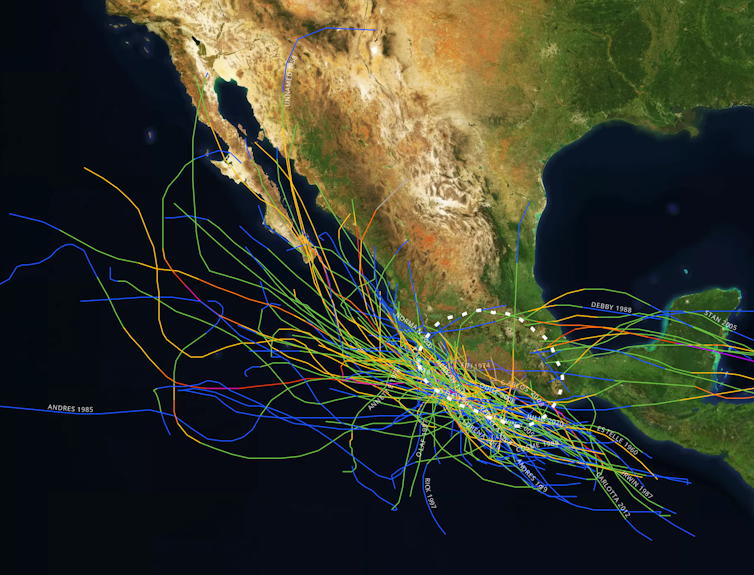
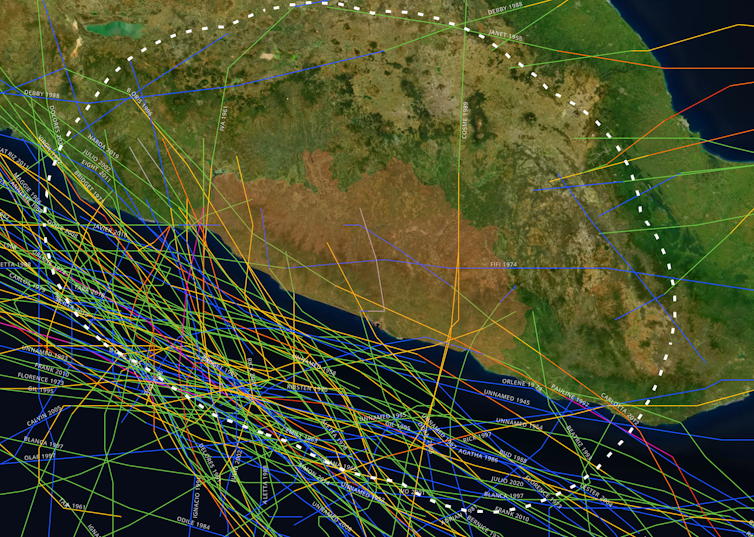
The probability wind maps for both return periods show Acapulco experiences lower average wind speeds than much of the 400 miles of Mexican coast north of the city. Yet, Acapulco is a major city, with a metropolitan population of over 1 million. It also has more than 50 buildings taller than 20 stories, according to the SkyscraperPage, a database of skyscrapers, and it is the only city with buildings that tall along that stretch of the Pacific coast.
Designing for a 50-year return period in this case is questionable, as it implies a near 100% chance of encountering wind exceeding this design value for a building with a 50-year life span or greater.
Florida Faces Similiar Challenges
The shortcomings of probabilistic-based maps that specify wind speeds have also been observed in the United States. For example, new buildings along most of Florida’s coast must be able to resist 140 mph winds or greater, but there are a few exceptions. One is the Big Bend area where Hurricane Idalia made landfall in 2023. Its design wind speed is about 120 mph instead.
A 2023 update to the Florida Building Code raised the minimum wind speed to approximately 140 mph in Mexico Beach, the Panhandle town that was devastated by Hurricane Michael in 2018. The Big Bend exception may be the next one to be eliminated.
Acapulco’s Earthquake Design Weakness
A saving grace for Acapulco is that it is located in one of Mexico’s most active seismic risk zones – for example, a magnitude 7 earthquake struck nearby in 2021. As a result, the lateral-load-resisting structural systems in tall buildings there are designed to resist seismic forces that are generally larger than hurricane forces.
However, a drawback is that the larger the mass of a building, the larger the seismic forces the building must be designed to resist. Consequently, light materials were typically used for the cladding – the exterior surface of the building that protects it against the weather – because that translates into lower seismic forces. This light cladding was not able to withstand hurricane-force winds.
Had the cladding not failed, the full wind forces would have been transferred to the structural system, and the buildings would have survived with little or no damage.
A ‘Good Engineering Approach’ To Hazards
A better building code could go one step beyond “good science” probabilistic maps and adopt a “good engineering approach” by taking stock of the consequences of extreme events occurring, not just the odds that they will.
In Florida, the incremental cost of designing for wind speeds of 140 mph rather than 120 mph is marginal compared to total building cost, given that cladding able to resist more than 140 mph is already used in nearly all of the state. In Acapulco, with the spine of buildings already able to resist earthquake forces much larger than hurricane forces, designing cladding that can withstand stronger hurricane-level forces is likely to be an even smaller percentage of total project cost.
Someday, the way that design codes deal with extreme events such as hurricanes, not only in Mexico, will hopefully evolve to more broadly account for what is at risk at the urban scale. Unfortunately, as I explain in “The Blessings of Disaster,” we will see more extreme disasters before society truly becomes disaster resilient.![]()
Michel Bruneau, Professor of Engineering, University at Buffalo
This article is republished from The Conversation under a Creative Commons license. Read the original article.
Pittwater Reserves: Histories + Notes + Pictorial Walks
A History Of The Campaign For Preservation Of The Warriewood Escarpment by David Palmer OAM and Angus Gordon OAM
A Stroll Around Manly Dam: Spring 2023 by Kevin Murray and Joe Mills
A Stroll Through Warriewood Wetlands by Joe Mills February 2023
A Walk Around The Cromer Side Of Narrabeen Lake by Joe Mills
America Bay Track Walk - photos by Joe Mills
An Aquatic June: North Narrabeen - Turimetta - Collaroy photos by Joe Mills
Angophora Reserve Angophora Reserve Flowers Grand Old Tree Of Angophora Reserve Falls Back To The Earth - History page
Annie Wyatt Reserve - A Pictorial
Aquatic Reflections seen this week (May 2023): Narrabeen + Turimetta by Joe Mills
Avalon's Village Green: Avalon Park Becomes Dunbar Park - Some History + Toongari Reserve and Catalpa Reserve
Bairne Walking Track Ku-Ring-Gai Chase NP by Kevin Murray
Bangalley Headland Bangalley Mid Winter
Bangalley Headland Walk: Spring 2023 by Kevin Murray and Joe Mills
Banksias of Pittwater
Barrenjoey Boathouse In Governor Phillip Park Part Of Our Community For 75 Years: Photos From The Collection Of Russell Walton, Son Of Victor Walton
Barrenjoey Headland: Spring flowers
Barrenjoey Headland after fire
Bayview Baths
Bayview Wetlands
Beeby Park
Bilgola Beach
Botham Beach by Barbara Davies
Bungan Beach Bush Care
Careel Bay Saltmarsh plants
Careel Bay Birds
Careel Bay Clean Up day
Careel Bay Playing Fields History and Current
Careel Creek
Careel Creek - If you rebuild it they will come
Centre trail in Ku-ring-gai Chase National Park
Chiltern Track- Ingleside by Marita Macrae
Clareville Beach
Clareville/Long Beach Reserve + some History
Coastal Stability Series: Cabbage Tree Bay To Barrenjoey To Observation Point by John Illingsworth, Pittwater Pathways, and Dr. Peter Mitchell OAM
Cowan Track by Kevin Murray
Curl Curl To Freshwater Walk: October 2021 by Kevin Murray and Joe Mills
Currawong and Palm Beach Views - Winter 2018
Currawong-Mackerel-The Basin A Stroll In Early November 2021 - photos by Selena Griffith
Currawong State Park Currawong Beach + Currawong Creek
Deep Creek To Warriewood Walk photos by Joe Mills
Drone Gives A New View On Coastal Stability; Bungan: Bungan Headland To Newport Beach + Bilgola: North Newport Beach To Avalon + Bangalley: Avalon Headland To Palm Beach
Duck Holes: McCarrs Creek by Joe Mills
Dunbar Park - Some History + Toongari Reserve and Catalpa Reserve
Dundundra Falls Reserve: August 2020 photos by Selena Griffith - Listed in 1935
Elsie Track, Scotland Island
Elvina Track in Late Winter 2019 by Penny Gleen
Elvina Bay Walking Track: Spring 2020 photos by Joe Mills
Elvina Bay-Lovett Bay Loop Spring 2020 by Kevin Murray and Joe Mills
Fern Creek - Ingleside Escarpment To Warriewood Walk + Some History photos by Joe Mills
Iluka Park, Woorak Park, Pittwater Park, Sand Point Reserve, Snapperman Beach Reserve - Palm Beach: Some History
Ingleside
Ingleside Wildflowers August 2013
Irrawong - Ingleside Escarpment Trail Walk Spring 2020 photos by Joe Mills
Irrawong - Mullet Creek Restoration
Katandra Bushland Sanctuary - Ingleside
Lucinda Park, Palm Beach: Some History + 2022 Pictures
McCarrs Creek
McCarr's Creek to Church Point to Bayview Waterfront Path
McKay Reserve
Mona Vale Beach - A Stroll Along, Spring 2021 by Kevin Murray
Mona Vale Headland, Basin and Beach Restoration
Mona Vale Woolworths Front Entrance Gets Garden Upgrade: A Few Notes On The Site's History
Mother Brushtail Killed On Barrenjoey Road: Baby Cried All Night - Powerful Owl Struck At Same Time At Careel Bay During Owlet Fledgling Season: calls for mitigation measures - The List of what you can do for those who ask 'What You I Do' as requested
Mount Murray Anderson Walking Track by Kevin Murray and Joe Mills
Mullet Creek
Narrabeen Creek
Narrabeen Lagoon Catchment: Past Notes Present Photos by Margaret Woods
Narrabeen Lagoon Entrance Clearing Works: September To October 2023 pictures by Joe Mills
Narrabeen Lagoon State Park
Narrabeen Lagoon State Park Expansion
Narrabeen Rockshelf Aquatic Reserve
Nerang Track, Terrey Hills by Bea Pierce
Newport Bushlink - the Crown of the Hill Linked Reserves
Newport Community Garden - Woolcott Reserve
Newport to Bilgola Bushlink 'From The Crown To The Sea' Paths: Founded In 1956 - A Tip and Quarry Becomes Green Space For People and Wildlife
Pittwater Reserves: The Green Ways; Bungan Beach and Bungan Head Reserves: A Headland Garden
Pittwater Reserves, The Green Ways: Clareville Wharf and Taylor's Point Jetty
Pittwater Reserves: The Green Ways; Hordern, Wilshire Parks, McKay Reserve: From Beach to Estuary
Pittwater Reserves - The Green Ways: Mona Vale's Village Greens a Map of the Historic Crown Lands Ethos Realised in The Village, Kitchener and Beeby Parks
Pittwater Reserves: The Green Ways Bilgola Beach - The Cabbage Tree Gardens and Camping Grounds - Includes Bilgola - The Story Of A Politician, A Pilot and An Epicure by Tony Dawson and Anne Spencer
Pittwater spring: waterbirds return to Wetlands
Pittwater's Lone Rangers - 120 Years of Ku-Ring-Gai Chase and the Men of Flowers Inspired by Eccleston Du Faur
Pittwater's Great Outdoors: Spotted To The North, South, East + West- June 2023: Palm Beach Boat House rebuild going well - First day of Winter Rainbow over Turimetta - what's Blooming in the bush? + more by Joe Mills, Selena Griffith and Pittwater Online
Pittwater's Parallel Estuary - The Cowan 'Creek
Resolute Track at West Head by Kevin Murray
Resolute Track Stroll by Joe Mills
Riddle Reserve, Bayview
Salvation Loop Trail, Ku-Ring-Gai Chase National Park- Spring 2020 - by Selena Griffith
Seagull Pair At Turimetta Beach: Spring Is In The Air!
Stapleton Reserve
Stapleton Park Reserve In Spring 2020: An Urban Ark Of Plants Found Nowhere Else
Stony Range Regional Botanical Garden: Some History On How A Reserve Became An Australian Plant Park
The Chiltern Track
The Chiltern Trail On The Verge Of Spring 2023 by Kevin Murray and Joe Mills
The Resolute Beach Loop Track At West Head In Ku-Ring-Gai Chase National Park by Kevin Murray
Topham Track Ku-Ring-Gai Chase NP, August 2022 by Joe Mills and Kevin Murray
Towlers Bay Walking Track by Joe Mills
Trafalgar Square, Newport: A 'Commons' Park Dedicated By Private Landholders - The Green Heart Of This Community
Tranquil Turimetta Beach, April 2022 by Joe Mills
Turimetta Beach Reserve by Joe Mills, Bea Pierce and Lesley
Turimetta Beach Reserve: Old & New Images (by Kevin Murray) + Some History
Turimetta Headland
Turimetta Moods by Joe Mills: June 2023
Turimetta Moods (Week Ending June 23 2023) by Joe Mills
Turimetta Moods: June To July 2023 Pictures by Joe Mills
Turimetta Moods: July Becomes August 2023 by Joe Mills
Turimetta Moods: August Becomes September 2023 ; North Narrabeen - Turimetta - Warriewood - Mona Vale photographs by Joe Mills
Turimetta Moods: Mid-September To Mid-October 2023 by Joe Mills
Warriewood Wetlands - Creeks Deteriorating: How To Report Construction Site Breaches, Weed Infestations + The Long Campaign To Save The Warriewood Wetlands & Ingleside Escarpment March 2023
Warriewood Wetlands and Irrawong Reserve
Whale Beach Ocean Reserve: 'The Strand' - Some History On Another Great Protected Pittwater Reserve
Wilshire Park Palm Beach: Some History + Photos From May 2022
Winji Jimmi - Water Maze

Pittwater's Birds
Australian Predators of the Sky by Penny Olsen - published by National Library of Australia
Australian Raven Australian Wood Duck Family at Newport
A Week In Pittwater Issue 128 A Week In Pittwater - June 2014 Issue 168
Baby Birds Spring 2015 - Rainbow Lorikeets in our Yard - for Children Baby Birds by Lynleigh Greig, Southern Cross Wildlife Care - what do if being chased by a nesting magpie or if you find a baby bird on the ground
Baby Kookaburras in our Backyard: Aussie Bird Count 2016 - October
Balloons Are The Number 1 Marine Debris Risk Of Mortality For Our Seabirds - Feb 2019 Study
Bangalley Mid-Winter Barrenjoey Birds Bird Antics This Week: December 2016
Bird of the Month February 2019 by Michael Mannington
Birdland Above the Estuary - October 2012 Birds At Our Window Birds at our Window - Winter 2014 Birdland June 2016
Birdsong Is a Lovesong at This time of The Year - Brown Falcon, Little Wattle Bird, Australian Pied cormorant, Mangrove or Striated Heron, Great Egret, Grey Butcherbird, White-faced Heron
Bird Songs – poems about our birds by youngsters from yesterdays - for children Bird Week 2015: 19-25 October
Bird Songs For Spring 2016 For Children by Joanne Seve
Birds at Careel Creek this Week - November 2017: includes Bird Count 2017 for Local Birds - BirdLife Australia by postcode
Black Cockatoo photographed in the Narrabeen Catchment Reserves this week by Margaret G Woods - July 2019
Black-Necked Stork, Mycteria Australis, Now Endangered In NSW, Once Visited Pittwater: Breeding Pair shot in 1855
Black Swans on Narrabeen Lagoon - April 2013 Black Swans Pictorial
Endangered Little Tern Fishing at Mona Vale Beach
‘Feather Map of Australia’: Citizen scientists can support the future of Australia's wetland birds: for Birdwatchers, school students and everyone who loves our estuarine and lagoon and wetland birds
Fledgling Common Koel Adopted by Red Wattlebird -Summer Bird fest 2013 Flegdlings of Summer - January 2012
Flocks of Colour by Penny Olsen - beautiful new Bird Book Celebrates the 'Land of the Parrots'
Friendly Goose at Palm Beach Wharf - Pittwater's Own Mother Goose
Front Page Issue 177 Front Page Issue 185 Front Page Issue 193 - Discarded Fishing Tackle killing shorebirds Front Page Issue 203 - Juvenile Brush Turkey Front Page Issue 208 - Lyrebird by Marita Macrae Front Page Issue 219 Superb Fairy Wren Female Front Page Issue 234: National Bird Week October 19-25 and the 2015 the Aussie Back Yard Bird Count: Australia's First Bird Counts - a 115 Year Legacy - with a small insight into our first zoos Front Page Issue 236: Bird Week 2015 Front Page Issue 244: watebirds Front Page Issue 260: White-face Heron at Careel Creek Front Page Issue 283: Pittwater + more birds for Bird Week/Aussie Bird Count Front Page Issue 284: Pittwater + more birds for Bird Week/Aussie Bird Count Front Page Issue 285: Bird Week 2016 Front Page Issue 331: Spring Visitor Birds Return
G . E. Archer Russell (1881-1960) and His Passion For Avifauna From Narrabeen To Newport
Glossy Black-Cockatoo Returns To Pittwater by Paul Wheeler Glossy Cockatoos - 6 spotted at Careel Bay February 2018
Grey Butcher Birds of Pittwater
INGLESIDE LAND RELEASE ON AGAIN BUT MANY CHALLENGES AHEAD by David Palmer
Issue 60 May 2012 Birdland - Smiles- Beamings -Early -Winter - Blooms
Jayden Walsh’s Northern Beaches Big Year - courtesy Pittwater Natural Heritage Association
John Gould's Extinct and Endangered Mammals of Australia by Dr. Fred Ford - Between 1850 and 1950 as many mammals disappeared from the Australian continent as had disappeared from the rest of the world between 1600 and 2000! Zoologist Fred Ford provides fascinating, and often poignant, stories of European attitudes and behaviour towards Australia's native fauna and connects these to the animal's fate today in this beautiful new book - our interview with the author
July 2012 Pittwater Environment Snippets; Birds, Sea and Flowerings
Juvenile Sea Eagle at Church Point - for children
King Parrots in Our Front Yard
Kookaburra Turf Kookaburra Fledglings Summer 2013 Kookaburra Nesting Season by Ray Chappelow Kookaburra Nest – Babies at 1.5 and 2.5 weeks old by Ray Chappelow Kookaburra Nest – Babies at 3 and 4 weeks old by Ray Chappelow Kookaburra Nest – Babies at 5 weeks old by Ray Chappelow Kookaburra and Pittwater Fledglings February 2020 to April 2020
Lion Island's Little Penguins (Fairy Penguins) Get Fireproof Homes - thanks to NSW National Parks and Wildlife Service and the Fix it Sisters Shed
Lyre Bird Sings in Local National Park - Flock of Black Cockatoos spotted - June 2019
Magpie's Melodic Melodies - For Children (includes 'The Magpie's Song' by F S Williamson)
Masked Lapwing (Plover) - Reflected
May 2012 Birdland Smiles Beamings Early Winter Blooms
Musk Lorikeets In Pittwater: Pittwater Spotted Gum Flower Feast - May 2020
Nankeen Kestrel Feasting at Newport: May 2016
National Bird Week 2014 - Get Involved in the Aussie Backyard Bird Count: National Bird Week 2014 will take place between Monday 20 October and Sunday 26 October, 2014. BirdLife Australia and the Birds in Backyards team have come together to launch this year’s national Bird Week event the Aussie Backyard Bird Count! This is one the whole family can do together and become citizen scientists...
National Bird Week October 19-25 and the 2015 the Aussie Back Yard Bird Count: Australia's First Bird Counts - a 115 Year Legacy - with a small insight into our first zoos
Nature 2015 Review Earth Air Water Stone
New Family of Barking Owls Seen in Bayview - Church Point by Pittwater Council
Noisy Visitors by Marita Macrae of PNHA
Odes to Australia's Fairy-wrens by Douglas Brooke Wheelton Sladen and Constance Le Plastrier 1884 and 1926
Oystercatcher and Dollarbird Families - Summer visitors
Painted Button-Quail Rescued By Locals - Elanora-Ingleside escarpment-Warriewood wetlands birds
Palm Beach Protection Group Launch, Supporters Invited: Saturday Feb.16th - Residents Are Saying 'NO' To Off-Leash Dogs In Station Beach Eco-System - reports over 50 dogs a day on Station Beach throughout December-January (a No Dogs Beach) small children being jumped on, Native birds chased, dog faeces being left, families with toddlers leaving beach to get away from uncontrolled dogs and 'Failure of Process' in council 'consultation' open to February 28th
Pardalote, Scrub Wren and a Thornbill of Pittwater
Pecking Order by Robyn McWilliam
Pelican Lamps at Narrabeen Pelican Dreamsong - A Legend of the Great Flood - dreamtime legend for children
Pittwater Becalmed Pittwater Birds in Careel Creek Spring 2018 Pittwater Waterbirds Spring 2011 Pittwater Waterbirds - A Celebration for World Oceans Day 2015
Pittwater's Mother Nature for Mother's Day 2019
Plastic in 99 percent of seabirds by 2050 by CSIRO
Plover Appreciation Day September 16th 2015
Powerful and Precious by Lynleigh Grieg
Red Wattlebird Song - November 2012
Restoring The Diamond: every single drop. A Reason to Keep Dogs and Cats in at Night.
Return Of Australasian Figbird Pair: A Reason To Keep The Trees - Aussie Bird Count 2023 (16–22 October) You can get involved here: aussiebirdcount.org.au
Sea Birds off the Pittwater Coast: Albatross, Gannet, Skau + Australian Poets 1849, 1898 and 1930, 1932
Sea Eagle Juvenile at Church Point
Seen but Not Heard: Lilian Medland's Birds - Christobel Mattingley - one of Australia's premier Ornithological illustrators was a Queenscliff lady - 53 of her previously unpublished works have now been made available through the auspices of the National Library of Australia in a beautiful new book
7 Little Ducklings: Just Keep Paddling - Australian Wood Duck family take over local pool by Peta Wise
Shag on a North Avalon Rock - Seabirds for World Oceans Day 2012
Short-tailed Shearwaters Spring Migration 2013
South-West North-East Issue 176 Pictorial
Spring 2012 - Birds are Splashing - Bees are Buzzing
Spring Becomes Summer 2014- Royal Spoonbill Pair at Careel Creek
Spring Notes 2018 - Royal Spoonbill in Careel Creek
Station Beach Off Leash Dog Area Proposal Ignores Current Uses Of Area, Environment, Long-Term Fauna Residents, Lack Of Safe Parking and Clearly Stated Intentions Of Proponents have your say until February 28, 2019
Summer 2013 BirdFest - Brown Thornbill Summer 2013 BirdFest- Canoodlers and getting Wet to Cool off Summer 2013 Bird Fest - Little Black Cormorant Summer 2013 BirdFest - Magpie Lark
North Narrabeen's Laura Enever Sets New World Record For Largest Wave Surfed Paddle-In (Female)
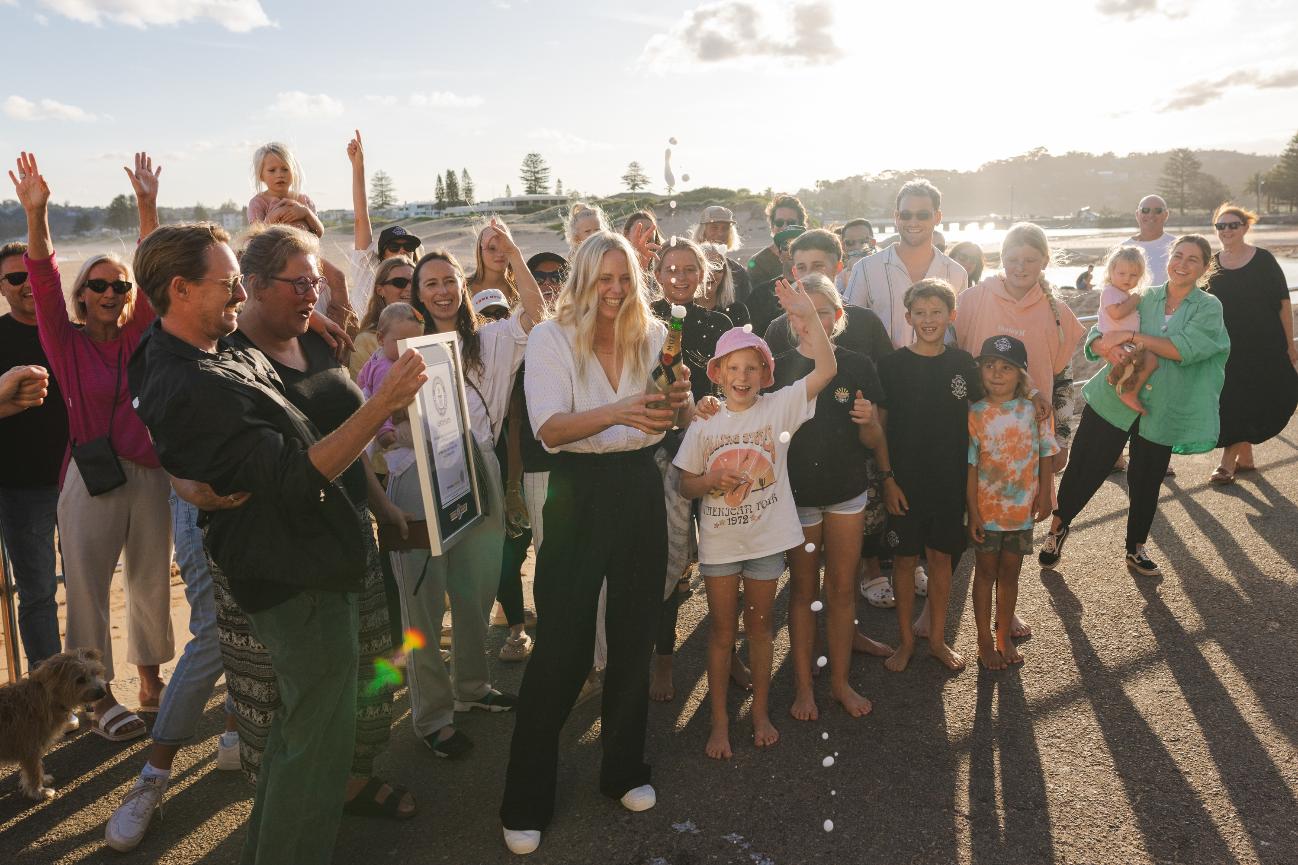
- Enever’s Record-Setting Ride Measured at 43.6 Feet (13.3 Meters)
- More Available at WorldSurfLeague.com/bigwave
Wednesday, November 8, 2023
The World Surf League (WSL) announces that Laura Enever (AUS) has set a new GUINNESS WORLD RECORDS™ title for the Largest wave surfed paddle-in (female). The WSL officially analysed, measured, and verified Enever’s 2023 record-breaking ride at 43.6 feet (13.3 meters) as part of the WSL Big Wave Record Chase, making it the biggest wave ever paddled into by a woman.
Enever, who is 31 years old and from North Narrabeen, successfully surfed a wave measuring 43.6 feet (13.3 meters) from trough to crest at Outer Reef, the big-wave break on the North Shore of Oahu, on January 22, 2023.
“I knew it was big when I paddled into it, and then when I took off, I looked down, and I knew it was definitely the biggest wave I've ever caught,” said Enever. “I knew it was the wave of my life, the whole way it all came together and the way I committed, backed myself, told myself to go, and trusted I could do it. The ride was such a breakthrough for me and a moment that will be special and monumental in my surf career. To get awarded this months later is really cool, I can't believe it.
“I would never be in this position if it wasn't for all the big wave surfers who have come before me and paved the way, especially the really brave, courageous females who have always inspired me and made me feel like I could get out there and give it a crack. So, thank you to all the amazing women. I'm just constantly in awe. Andrea Moller held this record before me, and it's an honor to hold that record and keep pushing big wave surfing. And I know that the next girls, the next generation of female big wave surfers, are going to do the same.”
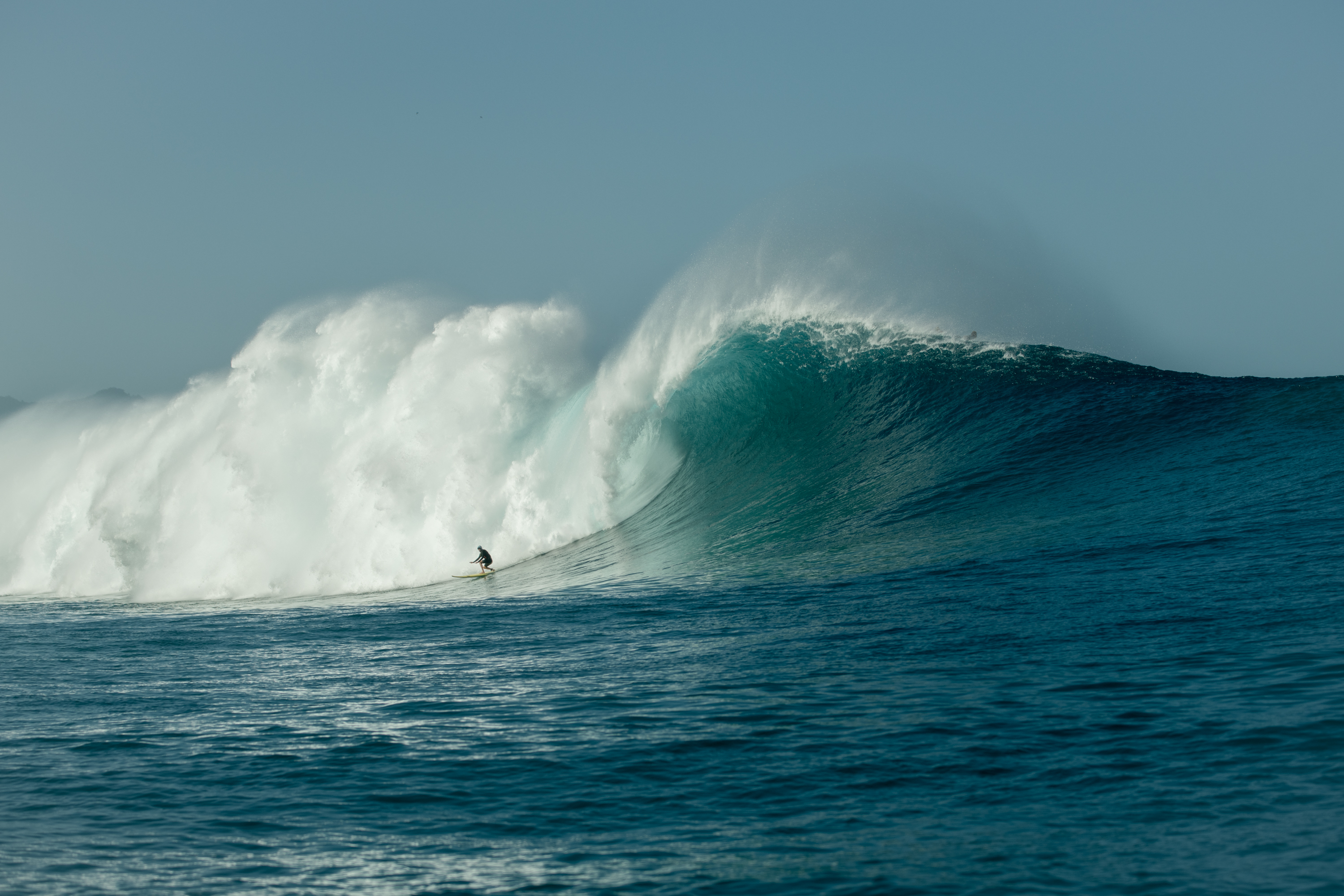
Photo; WSL / Daniel Russo
Enever’s World Record adds to an already stellar surfing career. She was the ISA Junior World Champion and Triple Crown Rookie of the Year in 2008, and World Junior Champion in 2009. In 2011, Enever qualified for the WSL Championship Tour, where she competed for seven years, consistently finishing in the Top 10. She has gone on to compete in WSL Big Wave events and push the limits of big wave surfing.
“Huge congratulations to Laura for this incredible achievement,” said Jessi Miley-Dyer, WSL Chief of Sport. “Laura is fearless, committed, and a real inspiration, and I’m so proud to celebrate her. These World Records really allow us to shine the spotlight on athletes like Laura who are pushing the boundaries of Big Wave surfing.”
Enever was awarded the GUINNESS WORLD RECORDS™ certificate in her hometown of Narrabeen in New South Wales, Australia, where she celebrated the accomplishment with her family and friends.
“I've worked my whole life to be a professional surfer and to be on the World Tour,” continued Enever. “I was there, and I gave that up for this pull and urge to surf big waves. I was just thinking I just wanted to go do this for me, and to be here today and to have a GUINNESS WORLD RECORDS™ title for the biggest paddle, I can't believe it.”
Enever’s record bettered Andrea Moller’s previous record by just one foot, which was caught on January 16, 2016, at Pe’ahi, Maui. Moller, an internationally recognized waterwomen, pioneer of big wave surfing, and respected paramedic, held the record for seven years. She was the first woman to paddle into a wave at Pe’ahi, the first woman to catch a wave in the prestigious Eddie Aikau big wave contest, and an advocate for equality and progression in big wave surfing.
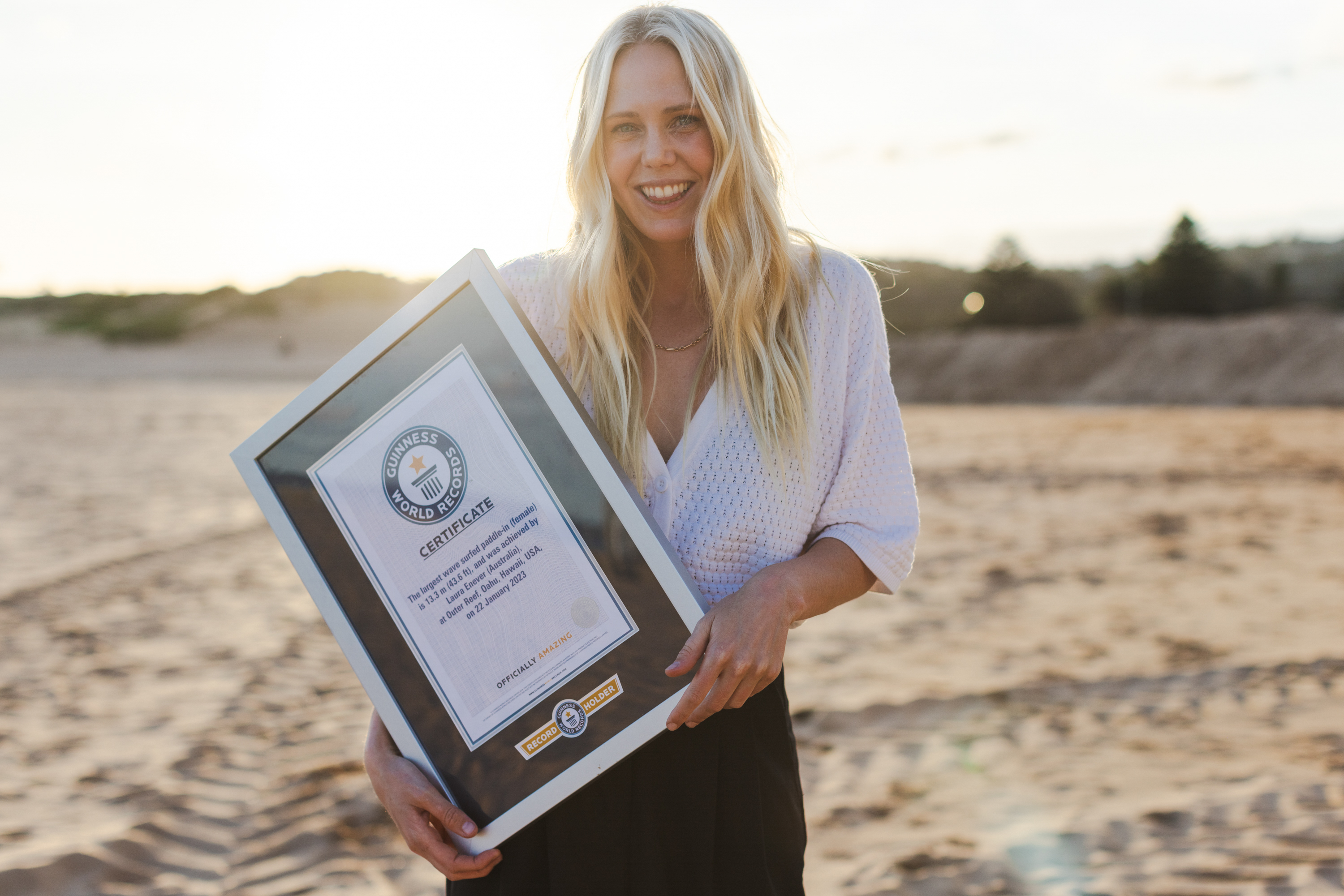
Photo: WSL / Matt Dunbar
About the Measurement Process
The WSL Science Team, led by Michal Pieszk, Senior Research and Development Engineer of the Kelly Slater Wave Company (KSWC), collaborated on the analysis of the largest waves ridden in the Paddle-In category during the 2022/23 WSL Big Wave Record Chase season. The team used a range of wave-measuring techniques using video footage, detailed information about the site, the location of the videographers and location of the wave, to determine the wave height
Several frames from the video footage were extracted and geometrically corrected based on camera positions and angles. Using known objects such as jet skis and actual measurements of Enever’s body geometry, it was possible to calibrate the images for conversion from pixels to feet. The location of the trough and crest of the wave was determined from analysis of the video from two different angles.
For more information, please visit WorldSurfLeague.com.
Australian Schoolgirls Sevens Teams Announced: Congratulations Khyliah, Lili And Brooke!
The Australian Schools Rugby Union ‘ASRU’ is delighted to announce the Australian Schoolgirls Sevens Team 2023. The team will represent Australia at the Global Youth Sevens tournament, to be held on the Gold Coast 9-10 December 2023.
Announced in early October, three local athletes form part of the team; Khyliah Gray, Lili Boyle and Brooke Bosland.
“I am very proud to announce the inaugural Australian Schoolgirls Sevens Team which will represent Australia at the Global Youth Sevens tournament in December,” said Sarah Ridgewell, ASRU executive responsible for Girl’s Sevens.
“This is a very exciting development for the Australian Schools Rugby Union ‘ASRU’ and all female student athletes.
“The ASRU has a proud and established tradition with the Australian Schoolboys XVs teams, and we know that the Australian Schoolgirls Sevens will follow this path, offering extraordinary opportunities for our student athletes.
“I would like to thank all the teachers, schools and School Sport bodies around the country for supporting this high performance pathway for our female student athletes.
“I would also like to thank Rugby Australia for their ongoing support with our program, transitioning our female athletes and staff into the high performance sevens space. For many of the girls in this inaugural team, this is their first step to fulfilling their aspirations of a professional rugby career and of course Olympic honours.
“We wish the girls all possible success at the Global Youth Sevens.”
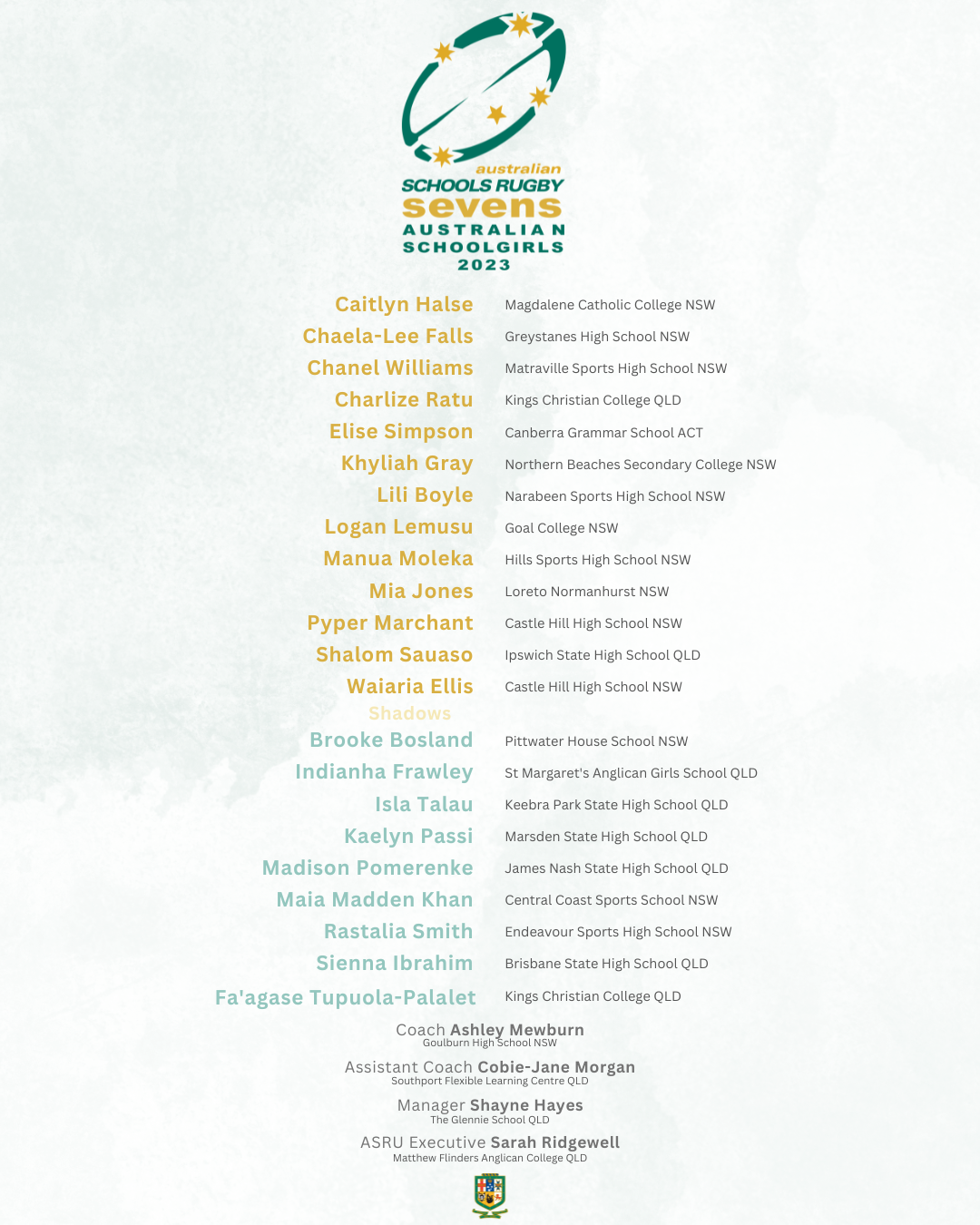
Manly Junior Class NSW - Round 1 Regatta
- Round 1 will be hosted by Royal Prince Alfred Yacht Club (RPAYC) on 25 & 26 November 2023.
- Round 2 will be hosted by Hornsby Ku-ring-gai Sailing Club (HKSC) on 10 & 11 February 2024.
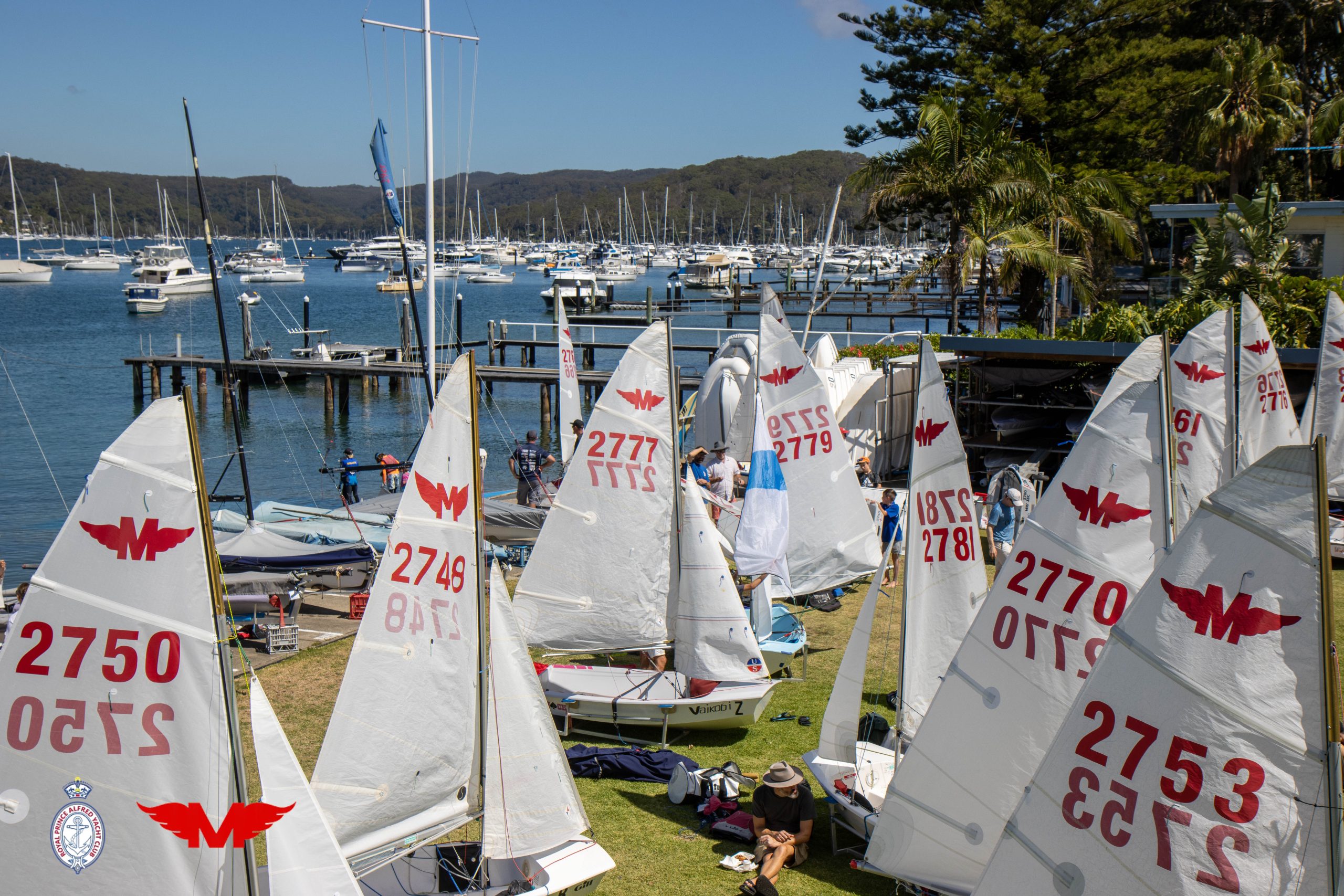
Warning: Multiple Types Of High-Dose MDMA Tablets (Ecstasy) Circulating In NSW
- blue diamond shaped tablet with ‘punisher’ logo contained 216 mg MDMA
- blue skull shaped tablet with ‘MYBRAND’ logo and text contained 216 mg MDMA
- yellow square tablet with ‘SpongeBob’ smiley face markings contained 160 mg MDMA.


The Cocos (Keeling) Islands. Australian Colour Diary 12
Published 10 Nov 2023 by NFSA
From the Film Australia Collection. Made by The National Film Board 1960. Directed by Jack S Allan. The Cocos (Keeling) Islands, Northwest of Australia in the Indian Ocean, provide a valuable link for Australia to the rest of the world.
School Leavers Support
- Download or explore the SLIK here to help guide Your Career.
- School Leavers Information Kit (PDF 5.2MB).
- School Leavers Information Kit (DOCX 0.9MB).
- The SLIK has also been translated into additional languages.
- Download our information booklets if you are rural, regional and remote, Aboriginal or Torres Strait Islander, or living with disability.
- Support for Regional, Rural and Remote School Leavers (PDF 2MB).
- Support for Regional, Rural and Remote School Leavers (DOCX 0.9MB).
- Support for Aboriginal and/or Torres Strait Islander School Leavers (PDF 2MB).
- Support for Aboriginal and/or Torres Strait Islander School Leavers (DOCX 1.1MB).
- Support for School Leavers with Disability (PDF 2MB).
- Support for School Leavers with Disability (DOCX 0.9MB).
- Download the Parents and Guardian’s Guide for School Leavers, which summarises the resources and information available to help you explore all the education, training, and work options available to your young person.
School Leavers Information Service
- navigate the School Leavers Information Kit (SLIK),
- access and use the Your Career website and tools; and
- find relevant support services if needed.
Word Of The Week: Artist
Noun
1. a person who creates art (such as painting, sculpture, music, or writing) using conscious skill and creative imagination. 2. a person who works in one of the performing arts, as an actor, musician, or singer; a public performer: a mime artist; an artist of the dance. 3. a person skilled in any of the arts. 4. a skilled performer. 5. a skilled performer
Also: obsolete : one skilled or versed in learned arts. archaic : a PHYSICIAN and archaic : an ARTISAN
From 1580s, "one who cultivates one of the fine arts," from French artiste (14c.), from Italian artista, from Medieval Latin artista, from Latin ars. Originally especially of the arts presided over by the Muses (history, poetry, comedy, tragedy, music, dancing, astronomy), but also used 17c. for "one skilled in any art or craft" (including professors, surgeons, craftsmen, cooks). Since mid-18c. especially of "one who practices the arts of design or visual arts."
From early 13c., "skill as a result of learning or practice," from Old French art (10c.), from Latin artem (nominative ars) "work of art; practical skill; a business, craft," from ar(ə)-ti- (source also of Sanskrit rtih "manner, mode;" Greek artizein "to prepare"), suffixed form of root ar- "to fit together." Etymologically akin to Latin arma "weapons" , also arə-, Proto-Indo-European root meaning "to fit together."
In Middle English usually with a sense of "skill in scholarship and learning" (c. 1300), especially in the seven sciences, or liberal arts. This sense remains in Bachelor of Arts, etc. The meaning "human workmanship" (as opposed to nature) is from late 14c. The meaning "system of rules and traditions for performing certain actions" is from late 15c. The sense of "skill in cunning and trickery" is attested by late 16c. (the sense in artful, artless). The meaning "skill in creative arts" is recorded by 1610s; especially of painting, sculpture, etc., from 1660s.
The source of/evidence for this words' existence provided by: Sanskrit irmah "arm," rtih "manner, mode;" Armenian arnam "make," armukn "elbow;" Greek arti "just," artios "complete, suitable," artizein "to prepare," arthron "a joint;" Latin ars (stem art-) "art, skill, craft," armus "shoulder," artus "joint," arma "weapons;" Old Prussian irmo "arm;" German art "manner, mode."
Compare Artisan: 1. a worker who practices a trade or handicraft: craftsperson. a skilled artisan. 2. a person or company that produces something (such as cheese or wine) in limited quantities often using traditional methods.
The term “artisan” originates back in the middle ages. Borrowed from the French, the term was given to those who worked in a skilled trade; making pieces or providing certain services. During the Middle Ages, the term "artisan" was applied to those who made things or provided services. It did not apply to unskilled manual labourers. Artisans were divided into two distinct groups: those who operated their own businesses and those who did not. The former were called masters, while the latter were the journeymen and apprentices.
One misunderstanding many people have about this social group is that they picture them as "workers" in the modern sense: employed by someone. The most influential group among the artisans were the masters, the business owners. The owners enjoyed a higher social status in their communities, and often organised into guilds.
An artisan (from French: artisan, Italian: artigiano) is a skilled craft worker who makes or creates material objects partly or entirely by hand. These objects may be functional or strictly decorative, for example furniture, decorative art, sculpture, clothing, food items, household items, and tools and mechanisms such as the handmade clockwork movement of a watchmaker. Artisans practice a craft and may through experience and aptitude reach the expressive levels of an artist.
The adjective "artisanal" is often used in describing hand-processing in contrast to an industrial process, such as in the phrase artisanal mining. Thus, "artisanal" is sometimes used in marketing and advertising as a buzz word to describe or imply some relation with the crafting of handmade food products, such as bread, beverages, cheese or textiles. Many of these have traditionally been handmade, rural or pastoral goods but are also now commonly made on a larger scale with automated mechanisation in factories and other industrial areas.
Artisans were the dominant producers of commodities before the Industrial Revolution. In ancient Greece, artisans were drawn to agoras (central public space in ancient Greek city-states) and often built workshops nearby.
A guild is an association of artisans and merchants who oversee the practice of their craft/trade in a particular territory. The earliest types of guild formed as organizations of tradespeople belonging to a professional association. They sometimes depended on grants of letters patent from a monarch or other ruler to enforce the flow of trade to their self-employed members, and to retain ownership of tools and the supply of materials, but most were regulated by the local government. Guild members found guilty of cheating the public would be fined or banned from the guild. A lasting legacy of traditional guilds are the guildhalls constructed and used as guild meeting-places.
Typically the key "privilege" was that only guild members were allowed to sell their goods or practice their skill within the city. There might be controls on minimum or maximum prices, hours of trading, numbers of apprentices, and many other things. Critics argued that these rules reduced free competition, but defenders maintained that they protected professional standards.
One of the legacies of the guilds: the elevated Windsor Guildhall originated as a meeting place for guilds, as well as a magistrates' seat and town hall.
An important result of the guild framework was the emergence of universities at Bologna (established in 1088), Oxford (at least since 1096) and Paris (c. 1150); they originated as guilds of students (as at Bologna) or of masters (as at Paris).
The Artisan class included: Armorer, Blacksmith, Bladesmith, Cooper, Dyer, Furrier, Glassblowing, Gunsmith, Hatter, Joiner, Locksmith, Nailsmith, Potter, Ropemaker, Saddler, Shoemaker, Stonemason, Tailor, Tanner, Weaver, Wheelwright.
Shokunin is a Japanese word for "artisan" or "craftsman", which also implies a pride in one's own work. In the words of shokunin Tashio Odate:
Shokunin means not only having technical skill, but also implies an attitude and social consciousness... a social obligation to work his best for the general welfare of the people, [an] obligation both material and spiritual.
Traditionally, shokunin honoured their tools of trade at New Year's – the sharpened and taken-care of tools would be placed in a tokonoma (a container or box still found in Japanese houses and shops), and two rice cakes and a tangerine (on top of rice paper) were placed on top of each toolbox, to honour the tools and express gratitude for performing their task.
The 8-hour day
Australian stonemasons were responsible for bringing about the 8 hour day in Australia. The National Museum of Australia provides the following insight:
Between 1830 and 1833 the first Australian unions were formed by associations of skilled workers such as shipwrights, printing compositors and cabinet-makers.
However, these early trade unions faced stiff opposition from employers and government. In 1840 the government used convict compositors to help break a strike by the Society of Compositors.
As the colony started to grow in the early part of the 19th century, new businesses, including many shops, started up. With the advent of street lighting in 1841, shop employees had to work later and later until they were typically working 14 hours a day. Such long hours led to the formation of the Early Closing Movement, which in 1844 sought to have working hours reduced from 14 to 12 hours a day.
Convict transportation to New South Wales ceased in 1840. From then, all new felons were diverted to Tasmania, which led to the formation in 1847 of the Anti-Transportation League in that colony. The league succeeded in stopping transportation to the east coast by 1852. The end of transportation created a shortage of workers that increased dramatically through the 1850s as a great many working men moved to the goldfields. Unions were now in a much better position to campaign for better working conditions.
Eight-hour day campaign
On 4 February 1853 the Operative Masons’ Society was re-formed at a meeting in Clark’s Hotel, Collingwood, Melbourne. The union had suspended operations because so many members had moved to the goldfields. One of the organisers was James Stephens, a mason recently arrived from Britain where he had been a member of the Chartist movement, which advocated for a more representative parliamentary system. He had participated in the 1839 Newport Rising riot where police killed 20 Chartist protesters.
The resurrection of the Operative Masons’ Society is viewed as the start of the eight-hour movement in Australia, because a committee was formed to confer with building contractors on the introduction of the eight-hour day. The eight-hour day had first been proposed by Robert Owen in 1817 at his socialist community in New Lanark, Scotland. The sentiments of the movement were captured by the slogan, ‘Eight hours labour, eight hours recreation, eight hours rest’.
The union put forward three main arguments for a shorter working day. The first was that Australia’s harsh climate demanded reduced hours. The second was that labourers needed time to develop their ‘social and moral condition’ through education. The third was that workers would be better fathers, husbands and citizens if they were allowed adequate leisure time.
On 26 March 1856 workers called a public meeting at the Queen’s Theatre to make a stand on improving working conditions. At the meeting it was announced that ‘the time has arrived when the system of 8 hours should be introduced into the building trades and that after the 21st of this month we promise to work 8 hours and no longer’.
Negotiations between the union and the building companies broke down and on 21 April 1856 stonemasons, led by Stephens, downed tools at the construction site of the law faculty buildings at Melbourne University and walked off the job.
As Stephens said, ‘It was a burning hot day and I thought the occasion a good one, so I called upon the men to follow me, to which they immediately consented, when I marched them … to Parliament House.’
Stonemasons from other construction sites along the way joined the march until they eventually reached the Belvedere Hotel where a banquet was organised to mark the event.
In the months to come, negotiations with employers and the government continued until an agreement was reached whereby stonemasons would work an eight-hour day but collect the same wage they had previously been paid for 10 hours.
Initially only a minority of workers, mainly in the building trades, won the eight-hour day. Most workers, including women and children, generally worked longer hours for less pay.
The fight for working conditions continued throughout the 19th century. It was not until 1916 that the Eight Hours Act was passed in Victoria and New South Wales.

An eight-hour day parade in Bourke Street, Melbourne, 1907. Image NMA
It would not be until January 1948 that the Commonwealth Arbitration Court approved a 40-hour, five-day working week for all Australians.

A Labor Day march in Sydney in the 1930s.
A 19th-century workers ditty:
Eight hours to work,
Eight hours to play,
Eight hours to sleep,
Eight bob a day.
A fair day’s work,
For a fair day’s pay.
5 Aussie musicals you might not have heard of – but really should see

When you think of great Aussie musicals, some key films from the 1990s and 2000s come to mind: Strictly Ballroom, Muriel’s Wedding, Moulin Rouge!, Bran Nue Dae and The Sapphires. These films are often framed as “reviving” the musical genre for Australian audiences, due in large part to their box-office success.
While certainly fantastic films, there is actually a long history of Aussie musicals that have been popular with cinema audiences since the 1930s.
There are 73 films that have been classified as a “musical” or containing musical elements by the National Film and Sound Archive. They include comedies, children’s and animated films, dramas, revues, backstage musicals, biopics, dance films, rock musicals, soundtrack films, television musicals and live concert films.
So where to begin? These are my top five Aussie musicals you may not have heard of but should definitely try to see.
These films represent just a snapshot of the rich history of musical cinema in Australia. They demonstrate how Australian cinema responds to international trends in musical cinema production, but also how it influences and innovates in the global musical genre.
These films are hard to get a hold of and only occasionally pop up on streaming services – if at all. However, you might catch them on DVD or at your local indie film festival or retrospective (there were several screenings of Starstruck when the NFSA released a digitally restored version in 2015).
1. Funny Things Happen Down Under
Olivia Newton-John’s 1965 debut feature, Funny Things Happen Down Under, directed by Joe McCormick, was an adaptation of the Terrible Ten children’s television show from 1959–60.
It’s Christmas time in the bush and a group of country children make a plan to save their woolshed, under threat because the sheep station has to be sold.
After they accidentally turn a goat’s wool multi-coloured because it drinks a strange concoction of Christmas pudding, flowers and fizzy water, they decide to feed it to the sheep to sell rainbow-coloured wool.
While certainly of its time (there is a scene that involves yellow face), the film has some great songs by Newton-John and New Zealand singer Howard Morrison, as well as an athletic final dance number around the shed called Click Go the Shears.
2. Oz
Directed by Chris Lofven, the 1976 film Oz (also known as Oz: A Rock ‘n’ Roll Road Movie, or 20th Century Oz on its release in the United States) is a version of The Wizard of Oz as a rock ‘n’ roll road movie set in the Australian outback.
Dorothy (Joy Dunstan) is hitchhiking to the city to see glam rocker The Wizard. Along the way she meets brainless surfie (Bruce “Stork” Spence) – the scarecrow – a mean mechanic (Michael Carman) – the tin man – and an overly confident bikie (Gary Waddell) – the lion.
Ross Wilson, the frontman of Daddy Cool and Mondo Rock, wrote and produced Oz’s musical score. The singles Livin’ in the Land of Oz by Wilson and Beating Around the Bush by Jo Jo Zep and the Falcons were both released in 1976 from the soundtrack.
Much like motorcycle road movie Easy Rider (1970), which had become a symbol of New Hollywood, Oz made a direct appeal to young audiences and the counterculture via a compilation soundtrack of contemporary popular music.
3. Starstruck
Gillian Armstrong’s Starstruck (1982) is a backstage musical set in 1980s Sydney. Barmaid Jackie (Jo Kennedy) lives above her family pub The Harbour View Hotel in The Rocks in Sydney with her mum, Nanna, cousin Angus and their pet cockatoo.
Jackie dreams of being a star, falls for a guitarist and joins a band called The Wombats so they can enter a TV talent competition.
Cue numerous musical numbers including Body and Soul, where Jackie dances on the bar, and an eventual performance at the Opera House after the band sneak on stage.
There’s also a fabulously camp Busby Berkeley-eque rooftop swimming pool number complete with co-ordinated lifeguards in speedos.
4. Dogs In Space
Rather than a traditional musical, Richard Lowenstein’s Dogs in Space (1986) is set in the underground punk scene in late 1970s Melbourne. It follows rocker Sammy (played by Aussie icon Michael Hutchence) through performing, partying, falling in love – and taking lots and lots of drugs.
The film has some amazing cinematography with winding long takes of the cast at their crammed inner-city terrace house as it gets progressively trashed by party after party.
Sammy’s love story with girlfriend Anna (Saskia Post) ends in tragedy and the final song, Rooms for the Memory, effectively uses Hutchence’s brooding star presence and vocals to great effect.
5. One Night The Moon
Based on true events from 1932, One Night the Moon (2001), written by First Nations director Rachel Perkins, features Aussie singer-songwriter Paul Kelly as the father of a girl (played by Memphis Kelly, his real daughter) who goes missing in the outback.
The girl’s mother (played by Kelly’s then wife and Memphis’ mother, Kaarin Fairfax) wants to employ an Aboriginal tracker (Kelton Pell) to help find the girl. Her father refuses, thus sealing the fate of his daughter through his prejudice.
With haunting songwriting and sweeping shots of the unforgiving landscape, this is a beautiful and moving story. ![]()
Phoebe Macrossan, Lecturer in Screen Media, University of the Sunshine Coast
This article is republished from The Conversation under a Creative Commons license. Read the original article.
How we’re building the world’s biggest optical telescope to crack some of the greatest puzzles in science

Astronomers get to ask some of the most fundamental questions there are, ranging from whether we’re alone in the cosmos to what the nature of the mysterious dark energy and dark matter making up most of the universe is.
Now a large group of astronomers from all over the world is building the biggest optical telescope ever – the Extremely Large Telescope (ELT) — in Chile. Once construction is completed in 2028, it could provide answers that transform our knowledge of the universe.
With its 39-metre diameter primary mirror, the ELT will contain the largest, most perfect reflecting surface ever made. Its light-collecting power will exceed that of all other large telescopes combined, enabling it to detect objects millions of times fainter than the human eye can see.
There are several reasons why we need such a telescope. Its incredible sensitivity will let it image some of the first galaxies ever formed, with light that has travelled for 13 billion years to reach the telescope. Observations of such distant objects may allow us to refine our understanding of cosmology and the nature of dark matter and dark energy.
Alien Life
The ELT may also offer an answer to the most fundamental question of all: are we alone in the universe? The ELT is expected to be the first telescope to track down Earth-like exoplanets — planets that orbit other stars but have a similar mass, orbit and proximity to their host as Earth.
Occupying the so-called Goldilocks zone, these Earth-like planets will orbit their star at just the right distance for water to neither boil nor freeze – providing the conditions for life to exist.

The ELT’s camera will have six times better resolution than that of the James Webb Space Telescope, allowing it to take the clearest images yet of exoplanets. But fascinating as these pictures will be, they will not tell the whole story.
To learn if life is likely to exist on an exoplanet, astronomers must complement imaging with spectroscopy. While images reveal shape, size and structure, spectra tell us about the speed, temperature and even the chemistry of astronomical objects.
The ELT will contain not one, but four spectrographs — instruments that disperse light into its constituent colours, much like the iconic prism on the Pink Floyd’s The Dark Side of the Moon album cover.
Each about the size of a minibus, and carefully environmentally controlled for stability, these spectrographs underpin all of the ELT’s key science cases. For giant exoplanets, the Harmoni instrument will analyse light that has travelled through their atmospheres, looking for the signs of water, oxygen, methane, carbon dioxide and other gases that indicate the existence of life.
To detect much smaller Earth-like exoplanets, the more specialised Andes instrument will be needed. With a cost of around €35 million (£30 million), Andes will be able to detect tiny changes in the wavelength of light.
From previous satellite missions, astronomers already have a good idea of where to look in the sky for exoplanets. Indeed, there have been several thousand confirmed or “candidate” exoplanets detected using the “transit method”. Here, a space telescope stares at a patch of sky containing thousands of stars and looks for tiny, periodic dips in their intensities, caused when an orbiting planet passes in front of its star.
But Andes will use a different method to hunt for other Earths. As an exoplanet orbits its host star, its gravity tugs on the star, making it wobble. This movement is incredibly small; Earth’s orbit causes the Sun to oscillate at just 10 centimetres per second — the walking speed of a tortoise.
Just as the pitch of an ambulance siren rises and falls as it travels towards and away from us, the wavelength of light observed from a wobbling star increases and decreases as the planet traces out its orbit.
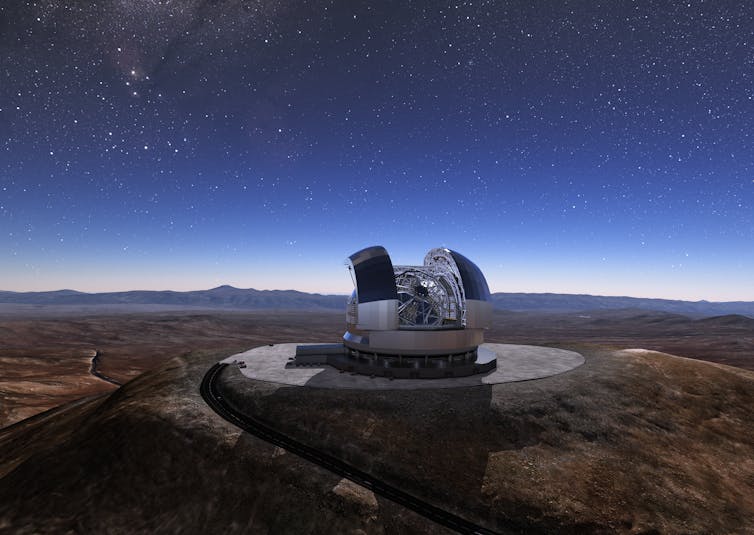
Remarkably, Andes will be able to detect this minuscule change in the light’s colour. Starlight, while essentially continuous (“white”) from the ultraviolet to the infrared, contains bands where atoms in the outer region of the star absorb specific wavelengths as the light escapes, appearing dark in the spectra.
Tiny shifts in the positions of these features — around 1/10,000th of a pixel on the Andes sensor — may, over months and years, reveal the periodic wobbles. This could ultimately help us to find an Earth 2.0.
At Heriot-Watt University, we are piloting the development of a laser system known as a frequency comb, that will enable Andes to reach such exquisite precision. Like the millimetre ticks on a ruler, the laser will calibrate the Andes spectrograph by providing a spectrum of light structured as thousands of regularly spaced wavelengths.
This scale will remain constant over decades, mitigating the measurement errors that occur from environmental changes in temperature and pressure.
With the ELT’s construction cost coming in at €1.45 billion, some will question the value of the project. But astronomy has a significance that spans millennia and transcends cultures and national borders. It is only by looking far outside our Solar System that we can gain a perspective beyond the here and now.![]()
Derryck Telford Reid, Professor of Physics, Heriot-Watt University
This article is republished from The Conversation under a Creative Commons license. Read the original article.
Your mental dictionary is part of what makes you unique − here’s how your brain stores and retrieves words

The days of having a dictionary on your bookshelf are numbered. But that’s OK, because everyone already walks around with a dictionary – not the one on your phone, but the one in your head.
Just like a physical dictionary, your mental dictionary contains information about words. This includes the letters, sounds and meaning, or semantics, of words, as well as information about parts of speech and how you can fit words together to form grammatical sentences. Your mental dictionary is also like a thesaurus. It can help you connect words and see how they might be similar in meaning, sound or spelling.
As a researcher who studies word retrieval, or how you quickly and accurately pull words out of your memory to communicate, I’m intrigued by how words are organized in our mental dictionaries. Everyone’s mental dictionary is a little bit different. And I’m even more intrigued by how we can restore the content of our mental dictionaries or improve our use of them, particularly for those who have language disorders.
Language is part of what makes humans special, and I believe everyone deserves the chance to use their words with others.
Your Mental Dictionary
While a physical dictionary is helpful for shared knowledge, your personal mental dictionary is customized based on your individual experiences. What words are in my mental dictionary might overlap with the mental dictionary of someone else who also speaks the same language, but there will also be a lot of differences between the content of our dictionaries.
You add words to your mental dictionary through your educational, occupational, cultural and other life experiences. This customization also means that the size of mental dictionaries is a little bit different from person to person and varies by age. Researchers found that the average 20-year-old American English speaker knows about 42,000 unique words, and this number grows to about 48,000 by age 60. Some people will have even larger vocabularies.
By now, you might be envisioning your mental dictionary as a book with pages of words in alphabetical order you can flip through as needed. While this visual analogy is helpful, there is a lot of debate about how mental dictionaries are organized. Many scholars agree that it’s probably not like an alphabetized book.
One widely rejected theory, the grandmother cell theory, suggests that each concept is encoded by a single neuron. This implies that you would have a neuron for every word that you know, including “grandmother.”
While not accepted as accurate, the aspect of the grandmother cell theory suggesting that certain parts of the brain are more important for some types of information than others is likely true. For example, the left temporal lobe on the side of your brain has many regions that are important for language processing, including word retrieval and production. Rather than a single neuron responsible for processing a concept, a model called parallel distributed processing proposes that large networks of neurons across the brain work together to bring about word knowledge when they fire together.
For example, when I say the word “dog,” there are lots of different aspects of the word that your brain is retrieving, even if unconsciously. You might be thinking about what a dog smells like after being out in the rain, what a dog sounds like when it barks, or what a dog feels like when you pet it. You might be thinking about a specific dog you grew up with, or you might have a variety of emotions about dogs based on your past experiences with them. All of these different features of “dog” are processed in slightly different parts of your brain.
Using Your Mental Dictionary
One reason why your mental dictionary can’t be like a physical dictionary is that it is dynamic and quickly accessed.
Your brain’s ability to retrieve a word is very fast. In one study, researchers mapped the time course of word retrieval among 24 college students by recording their brain activity while they named pictures. They found evidence that participants selected words within 200 milliseconds of seeing the image. After word selection, their brain continued to process information about that word, like what sounds are needed to say that chosen word and ignoring related words. This is why you can retrieve words with such speed in real-time conversations, often so quickly that you give little conscious attention to that process.
Until … you have a breakdown in word retrieval. One common failure in word retrieval is called the tip-of-the-tongue phenomenon. It’s the feeling when you know what word you want to use but are unable to find it in that moment. You might even know specific details about the word you want, like other words with similar meaning or maybe the first letter or sound of that word. With enough time, the word you wanted might pop into your mind.
These tip-of-the-tongue experiences are a normal part of human language experience across the life span, and they increase as you grow older. One proposed reason for this increase is that they’re due to an age-related disruption in the ability to turn on the right sounds needed to say the selected word.

For some people, though, tip-of-the-tongue experiences and other speech errors can be quite impairing. This is commonly seen in aphasia, a language disorder that often occurs after injury to the language centers of the brain, such as stroke, or neurodegeneration, such as dementia. People with aphasia often have difficulty with word retrieval.
Fortunately, there are treatments available that can help someone improve their word retrieval abilities. For example, semantic feature analysis focuses on strengthening the semantic relationships between words. There are also treatments like phonomotor treatment that focus on strengthening the selection and production of speech sounds needed for word production. There are even apps that remotely provide word retrieval therapy on phones or computers.
The next time you have a conversation with someone, take a moment to reflect on why you chose the specific words you did. Remember that the words you use and the mental dictionary you have are part of what make you and your voice unique.![]()
Nichol Castro, Assistant Professor of Communicative Disorders and Sciences, University at Buffalo
This article is republished from The Conversation under a Creative Commons license. Read the original article.
What’s your chronotype? Knowing whether you’re a night owl or an early bird could help you do better on tests and avoid scams

Timing is everything. For early risers and late-nighters alike, listening to your internal clock may be the key to success. From the classroom to the courtroom and beyond, people perform best on challenging tasks at a time of day that aligns with their circadian rhythm.
Circadian rhythms are powerful internal timekeepers that drive a person’s physiological and intellectual functioning throughout the day. Peaks in these circadian rhythms vary across individuals. Some people, known as larks or morning chronotypes, peak early and feel at their best in the morning. Others, known as owls or evening chronotypes, peak later in the day and perform best in the late afternoon or evening. And some people show neither morning nor evening preferences and are considered neutral chronotypes.
As a researcher seeking ways to improve cognitive function, I’ve explored whether your chronotype affects your mental performance. Understanding the kinds of mental processes that vary – or remain stable – over the course of a day may help people schedule their tasks in a way that optimizes performance.
Why Your Chronotype Matters
Chronotype can be measured with a simple questionnaire that assesses things like your perceived alertness, preferred rising and retiring times and performance throughout the day. Even without a questionnaire, most people have a sense of whether they are a lark or an owl or fall somewhere in between. Do you wake up early, without an alarm, feeling sharp? Are you mentally drained and ready for pj’s by nine? If so, you are likely a morning type. Do you sleep late and wake feeling sluggish and foggy? Are you more energized late at night? If so, you are likely an evening type.
People perform best on many challenging mental tasks – from paying attention and learning to solving problems and making complex decisions – when these actions are synchronized with their personal circadian peaks. This is known as the synchrony effect. Whether you are an air traffic controller scanning the radar, a CFO reviewing an earnings report or a high school student learning chemistry, synchrony can affect how well you perform.
Much of the evidence for synchrony effects comes from lab studies that test both larks and owls early in the morning and late in the day. People with strong chronotypes are more vigilant and better able to sustain attention at their peak relative to off-peak times. Their memories are sharper, with better list recall and more success in remembering “to-do” tasks like taking medication.

People are also less prone to mind wandering and less distracted at their optimal time. For example, a study I conducted gave participants three weakly related cue words (such as “ship,” “outer” and “crawl”). They were tasked to find another word that linked all three (such as “space”). When my team and I presented misleading words alongside the cue words (such as “ocean” for ship, “inner” for outer and “baby” for crawl), those who were tested at synchronous times were better at ignoring the misleading words and finding the target solution than those who weren’t.
Synchrony also affects high-level cognitive functions like persuasion, reasoning and decision-making. Studies on consumers have found that people are more discerning, skeptical and analytical at their peak times. They invest more time and effort in assigned tasks and are more likely to search for important information. Consequently, people make better investment decisions, are less prone to bias and are more likely to detect scams.
At off-peak times it takes people longer to solve problems, and they tend to be less careful and more reliant on mental shortcuts, leaving them vulnerable to flashy marketing schemes. Even ethical behavior can be compromised at non-optimal times, as people are more likely to cheat at their off-peak times.
In The Classroom And The Clinic
The basic mental abilities that are affected by synchrony – including attention, memory and analytical thinking – are all skills that contribute to academic success. This connection is especially significant for teens, who tend to be night owls but typically start school early.
One study randomly assigned over 700 adolescents to exam times in the early morning, late morning or afternoon. Owls had lower scores relative to larks in both morning sessions, but this disadvantage disappeared for owls taking the exam in the afternoon. Early start times may put student owls a step behind larks.
Time of day may also be a consideration when conducting assessments for cognitive disorders like attention-deficit disorder or Alzheimer’s disease. Scheduling time may be particularly significant for older adults, who tend to be larks and often show larger synchrony effects than young adults. Performance is better at peak times on several key neuropsychological measures used to assess these conditions. Failing to consider synchrony may affect the accuracy of diagnoses and subsequently have consequences for clinical trial eligibility and data on treatment effectiveness.

Of course, synchrony doesn’t affect performance on all tasks or for all people. Simple, easy tasks – like recognizing familiar faces or places, dialing a close friend’s phone number or making a favorite recipe – are unlikely to change over the day. Furthermore, young adults who are neither larks nor owls show less variability in performance over the day.
For those who are true early birds or night owls, tackling the toughest mental tasks at times that align with their personal circadian peaks could improve their outcomes. When small improvements in performance offer an essential edge, synchrony may be one secret to success.![]()
Cindi May, Professor of Psychology, College of Charleston
This article is republished from The Conversation under a Creative Commons license. Read the original article.
How animals get their skin patterns is a matter of physics – new research clarifying how could improve medical diagnostics and synthetic materials

Patterns on animal skin, such as zebra stripes and poison frog color patches, serve various biological functions, including temperature regulation, camouflage and warning signals. The colors making up these patterns must be distinct and well separated to be effective. For instance, as a warning signal, distinct colors make them clearly visible to other animals. And as camouflage, well-separated colors allow animals to better blend into their surroundings.
In our newly published research in Science Advances, my student Ben Alessio and I propose a potential mechanism explaining how these distinctive patterns form – that could potentially be applied to medical diagnostics and synthetic materials.
A thought experiment can help visualize the challenge of achieving distinctive color patterns. Imagine gently adding a drop of blue and red dye to a cup of water. The drops will slowly disperse throughout the water due to the process of diffusion, where molecules move from an area of higher concentration to lower concentration. Eventually, the water will have an even concentration of blue and red dyes and become purple. Thus, diffusion tends to create color uniformity.
A question naturally arises: How can distinct color patterns form in the presence of diffusion?
Movement And Boundaries
Mathematician Alan Turing first addressed this question in his seminal 1952 paper, “The Chemical Basis of Morphogenesis.” Turing showed that under appropriate conditions, the chemical reactions involved in producing color can interact with each other in a way that counteracts diffusion. This makes it possible for colors to self-organize and create interconnected regions with different colors, forming what are now called Turing patterns.
However, in mathematical models, the boundaries between color regions are fuzzy due to diffusion. This is unlike in nature, where boundaries are often sharp and colors are well separated.

Our team thought a clue to figuring out how animals create distinctive color patterns could be found in lab experiments on micron-sized particles, such as the cells involved in producing the colors of an animal’s skin. My work and work from other labs found that micron-sized particles form banded structures when placed between a region with a high concentration of other dissolved solutes and a region with a low concentration of other dissolved solutes.
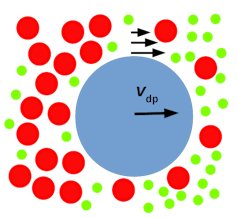
In the context of our thought experiment, changes in the concentration of blue and red dyes in water can propel other particles in the liquid to move in certain directions. As the red dye moves into an area where it is at a lower concentration, nearby particles will be carried along with it. This phenomenon is called diffusiophoresis.
You benefit from diffusiophoresis whenever you do your laundry: Dirt particles move away from your clothing as soap molecules diffuse out from your shirt and into the water.
Drawing Sharp Boundaries
We wondered whether Turing patterns composed of regions of concentration differences could also move micron-sized particles. If so, would the resulting patterns from these particles be sharp and not fuzzy?
To answer this question, we conducted computer simulations of Turing patterns – including hexagons, stripes and double spots – and found that diffusiophoresis makes the resulting patterns significantly more distinctive in all cases. These diffusiophoresis simulations were able to replicate the intricate patterns on the skin of the ornate boxfish and jewel moray eel, which isn’t possible through Turing’s theory alone.
Further supporting our hypothesis, our model was able to reproduce the findings of a lab study on how the bacterium E. coli moves molecular cargo within themselves. Diffusiophoresis resulted in sharper movement patterns, confirming its role as a physical mechanism behind biological pattern formation.
Because the cells that produce the pigments that make up the colors of an animal’s skin are also micron-sized, our findings suggest that diffusiophoresis may play a key role in creating distinctive color patterns more broadly in nature.
Learning Nature’s Trick
Understanding how nature programs specific functions can help researchers design synthetic systems that perform similar tasks.
Lab experiments have shown that scientists can use diffusiophoresis to create membraneless water filters and low-cost drug development tools.
Our work suggests that combining the conditions that form Turing patterns with diffusiophoresis could also form the basis of artificial skin patches. Just like adaptive skin patterns in animals, when Turing patterns change – say from hexagons to stripes – this indicates underlying differences in chemical concentrations inside or outside the body.
Skin patches that can sense these changes could diagnose medical conditions and monitor a patient’s health by detecting changes in biochemical markers. These skin patches could also sense changes in the concentration of harmful chemicals in the environment.
The Work Ahead
Our simulations exclusively focused on spherical particles, while the cells that create pigments in skin come in varying shapes. The effect of shape on the formation of intricate patterns remains unclear.
Furthermore, pigment cells move in a complicated biological environment. More research is needed to understand how that environment inhibits motion and potentially freezes patterns in place.
Besides animal skin patterns, Turing patterns are also crucial to other processes such as embryonic development and tumor formation. Our work suggests that diffusiophoresis may play an underappreciated but important role in these natural processes.
Studying how biological patterns form will help researchers move one step closer to mimicking their functions in the lab – an age-old endeavor that could benefit society.![]()
Ankur Gupta, Assistant Professor of Chemical and Biological Engineering, University of Colorado Boulder
This article is republished from The Conversation under a Creative Commons license. Read the original article.
Who will write the rules for AI? How nations are racing to regulate artificial intelligence
Fan Yang, The University of Melbourne and Ausma Bernot, Charles Sturt UniversityArtificial intelligence (AI) is a label that can cover a huge range of activities related to machines undertaking tasks with or without human intervention. Our understanding of AI technologies is largely shaped by where we encounter them, from facial recognition tools and chatbots to photo editing software and self-driving cars.
If you think of AI you might think of tech companies, from existing giants such as Google, Meta, Alibaba and Baidu, to new players such as OpenAI, Anthropic and others. Less visible are the world’s governments, which are shaping the landscape of rules in which AI systems will operate.
Since 2016, tech-savvy regions and nations across Europe, Asia-Pacific and North America have been establishing regulations targeting AI technologies. (Australia is lagging behind, still currently investigating the possibility of such rules.)
Currently, there are more than 1,600 AI policies and strategies globally. The European Union, China, the United States and the United Kingdom have emerged as pivotal figures in shaping the development and governance of AI in the global landscape.
Ramping Up AI Regulations
AI regulation efforts began to accelerate in April 2021, when the EU proposed an initial framework for regulations called the AI Act. These rules aim to set obligations for providers and users, based on various risks associated with different AI technologies.
As the EU AI Act was pending, China moved forward with proposing its own AI regulations. In Chinese media, policymakers have discussed a desire to be first movers and offer global leadership in both AI development and governance.
Where the EU has taken a comprehensive approach, China has been regulating specific aspects of AI one after another. These have ranged from algorithmic recommendations, to deep synthesis or “deepfake” technology and generative AI.
China’s full framework for AI governance will be made up of these policies and others yet to come. The iterative process lets regulators build up their bureaucratic know-how and regulatory capacity, and leaves flexibility to implement new legislation in the face of emerging risks.
A ‘Wake-Up Call’
China’s AI regulation may have been a wake-up call to the US. In April, influential lawmaker Chuck Shumer said his country should “not permit China to lead on innovation or write the rules of the road” for AI.
On October 30 2023, the White House issued an executive order on safe, secure and trustworthy AI. The order attempts to address broader issues of equity and civil rights, while also concentrating on specific applications of technology.
Alongside the dominant actors, countries with growing IT sectors including Japan, Taiwan, Brazil, Italy, Sri Lanka and India have also sought to implement defensive strategies to mitigate potential risks associated with the pervasive integration of AI.
AI regulations worldwide reflect a race against foreign influence. At the geopolitical scale, the US competes with China economically and militarily. The EU emphasises establishing its own digital sovereignty and striving for independence from the US.
On a domestic level, these regulations can be seen as favouring large incumbent tech companies over emerging challengers. This is because it is often expensive to comply with legislation, requiring resources smaller companies may lack.
Alphabet, Meta and Tesla have supported calls for AI regulation. At the same time, the Alphabet-owned Google has joined Amazon in investing billions in OpenAI’s competitor Anthropic, and Tesla boss Elon Musk’s xAI has just launched its first product, a chatbot called Grok.
Shared Vision
The EU’s AI Act, China’s AI regulations, and the White House executive order show shared interests between the nations involved. Together, they set the stage for last week’s “Bletchley declaration”, in which 28 countries including the US, UK, China, Australia and several EU members pledged cooperation on AI safety.
Countries or regions see AI as a contributor to their economic development, national security, and international leadership. Despite the recognised risks, all jurisdictions are trying to support AI development and innovation.
By 2026, worldwide spending on AI-centric systems may pass US$300 billion by one estimate. By 2032, according to a Bloomberg report, the generative AI market alone may be worth US$1.3 trillion.
Numbers like these, and talk of perceived benefits from tech companies, national governments, and consultancy firms, tend to dominate media coverage of AI. Critical voices are often sidelined.
Competing Interests
Beyond economic benefits, countries also look to AI systems for defence, cybersecurity, and military applications.
At the UK’s AI safety summit, international tensions were apparent. While China agreed with the Bletchley declaration made on the summit’s first day, it was excluded from public events on the second day.
One point of disagreement is China’s social credit system, which operates with little transparency. The EU’s AI Act regards social scoring systems of this sort as creating unacceptable risk.
The US perceives China’s investments in AI as a threat to US national and economic security, particularly in terms of cyberattacks and disinformation campaigns.
These tensions are likely to hinder global collaboration on binding AI regulations.
The Limitations Of Current Rules
Existing AI regulations also have significant limitations. For instance, there is no clear, common set of definitions of different kinds of AI technology in current regulations across jurisdictions.
Current legal definitions of AI tend to be very broad, raising concern over how practical they are. This broad scope means regulations cover a wide range of systems which present different risks and may deserve different treatments. Many regulations lack clear definitions for risk, safety, transparency, fairness, and non-discrimination, posing challenges for ensuring precise legal compliance.
We are also seeing local jurisdictions launch their own regulations within the national frameworks. These may address specific concerns and help to balance AI regulation and development.
California has introduced two bills to regulate AI in employment. Shanghai has proposed a system for grading, management and supervision of AI development at the municipal level.
However, defining AI technologies narrowly, as China has done, poses a risk that companies will find ways to work around the rules.
Moving Forward
Sets of “best practices” for AI governance are emerging from local and national jurisdictions and transnational organisations, with oversight from groups such as the UN’s AI advisory board and the US’s National Institute of Standards and Technology. The existing AI governance frameworks from the UK, the US, the EU, and – to a limited extent – China are likely to be seen as guidance.
Global collaboration will be underpinned by both ethical consensus and more importantly national and geopolitical interests.![]()
Fan Yang, Research fellow at Melbourne Law School, the University of Melbourne and the ARC Centre of Excellence for Automated Decision-Making and Society., The University of Melbourne and Ausma Bernot, Postdoctoral Research Fellow, Australian Graduate School of Policing and Security, Charles Sturt University
This article is republished from The Conversation under a Creative Commons license. Read the original article.
Optus blackout explained: what is a ‘deep network’ outage and what may have caused it?
Paul Haskell-Dowland, Edith Cowan University; Mark A Gregory, RMIT University, and Mohiuddin Ahmed, Edith Cowan UniversityOptus customers woke up this morning to find they were unable to get their social media fix, and they weren’t happy. Around 4am AEDT, customers started to report an inability to access both mobile and home internet services.
Optus advised it was investigating the issue, with reports emerging around midday of some services coming back online.

Around 12.30pm, Optus chief executive Kelly Bayer Rosmarin told radio 2GB the path to restoration had been found, nearly nine hours after the blackout began.
The outage, one of the largest in Australia’s history, sent alarm bells ringing across the country. With a number of smaller mobile network providers reselling the Optus network, including Aussie Broadband, Amaysim, CatchConnect, Coles Mobile, Dodo, Moose Mobile and more, the impact was felt far and wide.
As the morning progressed, the impact grew. Health and emergency services were unable to communicate, trains in Melbourne were brought to a halt and small businesses across the nation were unable to use Optus EFTPOS.
Fortunately, Optus users could still use roaming to call 000 if they were within the coverage of other telecommunication service providers.
What Is A ‘Deep Network’ Problem?
Earlier today Minister for Communications Michelle Rowland described the incident as a “deep network” problem.
Telecommunications networks include three components: the core, transit and access networks. You can think of the core network as the systems that allow customers’ devices to connect to and access phone and internet services.
The transit network connects the core to the access networks using optical fibre cables. The access networks include the local infrastructure found in suburbs – including the mobile phone towers.
Core network outages can occur when equipment or cables fail, when there is a software fault, or when a cyberattack occurs.
The most common reason for a software fault is when a patch or update is applied and it has an unintended outcome, such as causing one or more of the core network systems to fail.
What Could Have Caused This?
Although Optus hasn’t give any indications as to the exact cause of the outage, Bayer Rosmarin said it was unlikely a cyberattack was the cause:
There is no indication that it is anything to do with spyware at this stage.
At the same time, experts have noted mobile cell towers are working, and there seems to be no damage to the underlying fibre optic network. This means we can probably rule out an issue in the transit or access networks.
The scale and speed with which the impact hit (and the somewhat specific timing) indicates the culprit was likely a problem in the core network.
It’s very possible a software or system update was responsible. Such updates or changes often happen out of business hours to have minimal impact. They typically involve a short period of downtime – a “scheduled outage” – which goes unnoticed by customers.
It could be, as some reports have speculated, the Optus outage was an unplanned consequence of a planned system change, such as a planned update or outage. When these processes go wrong, they can go spectacularly wrong!

As for how such a fault may happen, it is likely due to human error (especially since 4am is a time you might expect engineers to be carrying out patch work). However, it could also be a result of other factors, such as a hardware fault that then causes a software failure.
Another possibility is a fault in an accounting or user management system, such as no longer being able to attribute costs or verify users’ identities properly.
Issues in back-end billing and management systems can generate a cascade of failures throughout the rest of a network. In such cases, a simple bug in the system can impact everyone connected to the network.
How Will This Be Fixed?
Optus engineers will be actively investigating the cause of the outage. You might be imagining someone scurrying around with wires in their hands trying to find the one that isn’t plugged in – but in reality this will be a lengthy process that involves examining various systems and software configurations to find the culprit.
For Optus, the hard work will continue after the fix is in place to ensure it doesn’t happen again. And perhaps an even more difficult challenge will be convincing the public this was an isolated incident – one that has once again highlighted how vulnerable our massively connected systems are to (even single) points of failure.
Speaking on 3AW Afternoons, Bayer Rosmarin said:
We are looking at what we can do to say thank you to our customers for their patience.
Optus is likely to pay compensation to customers. For residential customers this may be in the form of a reduced bill.
For business customers, the compensation would be linked with their service-level agreements. In other words, the specific penalties for Optus will be based on individual agreements it has made with various parties using or sharing its services.
Beyond this, it’s highly likely today’s events have dealt a massive blow to Optus’s reputation – especially when considered alongside last year’s Optus data breach.![]()
Paul Haskell-Dowland, Professor of Cyber Security Practice, Edith Cowan University; Mark A Gregory, Associate Professor, School of Engineering, RMIT University, and Mohiuddin Ahmed, Senior Lecturer of Computing and Security, Edith Cowan University
This article is republished from The Conversation under a Creative Commons license. Read the original article.
In a crisis, Optus appears to be ignoring Communications 101
Alison Stieven-Taylor, Monash UniversityMillions of Optus customers are in the wilderness of a nationwide network outage that began at 4am.
The initial response from Optus delivered by an unnamed company spokesperson on Facebook and X at 6.47am AEDT told Australians little they didn’t already know, that the network was down, and that the company didn’t yet know what had happened.
Later, at 10.30am, the ABC got through to Optus Chief Executive Kelly Bayer Rosmarino via WhatsApp and asked
What do you know? What’s happened?
Bayer Rosmarino replied:
Well I mean we do know how important connectivity is to all of our customers, so we are really, really apologetic and sorry that our connections have gone down today. The teams are working with huge effort to try and restore services as a priority, and will keep working on that until everybody’s back in action.
For the second time in a little over a year, the country’s second-largest telecommunications provider lost control of its story.
In September last year when the data of up to 9.8 million of its present and former customers was compromised, it failed to contact those affected for days and communicated via media statements, believing that was the “quickest and most effective way to alert as many current and former customers as possible”.
Golden Rules For Crises
Every company should have a crisis communications plan – a “living document” that it regularly updates, so that when a crisis emerges there is a strategy ready to be implemented.
There are several golden rules to executing an effective crisis communications response. They are based on transparency, honesty and empathy, and are well documented by theorists such as Timothy Coombs and William Benoit.
1. Learn From Past Mistakes
Last year Optus was castigated after its appalling public response (or lack thereof) to one of Australia’s largest data breaches. Optus took four days to tell 9.8 million present and former customers that their data had been compromised.
For a company in the communications business, that’s an epic failure.
To make matters worse, once alerted to the breach, its customers were unable to get through. In a crisis, customers don’t want a recorded message that tells them their “call is important” only to be left on hold.
At that moment customers need information and assurance their trust in the company has not been misplaced. If the company doesn’t have capacity it should be ready to mobilise a temporary workforce to respond to its customers.
2. Prepare To Deal With The Media
Another mistake Optus appeared to make last year was not to give Bayer Rosmarin sufficient media training. She didn’t front the media for two days.
Corporate heads and executives should regularly undergo media training during which they learn how to respond to difficult and hostile questioning.
This time Bayer Rosmarin fronted the media within hours rather than days, although too late for the morning news programs that told Australians what was going on.

3. Don’t Let The Story Run Away From You
The best advice is to get out in front of the story. By the time Bayer Rosmarin spoke up at 10.30 this morning, it was difficult to alter an established narrative.
Once a story becomes publicly established, it becomes difficult to influence.
And it is best to speak to more than one media outlet. This is particularly important for a company with a broad customer base like Optus.
4. Apologise And Accept Blame
Last year Optus painted itself as the victim of the hack (which it was) but then failed to also address its responsibility for keeping its customers’ data safe, and apologise for failing to do so.
Mortification (confessing and asking for forgiveness) is recommended by both Coombs and Benoit, and the sooner the better.
Companies that apologise late are seen as disingenuous.
5. Be Empathetic
Companies that have let down their customers should put themselves in their customers’ place.
Part of doing this is to avoid corporate speak and connect at a human level.
Customers want to know the company accepts its actions have caused harm and is as concerned about it as they are, if not more so.
This means sharing information as soon as it is to hand so that customers can make decisions. These might involve leaving for a competitor, or sticking with the company that is sticking by them.
6. Be Honest
If a company in crisis doesn’t know the answer to a question it should say so, but then promise to provide regular updates and be true to its word.
A company that leaves a communication vacuum (as Optus did this morning) will allow others to fill it, almost certainly to its detriment.
7. Bolster Your Company
Bolstering is reminding customers of the good things a company has done in the past, and can work when deployed alongside empathy, honesty and mortification.
It’s an approach that will prove difficult for Optus, given its performance the last time it was in this sort of crisis.![]()
Alison Stieven-Taylor, Lecturer in Strategic Communications, Monash University
This article is republished from The Conversation under a Creative Commons license. Read the original article.
Only 1.5% of students swapped fields due to the ‘Job-ready Graduates’ fee changes

In January 2021, the Morrison government changed the way university fees are set with the Job-ready Graduates scheme.
The idea was to steer students into courses that would lead to “the jobs of the future”. So the scheme made some fields (such as history and journalism) more expensive and some (such as nursing, teaching, computer programming and engineering) less expensive.
Fees rose by as much as 117% for some fields and dropped by as much as 59% for others. The government believed this would affect student choices.
Education experts have been very critical of scheme. They argue it is not only unfair, it would not work. But to date there have been few studies looking at the evidence.
Our research with our former student Maxwell Yong shows the impact of the Job-ready Graduates scheme was modest at best.
Our Research
Our study looked at student’s preferences when applying for degrees and final enrolments (what they ended up studying).
We used data from the Universities Admissions Centre, which handles applications for degrees in New South Wales and the Australian Capital Territory.
We looked at more than 725,000 undergraduates applying between 2014 and 2022. This means we had seven years of data before the Job-ready Graduates scheme was introduced, and two years afterwards.
Using various statistical models, we analysed whether students increased their preferences for fields that became cheaper and reduced preferences for fields that became more expensive.
Our Findings
Overall we found the Job-ready Graduates scheme only had a minor impact on course choices.
Just 1.52% of university applicants in our study chose fields they would have not chosen had it not been for the scheme, moving from humanities, arts, law and business to STEM (science, technology, engineering and maths) and teaching.
Maths and statistics had the largest drop of student fees (59%) of any field. But only one out of every 2,000 students responded by changing their preference to maths.
Communications, journalism and media studies had the largest increase in fees (117%). But only one out of every 350 students chose not to preference these fields in response.
This is perhaps not surprising. Under HECS-HELP, students do not have to pay university fees up-front. Many students also choose courses based on their passions and interests rather than the amount of the deferred fees.
Big Repercussions
While we found only modest responses to these large fee changes, this does not mean students are not affected. Because of the reforms, many will accumulate much larger HECS-HELP debts.
For a three-year bachelors degree in journalism, the debt grows from around A$20,000 to A$43,500. For a mathematics degree, the debt falls from around $28,600 to $11,850. The new difference in debts ($31,650) is more than triple the old difference ($8,600).
Higher debts mean more years of making repayments. Longer repayment times may mean delayed home purchases and starting families.
These reforms overturned 25 years of university fees reflecting the earning prospects of graduates. Those likely to earn more post-graduation (lawyers, doctors, financiers) paid a bit more. Those likely to earn less (arts, nursing, teaching) paid a bit less.
The Universities Accord
The Albanese government is in the middle of a broad review of the higher education system, including university fees. The Universities Accord review panel is due to hand in a final report in December.
An interim report was highly critical of the Job-ready Graduates scheme, saying it risks “causing long-term and entrenched damage to Australian higher education”.
As a new model is considered, it is important policymakers understand increasing HECS-HELP debts for some and reducing them for others is not going to prompt students into areas the government deems a “priority”. ![]()
Jan Kabatek, Research Fellow, Melbourne Institute of Applied Economic and Social Research, The University of Melbourne and Michael Coelli, Associate professor, The University of Melbourne
This article is republished from The Conversation under a Creative Commons license. Read the original article.
Kandinsky at the Art Gallery of New South Wales: a precious gem of a show celebrating the transformative power of art
Sasha Grishin, Australian National UniversityVasily Kandinsky (1866-1944) was a pioneer of abstract art. His work and theories on art profoundly influenced the School of Paris, the American Abstract Expressionists, as well as the expressionist painters working in Australia.
Drawing on the extensive holdings of the the Solomon R. Guggenheim Museum in New York, this new exhibition at the Art Gallery of New South Wales is the largest Kandinsky exhibition to be held in Australia.
In about 50 works, it covers the full range of the artist’s vision: the early “folky” works carrying the impact of the Jugendstil (German art nouveau) and Impressionism; the groundbreaking abstracts with their impressions, improvisations and compositions; and finally the wonderful, refined late geometric and biomorphic paintings.
This is a precious gem of a show that celebrates the transformative power of art – its ability to transcend the material realm and to nourish us spiritually.
Russian Imagery, Spiritual Realm And Colour Auras
Kandinsky was Russian, born in Moscow in 1866. He never lost links with Russian art and culture. He expressed a profound belief in Russian Orthodoxy as the sole true faith.
Circumstances of history meant he divided his life between living and travelling in Russia and working in Germany and finally living in France, where he died.
Nevertheless, even when living in the heart of industrial Munich, he still painted Russian horse-drawn troikas, churches with their cupolas and the great saints of Russia.
Building on the heritage of spiritualism inherent in Russian Orthodox icons and the inventive whimsical narratives in Russian folk art, Kandinsky also explored the spiritual realm and colour auras integral to theosophy.
He was one of the most influential teachers at the German Bauhaus, before the Nazis closed it. He wrote the single most influential essay in 20th-century art, On the spiritual in art, in 1911.
What strikes me about this exhibition is Kandinsky has lost none of his timeless magic.
Frequently when visiting an exhibition of an early modern – for example, Picasso’s cubism – you may be impressed by the work and its avant-garde properties that were so amazing in their day, but they appear of their time and somewhat dated.
Kandinsky’s paintings have not aged and appear contemporary and relevant to us now.
Speaking Directly To The Soul
In Kandinsky’s early paintings, for example, Blue Mountain (1908-09) and Landscape with factory chimney (1910), the figurative element is still strong. Kandinsky invites the viewer to take a walk in the painting and explore an enchanted landscape.
Together with the theosophists, Kandinsky had a mistrust of science. At one stage he remarked:
The disintegration of the atom was to me like the disintegration of the whole world […] I should not have been surprised if a stone had melted in the air and become invisible before my eyes.
A mistrust of science was linked to a mistrust of the physical world observed through the senses and the desire to explore a spiritual reality that bypasses empirical observation and speaks directly to the soul.
Some of the great Kandinsky paintings, including Improvisation 28, second version (1912), Landscape with rain (1913) and the wonderful Painting with white border (May 1913), break free of the figurative realm and create their own reality.
Increasingly Kandinsky questioned the importance of the object as a necessary element in a painting and demonstrated a preparedness to embrace the power, fantasy and enchantment of the palette.
Colour for Kandinsky was a symbolic spiritual experience, with colours linked with spiritual states.
In Kandinsky’s work the physiological effect of colour is sensory and short-lived; warm colours like vermilion attract the eye; the bright yellow of a lemon is painful.
A psychological resonance is produced when the sensory impression causes an emotional vibration directly or through association: red is flame and blood, black a painful silence, the appeal of orange is like the sound of a church bell.
Writing about the Painting with white border, Kandinsky observed:
At that time, I tried, by lines and by distributing of patches of colour, to express the musical spirit of Russia.
One may see in the painting in the top-left-hand corner three black lines that relate to the horses of the Russian troika. In the centre is the lance of the Russian St George slaying the dragon that threatened his homeland with the impending war. Each element in the painting was the subject of a separate study and these studies inform us about the individual elements in the painting.
In a famous passage in On the spiritual in art, Kandinsky observed:
Colour is the keyboard. The eye is the hammer, while the soul is a piano of many strings […] [harmony rests] on the principle of innermost necessity.
Many of Kandinsky’s paintings in the 1920s and 1930s, including Blue segment (1921), Blue painting (January 1924) and Dominant curve (April 1936), refine some of the earlier more organic forms through geometric discipline to create great explorations of intuitive spiritual forms ambiguously suspended in space.
Kandinsky was a great innovator, a profound thinker and a superb painter and graphic artist. His vision changed the way we think about art. This outstanding landmark exhibition, for the first time, redefines his place in art for an Australian audience.
Kandinsky is at the Art Gallery of New South Wales until March 10 2024.![]()
Sasha Grishin, Adjunct Professor of Art History, Australian National University
This article is republished from The Conversation under a Creative Commons license. Read the original article.
,_oil_on_canvas,_52.1_x_54.6_cm,_Stiftung_Sammlung_E.G._B%C3%BChrle,_Zurich.jpg?timestamp=1699485012544)
.jpg?timestamp=1699485063961)
Older Australians And Their Carers Tell Government What They Want From The New Aged Care Act
- Mechanisms for monitoring and enforcing the rights of older people need to be implemented.
- A change culture implementation plan is recommended to outline how rights will be embedded into daily aged care operations.
- A future complaints system must be person-centred, robust and effective, with alternative was of handling complaints, overseen by a statutory Complaints Commissioner.
- Supported decision-making must be the foundation of decision-making in aged care, with an assumption that older people can make decisions for themselves.
Spotlight On Water Safety For Seniors In NSW This Summer: 43% Increase In Drownings In Past 12 Months
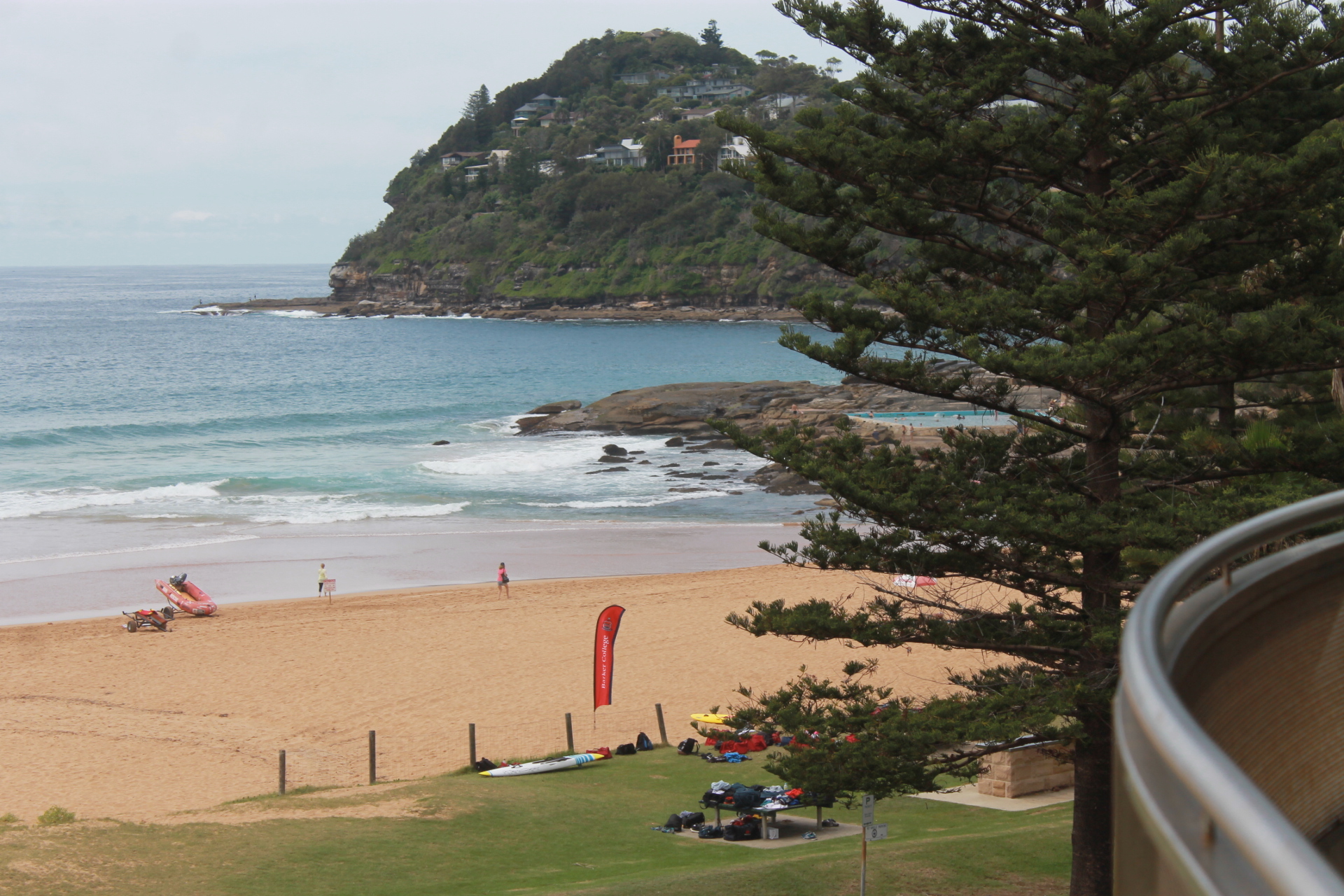
The NSW Government is partnering with Royal Life Saving NSW in its Active Adults campaign to highlight the importance of water safety for seniors this summer.
The Active Adults campaign encourages participation, and the low impact nature of aquatic activity makes it an ideal form of activity and recreation.
Research from Royal Life Saving NSW shows that in the past 12 months there were 281 drowning deaths, with 57% an adult 45 years and older. Those aged over 65 represented 27% of fatal drownings and there’s been a 43% increase in the past 20 years.
The top three drowning deaths of those 65 years and older were swimming and recreating (32%), fall (16%) and boating (9%).
People over 65 are encouraged to follow these five tips to enjoying aquatic recreation:
- share the fun with someone.
- wear a lifejacket when on the water.
- check any medications don’t interfere with your ability to swim.
- watch your step around water.
- know your limits and avoid taking risks.
Royal Life Saving NSW is a leader in drowning prevention and water safety education in the state.
Toolkits and guides are available
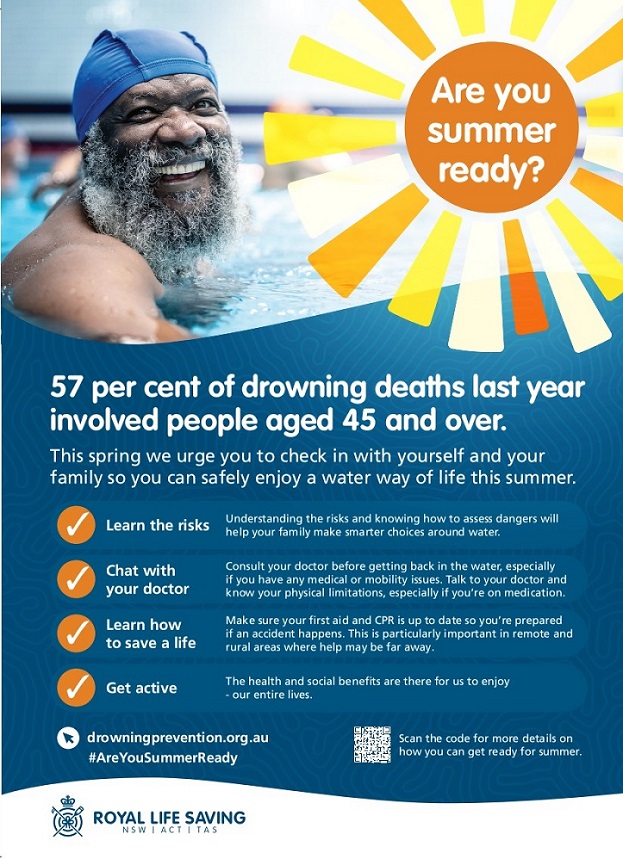
Minister for Seniors Jodie Harrison said:
“With a hot summer expected, there was need for older people to keep water safety top of mind when planning a day in, on or near the water.
“There’s been a concerning increase in drowning deaths in older people and we want to make sure our seniors can enjoy the water safely – whether it is participating in watersport or simply walking around it.
“We know that when we focus on water safety in young people, we get results, with a 33% decrease in drowning deaths in 0-4 year olds.
“By partnering with Royal Life Saving NSW on this campaign, the Government wants to amplify the message that water recreation is a great way to stay active and fit, while emphasising that water safety must remain top of mind for people of all ages, especially for our seniors.”
Minister for Emergency Services Jihad Dib said:
“Australia is lucky to have great beaches, lakes and rivers that many enjoy spending time at.
“Now as the weather starts heating up, it’s a good time to focus on how everyone can stay safe in and around water.”
“Raising awareness of the dangers for older people, such as watching out for trip and fall hazards near water, is important for making sure everyone can enjoy a day out at the beach.”
CEO of Royal Life Saving NSW Michael Ilinsky said:
“Preventing drowning in older people is a priority because Australians are remaining more active into their later years and are well-placed to realise the benefits of fun fitness and recreation activities.
“Participation rates show older Australians are highly motivated to stay connected with their communities, however 75 per cent of people over 65 are under-active.
“We want people of all ages and abilities to be ready to enjoy the summer. The Active Adults campaign will ensure we’re providing appropriate water safety education to keep people active, social and safe.”
Telehealth Recommendations Will Impact Access To Healthcare: AMA
By reviewing the name of the Baden-Powell Award, Scouts Australia is grappling with its colonial past
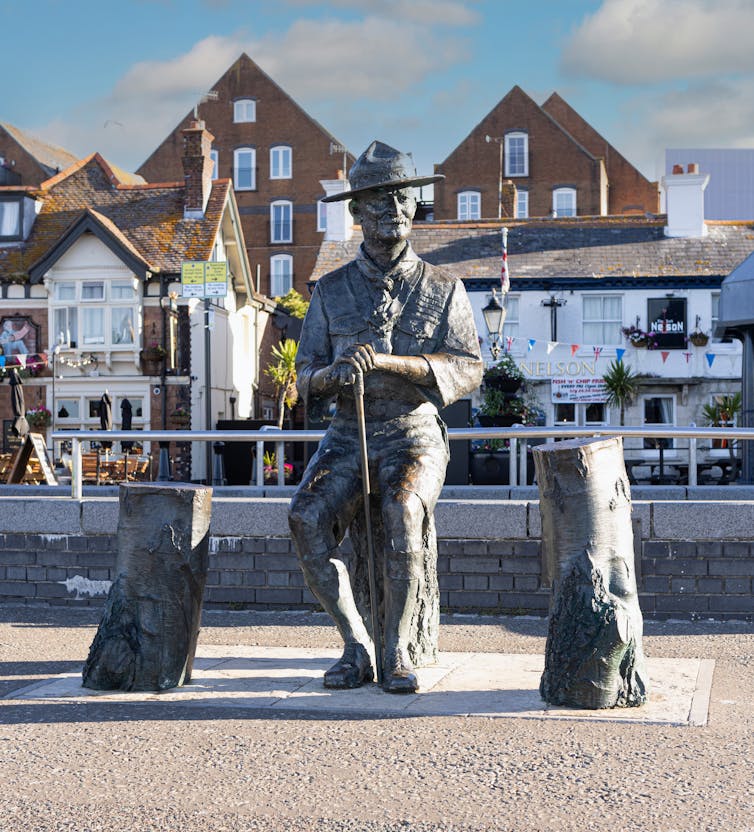
Scouts Australia is considering changing the name of its most prestigious youth award, the Baden-Powell Scout Award.
Presented to recipients by the governor-general, this award is named after the movement’s founder, Lord Robert Baden-Powell, fondly known as B-P.
For millions, Baden-Powell remains a hero. For others, his role in creating the largest youth movement in history is overshadowed by allegations of colonial war crimes.
Like Macquarie University, the City of Sydney, and other institutions, Scouts is caught in an awkward gap between tradition and modernity, as society grapples with colonial figures who were heroes to some, but not others.
Adapting To Changing Social Values
Scouts is one of Australia’s largest youth organisations, with over 70,000 members.
Globally, the movement has 57 million members and volunteers across 174 national organisations.
Baden-Powell’s handbook, Scouting for Boys, is the fourth best-selling book of the 20th century.
The movement began in 1907 after Baden-Powell coordinated a camp on Brownsea Island, England. Baden-Powell’s Scouting philosophy emphasised social responsibility and outdoor skills. The movement became a global sensation, arriving in Australia in 1908.
Notwithstanding its positive influence in fostering youth life skills, the early Scouting movement arguably sometimes operated as an agent of British colonialism. In the early 20th century, it spread across distant outposts of the British Empire, where it encouraged imperial loyalty.
Scouting has endured for over a century, in part because of its willingness to adapt to changing social values.
In 1973, Scouts Australia first admitted women. In 2018, Scouts Australia altered the wording of the Scout Promise.
Now, a Scout can decide between swearing to “do their duty” to their king or queen, or their community and world, and can pledge to their “spiritual beliefs” or “their God”.
But Back To Baden-Powell
Scouts Australia is “reviewing the appropriateness of the Baden-Powell Scout Award name”.
In part, this has been prompted by overseas events. In 2020, amid Black Lives Matter demonstrations, a statue of Baden-Powell in England appeared on a “Topple the Racists” hit list.
Yet, the statue was defended by local Scouts, and a petition against its removal received over 40,500 signatures.
Controversy around Baden-Powell stems from allegations he held antisemitic and racist attitudes.
In 2010, declassified M15 files showed Baden-Powell had been invited to meet Adolf Hitler to build closer ties between Scouts and Hitler’s youth organisation.
Historians have since argued Baden-Powell has been incorrectly framed as a Nazi sympathiser. The meeting never eventuated, and Scouting was banned in Germany, with Baden-Powell being placed on a Nazi death list.
Before Scouts, Baden-Powell was already a hero of the British Empire for his efforts during the South African War.
This conflict claimed the lives of thousands of Black Africans. As an army officer, Baden-Powell famously defended the town of Mafeking, becoming an overnight hero to the British.
Yet, Baden-Powell has since been accused of war crimes against local Africans, including unlawful executions and contributing to starvation. Historians contest the extent to which Baden-Powell ought to be blamed.
Regardless, as an agent of empire, Baden-Powell cannot be extricated from the legacy of British colonialism in Africa. Globally, Scouts has recognised this, with the Chief Scout of the UK, Bear Grylls, admitting Baden-Powell’s “failings”.
An Extended Process Of Public Reckoning
Scouts is just one of many organisations forced to reckon with their colonial baggage.
Often, colonial origin stories are commemorated through the names of places or institutions.
Anyone driving across Australia today will still see reminders of our colonial past in racist naming practices that glorify certain legacies over others, or spread a distorted version of history. The case to replace obviously racist place names can be uncontroversial, provided consultation takes place with Traditional Owners.
In recent years, Queensland has revoked certain racist place names, while Tasmania has renamed several places that previously commemorated colonial violence.
However, some cases can become fraught.
Examples include the many entities that derive their name from Lachlan Macquarie, who served as New South Wales governor from 1810 to 1821. He has been celebrated as a humanitarian, yet Macquarie terrorised local Indigenous peoples.
His military carried out the Appin Massacre of 1816. Macquarie ordered the victims’ bodies to be strung from trees as a warning against further resistance.
Today, Macquarie’s legacy is increasingly disputed. This year, a statue of Macquarie was defaced, with graffiti exposing his record of violence.
Even Macquarie University is facing calls to recognise his ambiguous legacy, rather than promoting him.

In Hyde Park, a plaque beneath a statue of Macquarie describes him as “a perfect gentleman”.
Yet the City of Sydney has recently announced a review of 25 colonial statues, with an aim to include new signage that presents a fuller picture of history.
This is likely to be the start of an extended process of public reckoning. This may extend from relatively unknown statues, or place names, to big businesses and institutions with connections to questionable legacies.![]()
Ciara Smart, PhD candidate in Australasian Colonial History, University of Tasmania
This article is republished from The Conversation under a Creative Commons license. Read the original article.
Frontotemporal dementia: we discovered a brain fold that may delay onset of symptoms

Few people had probably heard of frontotemporal dementia until earlier this year, when the family of actor Bruce Willis announced the 68-year-old had been diagnosed with the condition.
Frontotemporal dementia is a rare disease – thought to account for only one in every 20 cases of dementia. Symptoms usually develop in a person’s late 50s, first affecting their behaviour, personality and language ability. Unlike other forms of dementia, memory only becomes impaired in the late stages of the disease.
People diagnosed with frontotemporal dementia usually die within eight years of their diagnosis. While around 30% of cases are inherited, the cause of frontotemporal dementia is largely unknown. This also means there are no cures available or treatments to slow its progression.
But recent research, I have published with colleagues at Lund University, may have brought us one step closer in our understanding of how frontotemporal dementia develops and progresses. We discovered that the way your brain looks may determine your resilience to the condition.
Brain Folds
During pregnancy, as a foetus’s brain grows within the womb, it develops its distinctive folds while expanding within the skull. These brain folds play an important role in our later cognitive function.
The folds that form early in foetal development are found in both sides of the brain in every person. But there’s one fold that sometimes develops later on in the process. It’s called the paracingulate sulcus – and not everyone has it. In those that do have it, it can either be present on just one side of the brain or both sides.
The paracingulate sulcus is interesting, as its presence can make a significant difference to cognitive ability. For example, research has shown that people with a left but not a right paracingulate sulcus have a cognitive advantage – performing better on tasks involving control and even memory.
Given the link between the paracingulate sulcus and cognitive function, our research team at Lund University – alongside colleagues in the US and Amsterdam – began studying this brain fold’s role in dementia.
To really understand what role the paracingulate sulcus plays, the team decided to focus on a type of dementia where brain damage occurs in the same region as this brain fold. The obvious choice for this research was frontotemporal dementia. This aggressive form of early-onset dementia primarily attacks the frontal lobes of the brain – particularly the central portions surrounding the paracingulate sulcus.

Our team studied MRI brain images of 186 people who had been diagnosed with frontotemporal dementia. We excluded participants who had frontotemporal dementia with a genetic cause. Around 57% of participants had a paracingulate sulcus on the right side of their brain.
We discovered that in participants who had this extra fold on the right side of their brain, their dementia symptoms began on average two and a half years later. This might mean that the paracingulate sulcus may delay the onset of symptoms. These findings were statistically significant – showing they weren’t due to chance or other factors.
This two-and-a-half-year delay in symptoms may not sound like much, but considering the poor prognosis of the condition and the burden of symptoms, this is an extremely meaningful amount of time for patients and their relatives.
Cognitive Reserve
That said, after the symptoms do begin, patients with this extra brain fold became sicker at a faster rate and survived for a shorter length of time than patients who do not have the fold. So despite the delay in symptoms, patients with and without this extra brain fold still died at a similar age.
Although it may sound strange that a factor can both delay symptoms and later speed them up, this paradox is a key feature of a principle referred to in neuroscience as “brain reserve”. Brain reserve describes a structure in the brain which provides resilience to a disease before symptoms develop.
Critically, there becomes a point at which the disease overcomes these protective mechanisms, and the patient develops symptoms. After this critical point, people with high brain reserve decline rapidly – faster than people with low brain reserve.
For example, high brain reserve explains why Alzheimer’s disease starts later in highly educated people – though the disease progresses faster for them when symptoms start. According to our research, the paracingulate sulcus operates by a similar principle – first protecting people from symptoms, then progressing rapidly when symptoms do start.
Our research is the first to identify a protective structure in the brain which delays the onset of symptoms in people with frontotemporal dementia. If we can now uncover a way of preserving this protective quality, it could lead to the development of treatments which can help keep symptoms – and the disease – at bay.![]()
Luke Harper, PhD Student. Neurologist, Lund University
This article is republished from The Conversation under a Creative Commons license. Read the original article.
Beats, Bards And Bongos: Sydney Stories With Warren Fahey
3,000 More Staff For Services Australia
A New Men's Table At Narrabeen

Ecotherapy Walks Available In Warriewood - Narrabeen
- Connect with nature to feel grounded and calm
- Increase your ability to access creative thinking to help with important decision making
- Understand the science – calming the nervous system and accessing the brains prefrontal cortex
- Connecting to place and understanding that we are ‘a part’ of the earth not ‘apart’ from it
- Mindful connection to the earth helps reduce feelings of anxiety, stress, fear, and depression
- Mindful connection promotes feelings of joy, creativity, strength, and resilience
- Totally free and easily accessible form of (self-guided) therapy to increase wellbeing
How much protein do I need as I get older? And do I need supplements to get enough?

If you are a woman around 50, you might have seen advice on social media or from influencers telling you protein requirements increase dramatically in midlife. Such recommendations suggest a 70 kilogram woman needs around 150 grams of protein each day. That’s the equivalent of 25 boiled eggs at 6 grams of protein each.
Can that be right? Firstly let’s have a look at what protein is and where you get it.
Protein is an essential macro-nutrient in our diet. It provides us with energy and is used to repair and make muscle, bones, soft tissues and hormones and enzymes. Mostly we associate animal foods (dairy, meat and eggs) as being rich in protein. Plant foods such as bread, grains and legumes provide valuable sources of protein too.
But what happens to our requirements as we get older?
Ages And Stages
Protein requirements change through different life stages. This reflects changes in growth, especially from babies through to young adulthood. The estimated average requirements by age are:
1.43g protein per kg of body weight at birth
1.6g per kg of body weight at 6–12 months (when protein requirements are at their highest point)
protein needs decline from 0.92g down to 0.62g per kg of body weight from 6–18 years.
When we reach adulthood, protein requirements differ for men and women, which reflects the higher muscle mass in men compared to women:
0.68g per kg of body weight for men
0.6g per kg of body weight for women.
Australian recommendations for people over 70 reflect the increased need for tissue repair and muscle maintenance:
0.86g per kg of bodyweight for men
0.75g per kg of bodyweight for women.
For a 70kg man this is a difference of 12.6g/protein per day. For a 70kg woman this is an increase of 10.5g per day. You can add 10g of protein by consuming an extra 300ml milk, 60g cheese, 35g chicken, 140g lentils, or 3–4 slices of bread.
There is emerging evidence higher intakes for people over 70 (up to 0.94–1.3g per kg of bodyweight per day) might reduce age-related decline in muscle mass (known as sarcopenia). But this must be accompanied with increased resistance-based exercise, such as using weights or stretchy bands. As yet these have not been included in any national nutrient guidelines.

But What About In Midlife?
So, part of a push for higher protein in midlife might be due to wanting to prevent age-related muscle loss. And it might also be part of a common desire to prevent weight gain that may come with hormonal changes.
There have been relatively few studies specifically looking at protein intake in middle-aged women. One large 2017 observational study (where researchers look for patterns in a population sample) of over 85,000 middle-aged nurses found higher intake of vegetable protein – but not animal protein or total protein – was linked to a lower incidence of early menopause.
In the same group of women another study found higher intake of vegetable protein was linked to a lower risk of frailty (meaning a lower risk of falls, disability, hospitalisation and death). Higher intake of animal protein was linked to higher risk of frailty, but total intake of protein had no impact.
Another smaller observational study of 103 postmenopausal women found higher lean muscle mass in middle-aged women with higher protein intake. Yet an intervention study (where researchers test out a specific change) showed no effect of higher protein intake on lean body mass in late post-menopasual women.
Some researchers are theorising that higher dietary protein intake, along with a reduction in kilojoules, could reduce weight gain in menopause. But this has not been tested in clinical trials.
Increasing protein intake, improves satiety (feeling full), which may be responsible for reducing body weight and maintaining muscle mass. The protein intake to improve satiety in studies has been about 1.0–1.6g per kg of bodyweight per day. However such studies have not been specific to middle-aged women, but across all ages and in both men and women.
What Are We Actually Eating?
If we look at what the average daily intake of protein is, we can see 99% of Australians under the age of 70 meet their protein requirements from food. So most adults won’t need supplements.
Only 14% of men over 70 and 4% of women over 70 do not meet their estimated average protein requirements. This could be for many reasons, including a decline in overall health or an illness or injury which leads to reduced appetite, reduced ability to prepare foods for themselves and also the cost of animal sources of protein.
While they may benefit from increased protein from supplements, opting for a food-first approach is preferable. As well as being more familiar and delicious, it comes with other essential nutrients. For example, red meat also has iron and zinc in it, fish has omega-3 fats, and eggs have vitamin A and D, some iron and omega-3 fats and dairy has calcium.

So What Should I Do?
Symptoms of protein deficiency include muscle wasting, poor wound healing, oedema (fluid build-up) and anaemia (when blood doesn’t provide enough oxygen to cells). But the amount of protein in the average Australian diet means deficiency is rare. The Australian dietary guidelines provide information on the number of serves you need from each food group to achieve a balanced diet that will meet your nutrient requirements.
If you are concerned about your protein intake due to poor health, increased demand because of the sports you’re doing or because you are a vegan or vegetarian, talk to your GP or an accredited practising dietitian.![]()
Evangeline Mantzioris, Program Director of Nutrition and Food Sciences, Accredited Practising Dietitian, University of South Australia
This article is republished from The Conversation under a Creative Commons license. Read the original article.
The Great Escaper: Michael Caine’s final film is Britain’s answer to Saving Private Ryan
Sam Edwards, Loughborough UniversityThe Great Escaper is an engaging exploration of love, loss, memory and trauma. It’s also the final film for its star, Michael Caine, as he has recently announced his retirement. The film tells the real story of Royal Navy veteran, Bernard Jordan, who “escaped” from his care home in June 2014 to attend the 70th anniversary of D-Day commemorations in Normandy.
The film follows Caine’s “Bernie” as he embarks upon a deeply personal and emotional reckoning with his war, a journey he undertakes with the support of his stoic wife, Irene, beautifully played by the late Glenda Jackson.
The Great Escaper uses a well-known storytelling device: the war-damaged veteran. In doing so, it marks itself as a British answer to Saving Private Ryan (1998). The film, which pays homage to the war generation, revels in forties nostalgia and stakes an assertive British claim to the memory of the Allied invasion.
Troubled Homecomings
From the troubled homecoming of Homer’s Odysseus to the spate of Hollywood films produced in the 1970s and 1980s focused on the angry and alienated Vietnam veteran such as The Deer Hunter (1978) and Apocalypse Now (1979), the traumatised ex-soldier has long been a figure of cultural interest. This has especially been the case in the British film industry over the last 30 years.
Take, for instance, a trilogy of films produced in the late 1980s all of which examined the return to “civvy street” of battle-damaged Falklands veterans: Resurrected (1989), Tumbledown (1988) and For Queen and Country (1989). Or, more recent productions focused on returning soldiers, such as Outlaw (2007), The Veteran (2011) and, of course, Harry Brown (2009).
The latter starred Michael Caine as a decorated Royal Marine veteran who sets out to rid his impoverished inner-city council estate of crime.
Caine’s “Bernie” is clearly a very different figure to Harry Brown (he does nothing more controversial than letting down the tyres of antisocial cyclists). But as a film character, he nonetheless owes something to these cinematic counterparts. Like them, he carries the psychological scars of war, scars which wake him in the night and which take him back to the invasion beaches on the Normandy coast.
D-Day On Film
The Normandy invasion has been subject of various films, perhaps most famously The Longest Day (1962). In the modern era, however, the D-Day film of most renown is undoubtedly Stephen Spielberg’s Saving Private Ryan (1998), which starred Tom Hanks and Matt Damon.
Intended as a homage to the “greatest generation”, the film begins with an old soldier (the titular Private Ryan) searching the graves in the vast American military cemetery overlooking Omaha Beach in Normandy. This was the scene of some of the deadliest fighting on June 6 1944.
Finding the grave he is looking for, the aged veteran drops to his knees before the camera zooms in on his eyes so that Spielberg can take us back to the battle on that grey spring morning. It is a powerful scene, and it has clearly inspired The Great Escaper’s director, Oliver Parker.
Indeed, the shadow of Saving Private Ryan looms large throughout. Like Spielberg, Parker takes us back to a Normandy burial ground, this time the Commonwealth War Graves Commission Cemetery in the town of Bayeux. He has us wander among the serried ranks of headstones and, via a series of flashbacks, we witness the carnage on the coast in washed-out colour, with the salt and sea spray in our eyes.
These similarities, I think, reveal the ultimate point of The Great Escaper. Through the familiar trope of a war-damaged British veteran, the films pays homage to those who fought and won the second world war. It’s a generation much vaunted in recent years, especially amid all the Brexit-induced forties nostalgia.
In doing so, Caine’s filmic finale also delivers an assertive British claim on the memory of D-Day (complete with obligatory digs at the “lateness” to the conflict of the American ally). In effect, it is the cinematic counterpart to the new British Normandy War Memorial, unveiled just two years ago in June 2021.
Whether or not Parker’s film goes on to have the same cultural impact as Spielberg’s award-winning production remains to be seen. But thanks to the powerful presence of Michael Caine it surely stands a decent chance.

Looking for something good? Cut through the noise with a carefully curated selection of the latest releases, live events and exhibitions, straight to your inbox every fortnight, on Fridays. Sign up here.![]()
Sam Edwards, Reader in Modern Political History, Loughborough University
This article is republished from The Conversation under a Creative Commons license. Read the original article.
NSW Government Announces New $2.5 Million Fund To Investigate Impact Of Screen-Related Addiction In Young People
- What are the key sources of problematic screen time for young people in NSW?
- What impact is screen use having on the learning, wellbeing and behaviour of children?
- Strategies to counter the negative impacts of problematic screen use
- Whether today’s students are impacted by screens in the same ways as other generations
- And the impact on teaching as a result of changing digital technologies.
More Paramedics And Call Takers Join NSW Ambulance
Minister Orders Operational Review Of Icare As Next Phase Of Reform Begins
Do you trust AI to write the news? It already is – and not without issues

Businesses are increasingly using artificial intelligence (AI) to generate media content, including news, to engage their customers. Now, we’re even seeing AI used for the “gamification” of news – that is, to create interactivity associated with news content.
For better or worse, AI is changing the nature of news media. And we’ll have to wise up if we want to protect the integrity of this institution.
How Did She Die?
Imagine you’re reading a tragic article about the death of a young sports coach at a prestigious Sydney school.
In a box to the right is a poll asking you to speculate about the cause of death. The poll is AI-generated. It’s designed to keep you engaged with the story, as this will make you more likely to respond to advertisements provided by the poll’s operator.
This scenario isn’t hypothetical. It was played out in The Guardian’s recent reporting on the death of Lilie James.
Under a licensing agreement, Microsoft republished The Guardian’s story on its news app and website Microsoft Start. The poll was based on the content of the article and displayed alongside it, but The Guardian had no involvement or control over it.
If the article had been about an upcoming sports fixture, a poll on the likely outcome would have been harmless. Yet this example shows how problematic it can be when AI starts to mingle with news pages, a product traditionally curated by experts.
The incident led to reasonable anger. In a letter to Microsoft president Brad Smith, Guardian Media Group chief executive Anna Bateson said it was “an inappropriate use of genAI [generative AI]”, which caused “significant reputational damage” to The Guardian and the journalist who wrote the story.
Naturally, the poll was removed. But it raises the question: why did Microsoft let it happen in the first place?
The Consequence Of Omitting Common Sense
The first part of the answer is that supplementary news products such as polls and quizzes actually do engage readers, as research by the Center for Media Engagement at the University of Texas has found.
Given how cheap it is to use AI for this purpose, it seems likely news businesses (and businesses displaying others’ news) will continue to do so.
The second part of the answer is there was no “human in the loop”, or limited human involvement, in the Microsoft incident.
The major providers of large language models – the models that underpin various AI programs – have a financial and reputational incentive to make sure their programs don’t cause harm. Open AI with its GPT- models and DAll-E, Google with PaLM 2 (used in Bard), and Meta with its downloadable Llama 2 have all made significant efforts to ensure their models don’t generate harmful content.
They often do this through a process called “reinforcement learning”, where humans curate responses to questions that might lead to harm. But this doesn’t always prevent the models from producing inappropriate content.
It’s likely Microsoft was relying on the low-harm aspects of its AI, rather than considering how to minimise harm that may arise through the actual use of the model. The latter requires common sense – a trait that can’t be programmed into large language models.
Thousands Of AI-Generated Articles Per Week
Generative AI is becoming accessible and affordable. This makes it attractive to commercial news businesses, which have been reeling from losses of revenue. As such, we’re now seeing AI “write” news stories, saving companies from having to pay journalist salaries.
In June, News Corp executive chair Michael Miller revealed the company had a small team that produced about 3,000 articles a week using AI.
Essentially, the team of four ensures the content makes sense and doesn’t include “hallucinations”: false information made up by a model when it can’t predict a suitable response to an input.
While this news is likely to be accurate, the same tools can be used to generate potentially misleading content parading as news, and nearly indistinguishable from articles written by professional journalists.
Since April, a NewsGuard investigation has found hundreds of websites, written in several languages, that are mostly or entirely generated by AI to mimic real news sites. Some of these included harmful misinformation, such as the claim that US President Joe Biden had died.
It’s thought the sites, which were teeming with ads, were likely generated to get ad revenue.
As Technology Advances, So Does Risk
Generally, many large language models have been limited by their underlying training data. For instance, models trained on data up to 2021 will not provide accurate “news” about the world’s events in 2022.
However, this is changing, as models can now be fine-tuned to respond to particular sources. In recent months, the use of an AI framework called “retrieval augmented generation” has evolved to allow models to use very recent data.
With this method, it would certainly be possible to use licensed content from a small number of news wires to create a news website.
While this may be convenient from a business standpoint, it’s yet one more potential way that AI could push humans out of the loop in the process of news creation and dissemination.
An editorially curated news page is a valuable and well-thought-out product. Leaving AI to do this work could expose us to all kinds of misinformation and bias (especially without human oversight), or result in a lack of important localised coverage.
Cutting Corners Could Make Us All Losers
Australia’s News Media Bargaining Code was designed to “level the playing field” between big tech and media businesses. Since the code came into effect, a secondary change is now flowing in from the use of generative AI.
Putting aside click-worthiness, there’s currently no comparison between the quality of news a journalist can produce and what AI can produce.
While generative AI could help augment the work of journalists, such as by helping them sort through large amounts of content, we have a lot to lose if we start to view it as a replacement.![]()
Rob Nicholls, Associate professor of regulation and governance, UNSW Sydney
This article is republished from The Conversation under a Creative Commons license. Read the original article.
NB: Pittwater Online News Reports Are All Researched, Investigated And Written By Local Reporters
A new Silicon Valley manifesto reveals the bleak, dangerous philosophy driving the tech industry

In 1993, Marc Andreessen was an undergraduate at the University of Illinois Urbana-Champaign, where he also worked at the US-government funded National Center for Supercomputing Applications. With a colleague, the young software engineer authored the Mosaic web browser, which set the standard for cruising the information superhighway in the 1990s.
Andreessen went on to cofound Netscape Communications, making a fortune in 1999 when the company was acquired by AOL for US$4.3 billion.
Since then, through his venture capital firm Andreessen Horowitz, the outspoken billionaire has become one of the most influential wallets in Silicon Valley. His investments – in companies including Facebook, Foursquare, Github, Lyft, Oculus and Twitter – have definitively shaped tech over the past 15 years. (He once described his approach as “funding imperial, will-to-power people”.)
Because of all this, it’s worth paying attention to Andreessen’s recent “techno-optimist manifesto”. Opening with the claim that “we are being lied to”, the lengthy blog post takes in a section on “becoming technological supermen”, musings on the meaning of life, and a long list of enemies. It offers a revealing glimpse into the philosophy of Silicon Valley entrepreneurs, where more technology is the only way forward – and a warning about the kind of world they’re trying to build.
Tech Utopia Gone Sour
Since Silicon Valley’s birth in the 1960s, its promoters have held utopian ideas about technology, from the “new communalism” of Stewart Brand to the cyber-libertarianism of Kevin Kelly and John Perry Barlow. In the 1990s, supporters of this “Californian ideology” saw the rise of the Internet as proof of the growing importance of technology (and the diminishing power of governments).
Andreessen’s essay shows what these ideals have become in 2023. The political and economic worldview beneath its ideas about technology is most visible towards the end of the manifesto, in a list of “enemies”.
Remarkably, these include “sustainability”, “trust and safety”, “tech ethics” and “social responsibility”. According to Andreessen, who describes himself as an “accelerationist”, such ideas are holding back the advance of technology and therefore human progress.
Although the manifesto purports to believe in democracy, what Andreessen really argues for is a kind of technocracy based on “economic strength (financial power), cultural strength (soft power), and military strength”.
This is a vision of dominance. By proposing to abolish concern with ethics and the environment, for example, individuals like Andreessen can have free rein to develop, promote and profit from their inventions (including those funded by taxpayers) without interference.
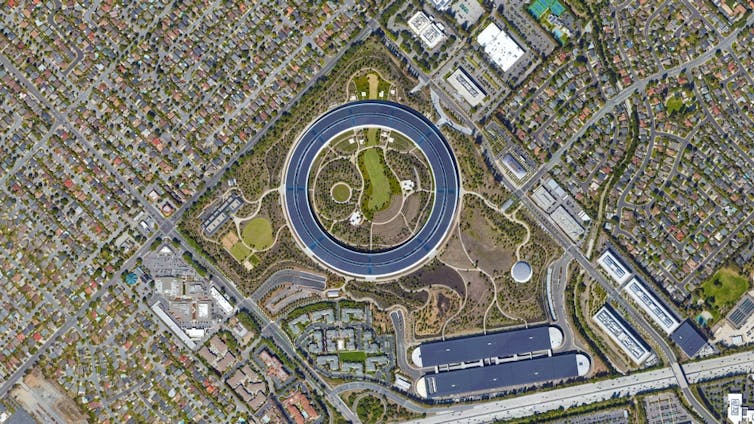
A Colonial Vision
We don’t have to look too deeply into history to find parallels to this kind of worldview. Simply put, it is the worldview of colonialism: it sees both nature and other people as domains to be conquered and exploited for “growth”.
Andreessen describes his mission in explicitly colonial terms: “mapping uncharted territory, conquering dragons, and bringing home the spoils for our community”. This is a worldview in which territories must be constantly expanded (“our descendants will live in the stars”) in a perpetual war for supremacy.
Technology has played an instrumental role in colonial conquest. Anthropologist Jared Diamond’s famous “guns, germs, and steel” were all technologies vital to the European conquest of the Americas. We might add to this list ships (including slave ships), navigation instruments, telegraphs, and so on.
Even the technologies of the industrial revolution – so important to the narrative of technological progress imagined by Andreessen and his ilk – were enabled by the availability and exploitation of cheap labour and markets in the Global South.
The mission of techno-optimists appears to be to pick up where the European and American empires of the 19th century left off, using technological, political and economic power to bully, coerce and bludgeon other societies into acquiescence.
For Andreessen, all this is supported, like colonialism, by a kind of social Darwinism. He sees an evolutionary war in which “smart people and smart societies outperform less smart ones on virtually every metric we can measure”.
Andreessen writes “technology doesn’t care about your ethnicity, race, religion, national origin, gender, sexuality, political views, height, weight, hair or lack thereof”. However, his talk of “America and her allies” and “our civilisation” suggests Andreessen himself cares quite a bit about these things. The West should, he implies, embrace its rightful place as the world’s technological (and civilisational) leader.

A Warning
All this reveals some of what Silicon Valley entrepreneurs really think of the rest of the world, and of us (non-techno-optimists).
We should take it as a warning about the kind of world that Silicon Valley technologists want. It will be a world built with technology, yes, but also a world that values power, force and wealth over all else.
Andreessen is right about one thing: we do need technology. We are unlikely to solve many of the problems facing our planet without it.
But the stripped-down, raw, blunt version of technology – a technology without ethics, without values, and without a conscience – is not the only way. Instead, we need to support technological innovation and at the same time support democratic participation, pluralism, ethics and our natural environment.![]()
Hallam Stevens, Professor of Interdisciplinary Studies, James Cook University
This article is republished from The Conversation under a Creative Commons license. Read the original article.
Almost 2 million Workforce Australia payments have been suspended in the past year, with devastating impact

Last year the federal government replaced the jobactive employment support program with what was expected to be a more flexible and improved support system for jobseekers, Workforce Australia.
Yet, in the 16 months the contracted-out system has been running, almost 2 million income support payments have been suspended, affecting 70% of participants.
Under the new system, participants must meet a points target to receive payments.
For example, if the default points target is 100 per month, this can be met by a minimum of four job applications (worth 5 points each) and a mix of other activities. Points targets are adjusted to 60 per month for parents and people with disabilities.
Why Are Payments Suspended?
Payment suspensions are supposed to get people to comply with requirements such as attending job interviews and undertaking training, education classes or other activities to reach their points target.
When these criteria are not met, participants are given a two-day grace period to resolve the problem, after which payments are automatically suspended. The suspension remains until the target is met or the suspension is lifted by a job service provider. The average suspension period is four days.
The figure of almost 2 million payment suspensions, cited at a Senate Estimates committee meeting last month, showed they have been occurring at an alarming rate since Workforce Australia started.

Committee member and Greens senator Janet Rice highlighted concern about the high suspension rate and representatives from the Department of Employment, which runs the program, agreed it was an issue.
If 70% of participants have been suspended, that makes it very likely some people have lost payments multiple times. These people might be long-term unemployed due to health, disability or discrimination in the workplace.
Suspending payments to these already disadvantaged groups has a devastating impact because income support payments are grossly inadequate. The single person rate of JobSeeker payment is only $749.20 per fortnight, and the maximum rate of Commonwealth rent assistance is $101.07, adding up to $860.27 a fortnight.
Meanwhile an average share house rent in a capital city like Melbourne is $446 per fortnight - with single renters often paying double - and this leaves people without much room for delays to their income support payments.
The Damage Caused By Suspending Payments
Research into the impact of payment suspensions on people’s mental health shows the consequences are dire.
This is especially so during the current cost-of-living crisis when people have enough to worry about just paying rent, buying food or keeping a car on the road.
The harm caused by suspending payments is apparent in my recent analysis of the individual submissions to the parliamentary inquiry into Workforce Australia.
I coded the frequency of words relating to poor psychological wellbeing as represented in the table. Of the 69 submissions reviewed, 52 identified how payment suspensions caused high levels of stress and affected trust of the job service provider.
The word-frequency results show threats to payments have a devastating effect on the mental health of people receiving unemployment payments. Many felt bullied by their job services providers.
The impact of suspensions is reflected in this quote from one of the submissions. As one 53-year-old woman said in her submission:
I would ask you to consider and recognise that those of us who are reliant on this system are deprived of any means to control our circumstances. A system failure, a missed phone call, a misunderstanding or a simple lack of communication can lead to a suspension of payments.
The stress associated with being constantly under threat by the whims of a particular person, system faults or even a missed phone call is immeasurable. That I might be unable to eat, go to the doctor, pay for medication, buy petrol, pay bills on time (so as not to incur further costs), pay for internet/phone … is considerable and has a massive impact for those of us who are living under these unfortunate circumstances.
It effects our physical and emotional health, our ability to participate in our communities, our sense of future and diminishes our sense of self-worth and our accomplishments – reducing them to meaninglessness while keeping us in poverty.
Why Is The Suspension Rate So High?
The suspension rate is high because the criteria people must meet to receive payments are unrealistic, and because job service providers make mistakes.
Some people can’t meet targets or report points under the points model on time, or don’t attend appointments because they’ve been given insufficient notice or the appointments have been scheduled at times they are already working or in training.
In a speech last month, Labor MP Julian Hill, who heads the parliamentary inquiry into Workforce Australia, told a conference the powers of the system’s providers to make decisions affecting payments was a “major false economy”.
This “false economy” of payment suspensions has been a fixture of job services requirements for nearly two decades.
Workforce Australia was meant to have addressed this with the points model. Instead, the points reporting is onerous and there is no evidence it improves the employment prospects of people who have been struggling to find work.
The Next Steps
When the parliamentary inquiry into Workforce Australia submits its report this month, it is likely to recommend big changes including returning and payment suspension decisions to the government’s former Human Services department, Services Australia.
If that happens, it will be vital to move swiftly.
As was the case with the former government’s highly discredited and unlawful automated debt assessment and recovery system, Robodebt, the widespread use of payment suspensions is unfair and causes acute distress to people already surviving on inadequate income support.![]()
Simone Casey, Research Associate, Centre for People, Organisation and Work, RMIT University
This article is republished from The Conversation under a Creative Commons license. Read the original article.
Do racehorses even know they’re ‘racing’ each other? It’s unlikely
Cathrynne Henshall, Charles Sturt UniversityWhen racing season arrives, everyone becomes an expert on the horses that are the stars of the spectacle.
TV personalities, professional pundits and form guides talk confidently about the favourite’s “will to win”. In close races, the equine contestants “battle it out”, demonstrating “heart”, “grit” and “determination”.
But do horses even know they are in a race, let alone have a desire to win it? Do they understand what it means when their nose is the first one to pass the post?
Based on decades of experience and everything we know about horse behaviour, I think the most plausible answer is “no”.
From The Horse’s Perspective
From a horse’s perspective, there are few intrinsic rewards for winning a race.
Reaching the end might mean relief from the pressure to keep galloping at high speed and hits from the jockey’s whip, but the same is true for all the horses once they pass the finishing post. If the race is close, the horse that eventually wins might even be whipped more often in the final stages than horses further back in the field.
So while being first to reach the winning post can be crucially important to the horse’s human connections, there is very little direct, intrinsic benefit to the horse that would motivate it to voluntarily gallop faster to achieve this outcome.
So does a horse even know it’s in a race? Again, the answer is likely “no”.
Running (cantering or galloping) is a quintessential horse behaviour and horses voluntarily run together in groups when given the opportunity – even in races without jockeys. However, there are a number of reasons to think horses have not evolved a desire to “win” during a group gallop.
Horses are social animals. In the wild, to minimise their individual exposure to predators, they synchronise their movement with other horses in their group.
This synchronisation includes maintaining similar speeds to other group members (to keep the group together), being alert to the positions of their own body and their neighbours’ to avoid collisions, and adapting their speed to the terrain and environmental cues that indicate upcoming danger or obstacles. In the wild, “winning” – that is, arriving first, long before other group members – could even be a negative, exposing the “winner” to an increased risk of predation.
This collective behaviour is the opposite of what owners, trainers and punters want from horses during a race.
The Horse’s Preferences (And How Riders Override Them)
Horse races depend on two horse-related factors: the horse’s innate tendency to synchronise with other horses, and its ability to be trained to ignore these tendencies in response to cues from the jockey during a race.
Trainers and jockeys also harness the preferences of individual horses. Some horses are averse to bunching up with others during the race, so jockeys let them move to the front of the field (these are “front runners”). Other horses seek the security of the group, so jockeys let them remain in the bunch until closer to the winning post (these are “come-from-behind” winners).
Jockeys use several different interventions to override the horse’s innate tendency to synchronise. These might include:
directing the horses to travel much closer to the other horses (risking the sometimes fatal injuries we sometimes see at the track)
travelling at speeds not of the horse’s choosing (usually at far higher speeds and for longer durations, and often maintained by use of the whip)
preventing the horse from changing course to adapt its position relative to other horses in the field (directing its path via pressure on the mouth from the bit or taps from the whip).
During the early stages of a race, jockeys rely on horses’ innate desire to remain with the group to ensure they maintain the physical effort required to keep in touch with the front runners. This tendency may then be overruled so the horse will act independently of the group, leave it behind and come to the front to hopefully win.
No Concept Of Being In A Race
So horses most likely have no concept of being in a “race”, where the goal of their galloping is to get to a certain location on the track before any of the other horses. However, they undoubtedly know what it’s like to be in a race. That is, they learn through prior experience and training what is likely to happen and what to do during a race.
And with jockeys and trainers who understand the individual preferences of their horses to maximise their chances during the race, there will always be one horse that reaches that part of the track designated the winning post before the other horses in the group.
But as for winning horses understanding they are there to “win”? It’s far more likely it is the combination of natural ability, physical fitness and jockey skill that accounts for which horse wins, rather than any innate desire by that horse to get to the winning post before the other horses.![]()
Cathrynne Henshall, Lecturer, School of Agricultural, Environmental and Veterinary Sciences, Charles Sturt University
This article is republished from The Conversation under a Creative Commons license. Read the original article.
The climate crisis is making gender inequality in developing coastal communities worse
Andi Misbahul Pratiwi, University of LeedsAcross the world, women and men experience the impacts of the climate crisis in different ways. These are shaped by societal roles and responsibilities and result in widening inequalities between men and women.
Sea-level rise, storm surges and high waves in coastal area do not discriminate, but societal structures often do. This makes climate change a highly gender-sensitive issue.
Research has long shown that coastal areas are the most directly affected by climate change. Small islands in Asia, central and South America and Africa – what many term “the global south” – are particularly vulnerable to land erosion and economic decline, amid livelihood losses in fisheries.
My doctoral research explores how in countries where women and girls already face disproportionate inequalities relating to ethnicity, class, age and education, the climate crisis is making things worse. In coastal areas, in particular, women and girls are ever more vulnerable.
Livelihoods Under Threat
In 2017, in collaboration with the Indonesian Feminist Journal, I conducted research off the coast of Demak in Java, Indonesia. I found that women in coastal communities faced multiple problems, from poverty and domestic and gender-based violence to employment challenges.
Fisherwomen who work at sea are having to sail further out and contend with difficult conditions to find catches. One woman, Zarokah, I interviewed had started fishing with her husband, two years earlier, when he could no longer find a crew to work with. They wake at 3am to head out to sea.
She told me a basket of tiny flying fish goes for 150,000 rupiah (£7.70) and a good haul will yield several baskets. But even when they don’t catch anything, they still have to cover the cost of supplies and equipment. This income is inadequate when faced with a situation where fish are becoming scarcer and extreme weather prevents them from going out to sea.
I have shown how women in this area and beyond have contributed significantly to the fishing sector and coastal economies. And yet, Masnu'ah, who is the founder of a local fisherwomen’s organisation, told me that women’s economic role continues to not be recognised by their male peers and society more broadly.
Zarokah is still labelled a “housewife” on her ID card, despite the fact that, as she put it, “If I don’t go, my husband doesn’t go either and we cannot meet our needs.”
If the fisherwomen do not receive recognition for their work, they are unable to access social protections including life insurance. As climate change increasingly threatens the profession at large, having state support and insurance is vital.
Access To Amenities And Healthcare
It’s not just women’s livelihoods in this area that are impacted by extreme weather and any other disruptions to the fishing industry. Tidal flooding has also made it difficult for women and girls to access healthcare facilities.
Women find it difficult to access clinics because the roads are closed and isolated. One activist in Demak told me about helping a woman give birth in the middle of a tidal flood – when the houses were sinking. “It was very difficult,” she said, “because the waves were high, there were no boats. The baby died two to three days after.”
Research from other regions in the world show a similar pattern of increasing vulnerability. In the south-western coastal region of Bangladesh, natural hazards, including storm surges and cyclones, have long affected women significantly. Of the 140,000 people killed in the 1991 cyclone disaster, 90% were women.
However, the impacts are broader than that. A recent study looked at women’s lives, particularly among the ethnic Munda community, in the Khulna, Satkhira and Bagerhat districts. It found that bad management of open-water sources (ponds and canals) has led to high water salinity. Women and girls, who are responsible for family provisions, have to walk up to 3km – and sometimes as far as 5km – to find drinking water.
They spend long hours carrying heavy water pots, which leads to chronic pain conditions. During droughts, this task can take over three hours daily. The women and girls also face harassment from boys and men while collecting the water.
A 2020 study in Ilaje, a coastal region in Nigeria, found that, there too, women and girls often bear the responsibility of ensuring there’s enough food, fuel and clean water available at home. During times of low rainfall or drought, they have to cover similarly long distances. Young girls sometimes have to leave school in order to help their mothers with these tasks.
Pregnant women in Ilaje, particularly, are vulnerable to health effects like malnutrition, dehydration, anemia, and other health risks related to low food and water availability during crises.
Due to prevailing patriarchal norms, Ilaje women lack the authority to make independent decisions within their families and in society. They don’t have control over financial matters and assets. And they are not given opportunities to participate in public spaces, in particular within community group discussions on climate change adaptation. As a result, they are unable to voice their specific concerns and needs – at both family and community levels.
Oceans and coastal ecosystems cover over two thirds of the planet. They play a crucial role in food and energy production as well as creating employment opportunities. About 600 million people – around 10% of the world’s population – reside in coastal areas that are less than 10 metres above sea level.
The central tenet of the UN’s 2030 agenda for sustainable development is to “leave no one behind”. Applying a feminist political lens to the climate crisis is crucial to understanding how multilayered the problems facing women and girls in rural and coastal regions around the world are.
Yet, social and feminist research on how the climate is changing has been scarce. Without it, women and girls will indeed be left behind.

Don’t have time to read about climate change as much as you’d like?
Get a weekly roundup in your inbox instead. Every Wednesday, The Conversation’s environment editor writes Imagine, a short email that goes a little deeper into just one climate issue. Join the 20,000+ readers who’ve subscribed so far.![]()
Andi Misbahul Pratiwi, PhD Candidate, School of Geography, University of Leeds
This article is republished from The Conversation under a Creative Commons license. Read the original article.
Disclaimer: These articles are not intended to provide medical advice, diagnosis or treatment. Views expressed here do not necessarily reflect those of Pittwater Online News or its staff.